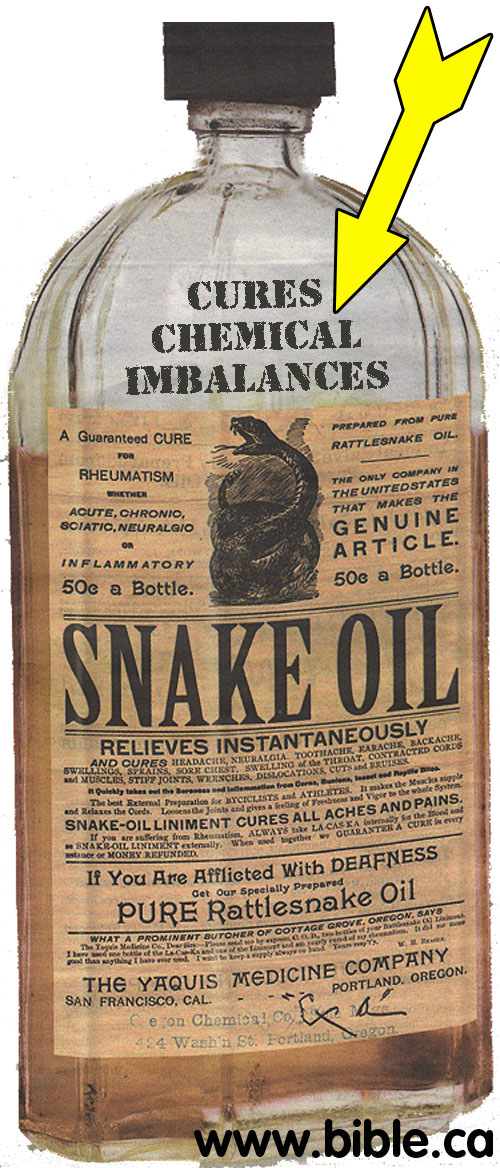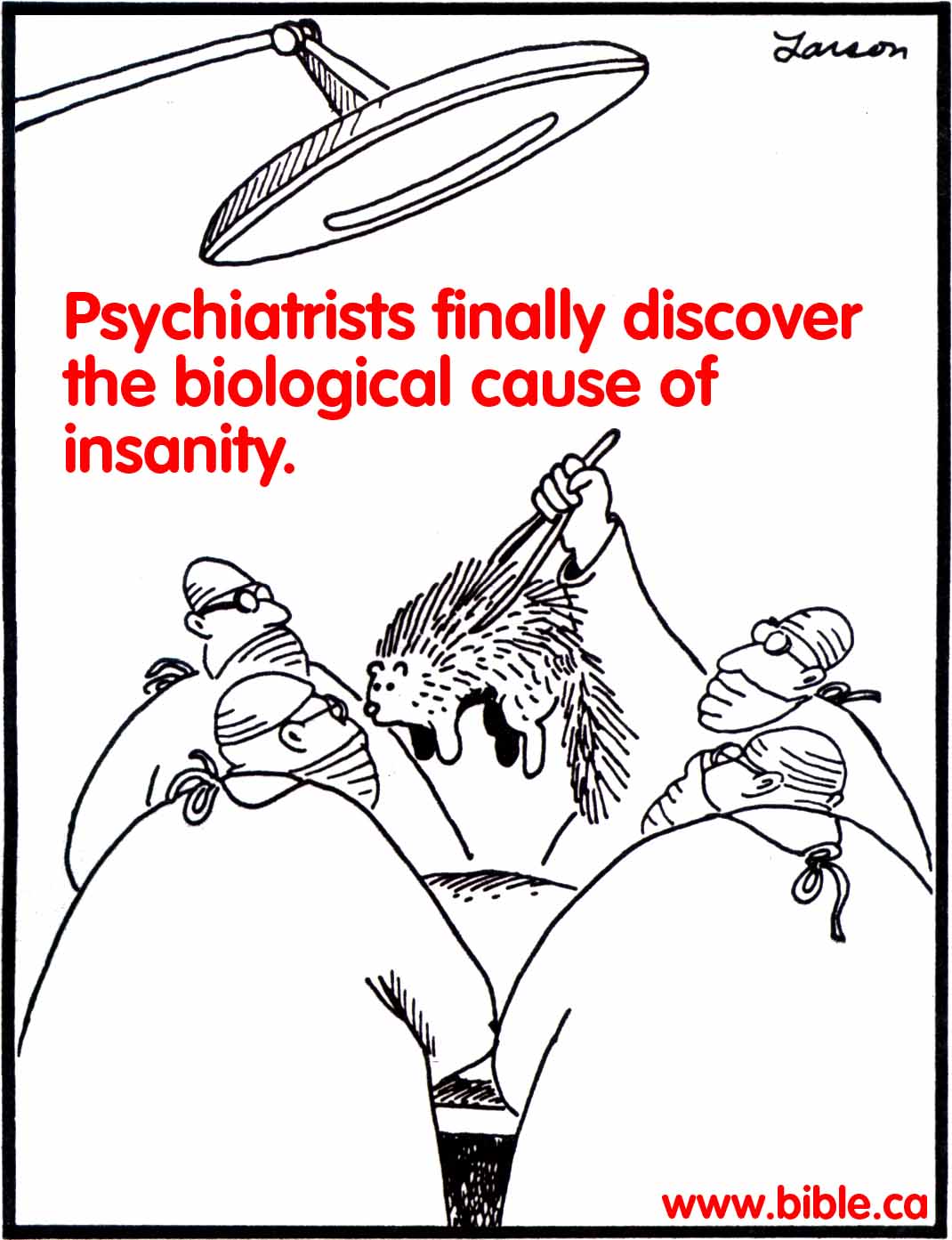Historical
overview of Psychiatry: 1550 BC - 2013 AD
This sequential overview of Psychiatry provides a brief, one
paragraph summary of the views of over 100 historic figures.
|
Encyclopedia of psychiatric history |
|||
|
|
|||
|
History of Psychiatry (Snake Oil? Yes! and its still that bad) |
|||
See also: Church ministers were first psychiatrists: Historically, the very first psychiatrists (lit: "doctors of the soul") were church ministers until a secular takeover by chemical psychiatrists forced Christians out of their God given role as councilors of people with behaviour problems using the Bible as their guide.
The
Main Exhibit:
History of Psychiatry:
1550 BC - 2013 AD:
1.
In 1550 BC, the Egyptians wrote a book of medicine. It is likely a
copy of a much older book, but it is quite fascinating to realize just how much
the ancients knew about the human body and various diseases. While the cures
were no better than a witches brew with "eye of newt", they did
understand the various diseases. The only reference to anything coming close to
psychiatry is in the section on the heart where anger and sadness are
discussed. Biopsychiatrists love to quote the papyrus as proof that the
Egyptians believed depression was caused by bodily diseases. But this is simply
untrue. In fact the opposite is true. The Egyptians understood that anger and
sadness caused body diseases in the heart. The papyrus reads: "When his
Heart is afflicted and has tasted sadness, behold his Heart is closed in and
darkness is in his body because of anger which is eating up his Heart." (The
Egyptian Medical Ebers Papyrus: 1550 BC)
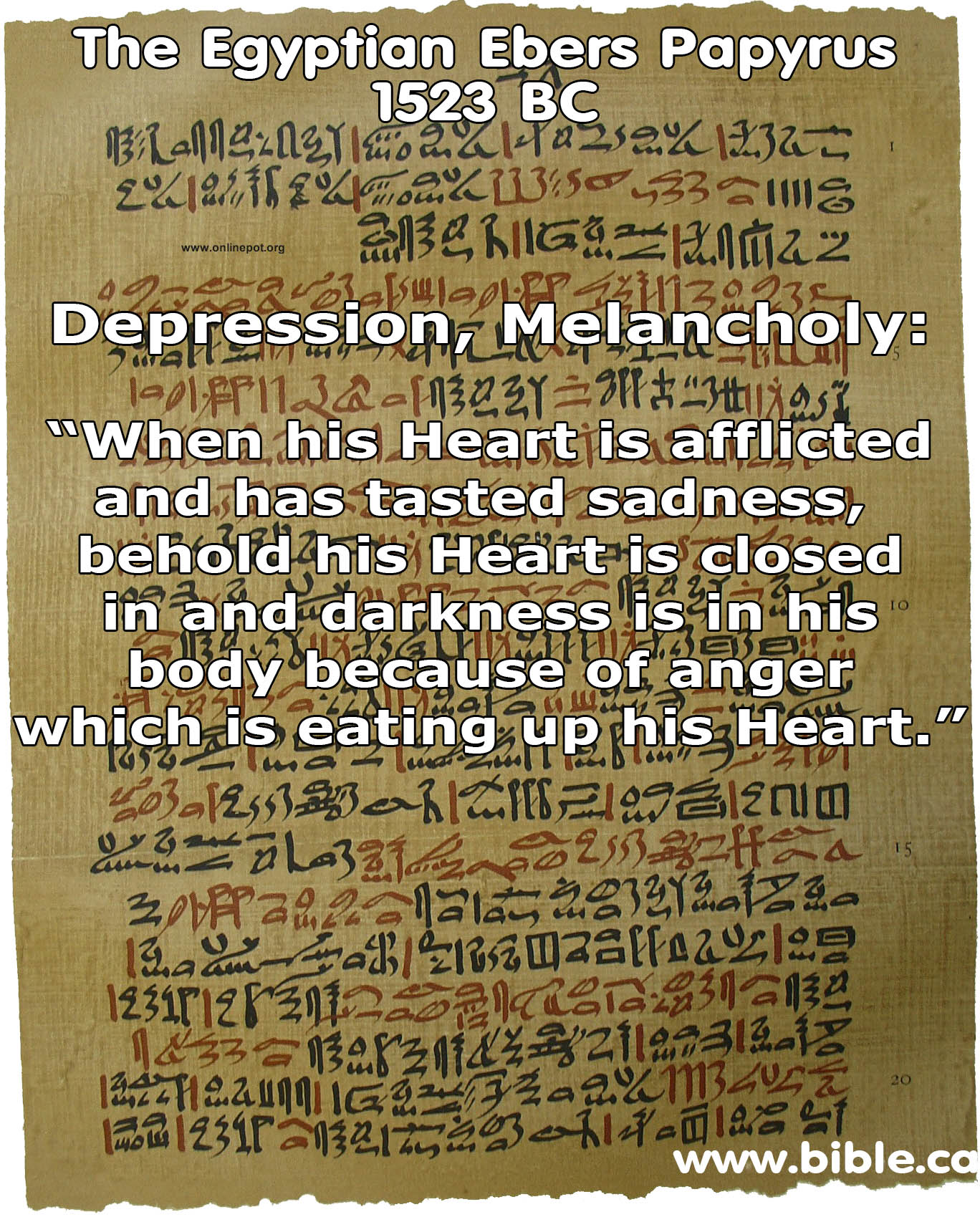
Jumping forward 3000 years…
- In 1558 AD, William
Bullein stated that rejection in love, coveting and greed are causes
of madness, and he clearly rejects madness as having a physical cause. We
all understand that "love sick" or "spring fever" are
not bodily diseases, but a spiritual choices of emotions we feel. Bullein
says that "talking" is the only hope a cure for insanity, not
drugs: "The syckenes of the body must have
medicine, the passions of the mind, must have good counsel. What pleasure
hath a condemned man in music, or a dead man in phisicke? Nothing at all
God knoweth. 'how many men have been caste away by thought, and most for
loss of estimation, and some of other affections of the mind, as
inordinate love, or coveting things that they can not gain, or obtaining
those things that they can not keep, or ire of men's prosperity or good
happy." (William Bullein, A
new book entitled the government of health, 1558 AD)

- In 1584 AD, Thomas Cogan viewed man as having both a body and a soul. He stated that the mind was not connected with the body, but the soul. However, he took the view that the mind can cause the body to get sick if a student studies endlessly in the night. This is exactly what the Bible says: "But beyond this, my son, be warned: the writing of many books is endless, and excessive devotion to books is wearying to the body." Ecclesiastes 12:12. He outlines that physical exercise is for the body and study is exercise of the mind. He warns that that the mind will be harmed by laziness and lack of use. "As man doeth consist of two partes, that is of bodie, and soule, so exercise is of two sortes, that is to say of the bodie and of the minde. Hitherto I have spoken of exercise of the bodie, nowe I will entreat of exercise of the minde, which is Study. ... The activity of the mind is never still. Idlenesse therefore is not onely against nature, but also dulleth the minde, as Ovid woorthily writeth: In addition the mind grows dull when harmed by long inactivity, and its ability is much less than it was before." So Cogan clearly believes that over use or under use of the mind can lead to physical illness. While this is not true, the fact remains that Thomas rejected the idea that insanity was something the body does to the mind. (The haven of health, Thomas Cogan, 1584 AD, p 12)
- In 1586 AD, Timothy Bright, doctor and priest, viewed that the spirit could make the body sick and the body could make the mind delusional. He focuses on how the mind causes the body to become melancholy and forbids the taking medicines as a cure. Instead Bright recommends only counsel to be the cure. "The dayly experience of phrensies, madnesse, lunasies, and melancholy cured by .. . art in that kinde, hath caused some to judge more basely of the soule... I have layd open howe the bodie, and corporall things affect the soule, & how the body is affected of it againe : what the difference is betwixt natural melancholie, and that heavy hande of God upon the afflicted conscience, tormented with remorse of sinne, & feare of his judgement. ... The mad man, of what kinde soever he be of, as truly concludeth of that which fantasie ministreth of conceit, as the wisest : onely therein lieth the abuse and defect, that the organicall parts which are ordained embassadours, & notaries unto the mind in these cases, falsisie the report, and deliver corrupt recordes. This is to be helped, as it shall be declared more at large hereafter, by counsell only sincerely ministred, which is free from the corruptions of those officers, and delivereth truth unto the mind, wherby it putteth in practise contrary to these importunate and furious sollicitors. ... Here it first proceedeth from the mindes apprehension: there from the humour, which deluding the organicall actions, abuseth the minde, and draweth it into erronious judgement, through false testimony of the outward reporte. Here no medicine, no purgation, no cordiall, no tryacle or balme are able to assure the afflicted soule and trembling heart, now panting under the terrors of God : there in melancholy the vain opened, neesing powder or bearefoote ministred, cordialls of pearle, Saphires, and rubies, with such like, recomforte the heart throwne downe, & appaled with fantasticall feare. In this affliction, the perill is not of body, and corporall actions, or decay of servile, and temporall uses, but of the whole nature soule and body cut of from the life of God, and from the sweet influence of his favour, the fountaine of all happines and eternall felicity." (A treatise of melancholie, Timothy Bright, 1586 AD)
- In 1603, William Shakespeare wrote a series of plays that
depicted insanity. In many of Shakespeare's plays, insanity plays a
central role. Shakespeare always provides a clear reason for the insanity
in each play: Lady Macbeth from guilt of murder. King Lear goes mad
because he is betrayed by his two daughters: "Blow, winds, and crack your cheeks; rage, blow. You cataracts and
hurricanoes, spout Till you have drench'd our steeples, drown'd the cocks.".
Hamlet goes insane after learning that his mother murdered his father. It
is never given a biologic cause and the insane are not dragged off against
their will to a mad house, because that was not the practice of the day,
and insanity was not viewed as something medical doctors could treat. Shakespeare
therefore, gives us a perfect window into history in 1600 AD and
understands that the only hope of cure for the insane rests solely within
themselves. Guilt from murder causes Lady Macbeth to go insane,
hallucinate blood on her hands that she cannot clean and suffer insomnia:
MACBETH: "Will all great Neptune's ocean wash
this blood Clean from my hand? No, this my hand will rather the
multitudinous seas incarnadine [flesh-colored], making the green one red."
(Macbeth: Act 2, Scene 2, 1603 AD) Later Macbeth calls for a doctor to
cure his wife of her insanity: MACBETH: "How does your patient,
doctor?" Doctor: "Not so sick, my lord,
As she is troubled with thick coming fancies, That keep her from her rest."
MACBETH: "Cure her of that. Canst thou not minister
to a mind diseased, Pluck from the memory a rooted sorrow, Raze out
the written troubles of the brain And with some sweet oblivious antidote
Cleanse the stuff'd bosom of that perilous stuff Which weighs upon the
heart?" Doctor: "Therein the patient
must minister to himself." MACBETH: "Throw physic
[medical treatments] to the dogs; I'll none of it." (Macbeth: Act 5,
Scene 3, 1603 AD) Notice that the doctor understood insanity was not a
bodily illness, refused to treat her, stated only she can cure herself,
and left her to live her life freely, though insane. This is exactly
opposite to what would happen today when the psychiatrist would claim only
he can treat her, lock her up in a mental hospital and treat her even it
if was against her will. Notice MacBeth demanded some "potion",
but the doctor knew non existed... exactly the same it true today.

- In 1605 AD, Francis Bacon believed that medical science was not helpful in understanding insanity. However Bacon did believe that the body could affect thinking and that the mind could affect the body: "Medicine is a Science, which hath been (as we have said) more professed, than labored, & yet more labored, than advanced; the labor having been, in my judgement, rather in circle, than in progression." He believed that insanity was something that occurred in the mind "affection" alone: "So in medicining of the Mind, after knowledge of the divers Characters of mens natures, it followeth in order to know the diseases and infirmities of the mind, which are no other then the perturbations & distempers of the affections ... Now Come we to those points which are within our own command and have force and operation upon the mind to affect the will & Appetite & to alter Manners: wherein they ought to have handled Custom, Exercise, Habit, Education, example, Imitation, Emulation, Company, Friends, praise, Reproof, exhortation, fame, laws, Books, studies : these as they have determinate use, in moralities, from these the mind suffereth, and of these are such receipts & Regiments compounded & described, as may seem to recover or preserve the health and Good estate of the mind, as far as pertaineth to humane Medycine." ... "So this league of mind and body, hath these two parts, How the one discloseth the other, and how the one worketh upon the other". (Advancement of Learning, Francis Bacon, 1605 AD)
- In 1608 AD, William Perkins believed that the Devil caused madness in people who were in a physically weakened melancholy state. The resulting actions that manifested madness were delusion, self deception, "conceits, and imaginary fancies". Insanity was caused partly from the devil's temptations and partly from the choices of the persons themselves. This was not demon possession, but demonic temptation that weak people yielded to. He stressed that madness was not caused by physical diseases, but spiritual choices. "This man hath a crazie braine, and is troubled with melancholy ... Witches of our times (say they) are aged persons, of weake braines, and troubled with abundance of melancholie, and the devill taketh advauntage of the humor, and so deludes them, perswading that they have made a league with him, when they have not, and consequently mooving them to imagine, that they doe, and may doe strange things, which indeed are done by himselfe, and not by them." (A discourse of the damned art of witchcraft, William Perkins, 1608 AD)
- In 1609 AD, John Downame
describes how anger, being a "disease of the
mind", has both a physiological effect on the body (red face,
high blood pressure, hair standing on end) but a spiritual effect on the
mind (loss of reason, wits). There are many case stories of people driven
to raving madness because of unchecked anger. Ephesians 4:26 says,
"Be angry, but to not sin; do not let the sun
go down on your anger." He states that the behaviour and
effects of shorts bursts of anger are identical to madness, except for the
length of time. His solution to anger to be silent or speak softly, is
taken straight from the Bible: "A gentle answer turns away wrath, But
a harsh word stirs up anger." Proverbs 15:1 "Like charcoal
to hot embers and wood to fire, So is a contentious man to kindle
strife." Proverbs 26:21. The final solution is to gently warn and
rebuke the person about the dangers anger will bring on his soul. Downame
clearly understood that anger had its origin in the mind, but that it
affected both mind and body. This was true. The Bible says that sin will
make you sick. (A
treatise of Anger, John Downame, 1609 AD)
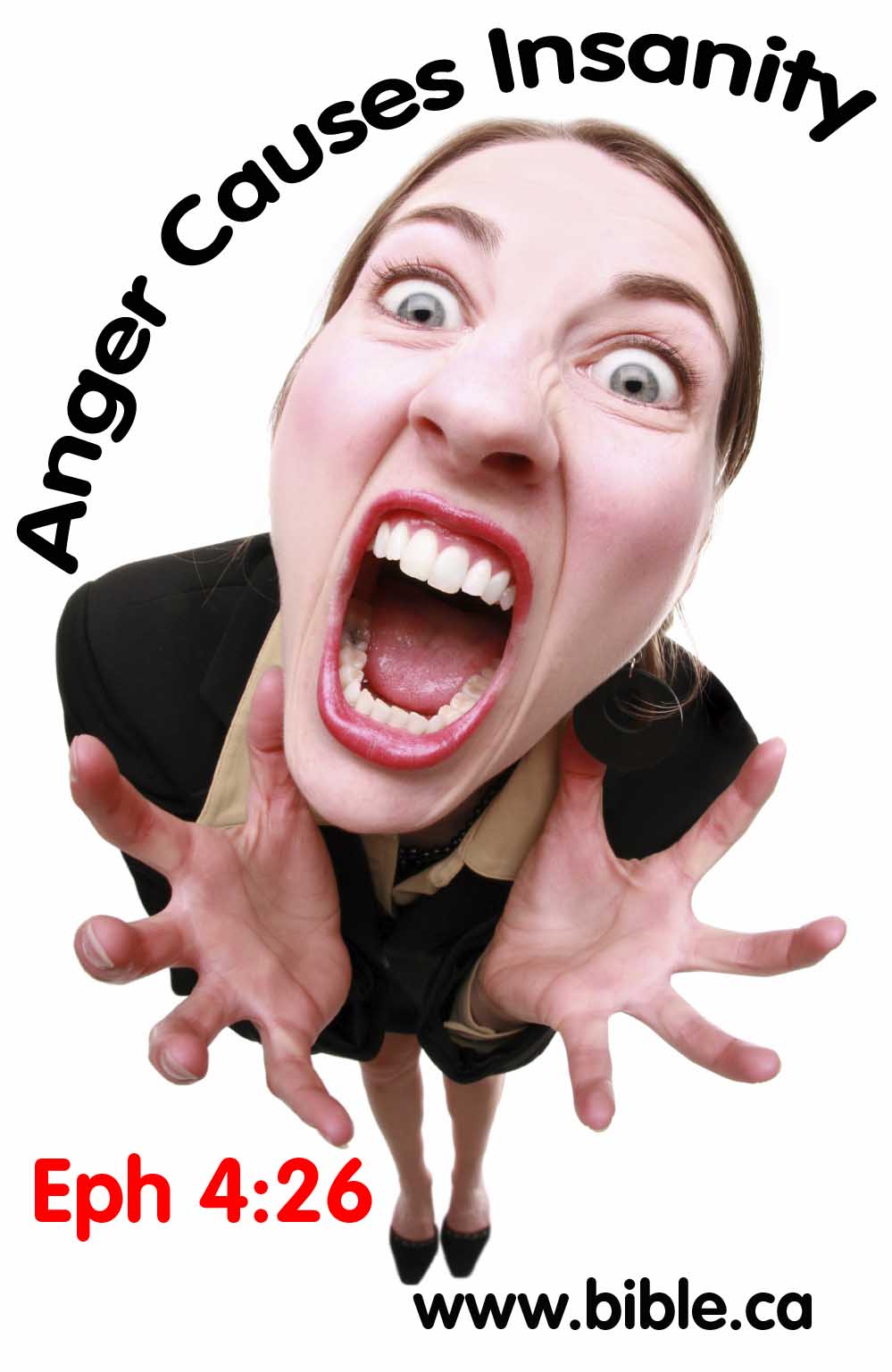
- In 1621 AD, Robert Burton wrote a book called The Anatomy Of Melancholy which described mental illness as caused by the mind which then in turn affects the brain, heart and other organs. He notes that different people handle common everyday life events in vastly different ways. The melancholy are unable to deal with these common life events without anxiety and loss of sleep: "In Disposition, is that transitory Melancholy, which goes and comes upon every small occasion of sorrow, need, sickness, trouble, fear, grief, passion, or perturbation of the Mind, or any manner of care, discontent, or thought, which causeth anguish and vexation of the Spirits, any ways opposite to pleasure, mirth, joy, delight, or causing frowardnesse in us, or a dislike. ... For that which is but as a flea-biting to one, cause unsufferable torment to another, and that which one by his singular moderation, and well-composed carriage can happily overcome, a second is no whit able to sustain : but upon every small occasion of grief, disgrace, loss, cross, rumor, &c. yields so far to passion, that his complexion is altered, his digestion hindred, his sleep gone, his spirits obscured, and his heart heavy, his Hypocondries missaffected, wind, crudity on a sudden overtake him, and he himself overcome with Melancholy." Burton shows that madness is caused by the mind, not the body: "but forasmuch as this malady is caused by precedent Imagination, and the Appetite, to whom Spirits obey, are subject to those principall parts, the Braine must needs be primarily misaffected, as the seate of Reason, and then the Heart, as the seate of Affection". Burton believed that the devil began deceiving the mind of those who were predisposed to melancholy and affected both mind and body. Burton correctly rejects the concept of demon possession causing insanity, but his view of the devil being like a "lion seeking someone to devour" is clearly biblical. This is quite different from demon possession. "Many think he can worke upon the body, but not upon the minde. But experience pronounceth otherwise, that he can work both upon body and mind . . . He begins first with the phantasie, and moves that so strongly that no reason is able to resist. Now the Phantasie he moves by mediation of humors : Although many Physitians are of opinion that the Devil can alter the minde, and produce this disease of himselfe .. . Agrippa and Lavater are perswaded that this humour invites the Divell to it, wheresoever it is in extremity, and of all other Melancholy persons are most subject to diabolical temptations, and illusions, and most apt to entertain them and the Devil best able to work upon them." Burton further states that mental illness happens in family groups and is hereditary. He notes that it is not the physical body that transmits the disease, but the manner, personality, temperament of the mind. It is clear that through all ages mental illness runs in families. But so does religion. Just as religion can be learned so too mental illness: "it being an hereditary disease : for as he justices . . . Such as the temperature of the father is, such is the sons; and look what disease the father had when he begot him, such his son will have after him . . . Now this doth not so much appear in the composition of the Body . . . but in manners and conditions of the Mind". Burton shows that the etiology of mental illness is upbringing. If parents are too harsh "Fathers, do not exasperate your children, so that they will not lose heart" Col 3:21 or mothers who are too permissive "He who withholds his rod hates his son, But he who loves him disciplines him diligently." Proverbs 13:24. "Education of these accidental causes of melancholy, may justly challenge the next place : for if a man escape a bad Nurse, he may be undone by evil bringing up. Jason Pratensis, puts this of Education for a principal cause, bad parents, step-mothers, Tutors, Masters, Teachers, too rigorous and too severe, Of too remiss or indulgent on the other side, are often fountains and furthers of this disease. Parents and such as have the tuition and oversight of children, offend many times in that they are too stern, alway threatning, chiding, brawling, whipping, or striking; by meanes of which their poore children are so disheartned & cowed that they never after have any courage, or a merry houre in their lives, or take pleasure in any thing .. Others againe in that other extreame doe as much harme . . . Too much indulgence causeth the like, many fond mothers especially, dote so much upon their children like Aesops ape, till in the end they crush them to death." Remarkably, Burton identifies hypochondria and paranoia as two key indicators of mental illness. "Some are afraid that they shall have every fearefull disease they see others have, heare of, or read. If they see one possessed, bewitch't, or an Epileptick Paroxisme, a man shaking with the palsy, or giddy-headed, reeling, or standing in a dangerous place &c. for many dayes after it runs in their mindes, they are afraid they shal be so too, they are in the like danger .. . they applie all they see, heare, read, to themselves . . . and will be sick, and apply all symptomes they find related of others, to their owne persons" ... Paranoia: "If two talke together and whisper, or jest, or tell a tale in generall, he thinks presently they meane him, applies all to himselfe . . . Or if they talk with him, he is ready to misconstrue every word they speak, and interpret it to the worst . . . He thinks they laugh or point at him, or doe it in disgrace of him, circumvent him, condemn him" It is easy to see why Burton's book was a standard text that was widely distributed over two centuries. (The Anatomy Of Melancholy, Robert Burton, 1621 AD)
- In 1633 AD, John Hawkins wrote a book called Hypochondriac Melancholy where he identified anxiety, panic attacks and sleeplessness in Queen Elizabeth of Bohemia that had no biological cause. To Hawkins, it was all in the mind... and he was right! Neither the queen or modern chemical psychiatrists would be amused! (Hypochondriac Melancholy, John Hawkins, 1633 AD)
- In 1636 AD, Richard Sibbs was a preacher whose views were typical of his day, that mental illness was a spiritual problem that needed a spiritual solution: "a diseases of the soul". The very title of the book says it all! Sibbs viewed that insanity was caused by an inner conflict and cured only by faith in Christ! He recognizes the conflict between good and bad conduct and how the conscience can bring turmoil to the spirit and also physical illness to the body. He echos the battle between the spirit and the flesh in Romans 7:24. "Now the reason why imagination workes so upon the soule, is, because it stirres up the affections answerable to the good or ill which it apprehends, and our affections stir the humors of the body, so that oftentimes both our souls and bodies are troubled hereby." He shows how insanity affects those with bad conscience because of sinful conduct and how a Christian is better equipped to work through common problems without become mad. This is the comfort of a holy man, that though he be troubled with himself, yet by reason of the spirit in him which is his better self, he works out by degrees, what ever is contrary . . . Hee that is at peace in himself, will be peaceable to others, peaceable in his family, peaceable in the Church, peaceable in the State; The soul of a wicked man is in perpetual) sedition; being always troubled in it self, it is no wonder if it be troublesome to others. Unity in our selves is before unity with others." Sibbs gives an exact etiology of one kind of mental illness where cognitive dissonance (bad conscience form sinful conduct) affects first the mind, then the body. "Things work upon the soul in this order. 1. Some object is presented. 2. Then it is apprehended by imagination as good and pleasing, or as evil and hurtful. 3. If good, the desire is carried to it with delight : if evil, it is rejected with distant, and so our affections are stirred up suitably to our apprehension of the object. 4. Affections stir up the spirits. 5. The spirits raise the humours, and so the whole man becomes moved and oftentimes distempered; this falleth out by reason of the Sympathy between the soul and body, whereby what offendeth one redoundeth to the hurt of the other." He also says that hypochondria is beyond dispute because of how clear it was that people became insane over the mere worry of contracting and dying from the plague, which was seen as a judgement of God upon people's sins. "I need bring no Examples for proof: for in every place I hear living witnesses of such as died of the Plague, stricken only with the fear of it". (The Souls Conflict, Richard Sibbs, 1635 AD)
- In 1640 AD, Edward Reynolds, a preacher for a church, correctly rejected the quack medical opinions and practices of his day: that mental illness was of physical origin. He correctly saw that "melancholy blood" did not cause mental illness. Today chemical psychiatrists continue this deception by prescribing drugs to the mentally ill because of a "chemical imbalance" in the brain. Doctors of the 17th century and the chemical psychiatrists of today are both wrong in saying the body makes one insane. Instead, they should listen to Edward Reynolds, who correctly showed the etiology of insanity to be entirely the result of spiritual choices and how the guilt from sinful conduct affected both the mind and the body. He illustrates in several ways how a man must exercise self control to keep his sex drive and other passions under control. This has nothing in common with Freud, since Reynolds believed that the conscious freewill of a man choosing to overcome sin, is the best way to cure mental illness. "as Husbandmen use to do those Trees which are crooked . . . or else it is done, by scattering and distracting of them; and that not only by the power of Reason, but sometimes also by a cautelous admixture of Passions amongst themselves, thereby interrupting their free current". To Reynolds, a man who is mentally ill is like a crooked tree that needs to be corrected by pruning and staking of the farmer. Of course the primary one to do this staking and pruning was the person themselves, to themselves! To Reynolds, the Bible command to "flee fornication" was achieved by power of will and self control. He also recommended people avoid such sinful sexual activity and to replace such thoughts with positive wholesome things as a kind of "minds decoy" to get your thoughts off of sex. When your mother told you to take cold shower and read the Bible because you were "horny", this is exactly the kind of thing Reynolds would advise. (A Treatise of the Passions and Faculties of the Soul of Man, Edward Reynolds, 1640 AD)
- In 1649 AD, William Harvey discovered the blood circulatory system of the body. He notes that the mind, spirit and emotion cause physical changes in the body, sometimes causing death. "And what indeed is more deserving of attention than the fact that in almost every affection, appetite, hope or fear, our body suffers, the countenance changes, and the blood appears to course hither and thither. In anger the eyes are fiery and pupils contracted; in modesty the cheeks are suffused with blushes; in fear, and under a sense of infamy and of shame, the face is pale, but the ears burn as if for the evil they heard or were to hear; in lust how quickly is the member [penis] distended with blood and erected!" He gives a case story of a man who overcome with anger, hate and revenge, died: "I was acquainted with another strong man, who having received an injury and affront from one more powerful than himself, and upon whom he could not have his revenge, was so overcome with hatred and spite and passion, which he yet communicated to no one, that at last he fell into a strange distemper, suffering from extreme oppression and pain of the heart and breast, and . . . in the course of a few years . . . became tabid and died". Of course this is nothing new. Modern science recognizes how stress can cause heart attacks and drive one to insanity. However, the doctor contributed to the myth of hysteria by blaming the uterus for inducing insanity. Modern psychiatry retained hysteria until it was replaced in the first edition of the DSM-I in 1952 with "conversion reaction" and "somatization disorder." Here we have it's beginning stages of development by the myth that human females, like animals, go insane if they do not get sex when they need it: "All animals, indeed, grow savage when in heat, and unless they are suffered to enjoy one another, become changed in disposition. In like manner women occasionally become insane through ungratified desire, and to such a height does the malady reach in some, that they are believed to be poisoned, or moonstruck, or possessed by a devil." Equally quaky, is the idea that a woman who is suffering from "hysteria" needs to do "Hymeneal Exercises", whatever that is, or just get a husband to get enough sex to cure her mental illness: "That this Maid having remained a great while in the Hospital without being cured, Dr. Harvey, out of Curiosity, visited her sometimes; and suspecting her strange Distemper to be chiefly Uterine, and curable only by Hymeneal Exercises, he advised her Parents (who sent her not thither out of poverty) to take her home, and provide her a Husband, by whom, in effect, she was according to his Prognostic, and to many Men's wonder, cured of that strange Disease." (Blood Circulation in the body (Exercitatio anatomica de circulatione sanguinis), William Harvey, 1649 AD)
- In 1650 AD, Rene Descartes described the body as a machine that was inhabited by a spirit, where intelligence, memory and personality originate. "Cartesian Dualism" is Christian theology. Chemical psychiatry, including the DSM-IV like to mislead the untaught by suggesting first, that this idea was something new, and second, that Descartes thought the pineal gland was the soul. In fact, Descartes' view was standard Judeo-Christian theology 101. Eccl 12:7 shows that the body returns to dust and the spirit returns to God who gave it. Jesus story of the Rich man and Lazarus in Luke 16:21 clearly show that personality, memory, thoughts, feelings etc, consciously survive the death of the body while awaiting the second coming and resurrection. When this is pointed out, psychiatrists will then come clean (a bit) and say that Plato thought the same thing. They almost always fail to point out that "Cartesian Dualism" is really a primary Hebrew and Christian theology. Even worse, Chemical psychiatry fails to note that every historic culture on earth believed in "Cartesian Dualism" including the ancient Egyptians, Semites, Chinese and all world religions including Buddhism, Hinduism and that late-bloomer, Islam. It is important to note that Descartes did not say that the pineal gland was the soul, just that the soul used the pineal gland as its physical connection to the body. "That there is a little kernell in the brain wherein the soul exercises her functions more peculiarly than in the other parts ... all the other parts of our brain are paired ... but there is no other place in the body where they can be so united, unless it be granted that they are in this kernel ... Let us then conceive that the Soul holds her principal seat in that little kernel in the midst of the brain, from whence she diffuseth her beams into all the rest of the body" Chemical psychiatry laughs at the idea that the pineal gland IS THE SOUL and mockingly asks Christians, "where does the soul go when the brain is destroyed?" Apart from being stupid, it is a deliberate misrepresentation of what Descartes said. Further, since Christian know that the spirit uses the brain as a way of connecting with the body, perhaps scientists should devote a bit of research money to this hypothesis. While the soul might use the pineal gland alone, as its interface connection with the body, we reject this, however, and feel that the soul uses the entire brain as its connection device/port with the body. fMRI imaging shows that the entire brain is used in thoughts and emotions. When the body dies and the brain is destroyed, the soul detaches from the brain, which then turns to dust. Death is the separation of the body from the soul in the Bible. Descartes was in fact, voicing the majority view for his time. It was not until the 1900's that psychiatry rejected Christianity for the idea that man is nothing but a pile of chemicals. (The passions of the soul, Rene Descartes, 1650 AD)
- In 1656 AD, Henry
More described those who hear voices as self deluded with their own
conceited imaginations. If alive today, he would never attribute the
cause of such schizophrenia to a malfunctioning brain with some mythical
chemical imbalance. Neuroscience
has proven through fMRI
imaging, that when people "hear voices" that the talking
sections of the brain "Broca's area" light up, not the hearing.
Henry More correctly understood that the spirit and its imaginations were
the etiology of delusion, not the body! Hearing the voice of God or an
angel was known right up to the 19th century as "Enthusiasm" "For Enthusiasm is nothing else but a misconceit
of being inspired ... The Origin of such peremptory delusions as mankind
are obnoxious to, is the enormous strength and vigour of the
Imagination". More believed in the inspiration of the Bible
and that God, angels and the devil talk to men, but he was able to easily
know the difference between the real thing and self delusion. Notice the
key words he uses over again: conceit (narcissism and selfishness),
fooled, deceived, imagination, believing a lie, carnal reasoning,
delusions. "And a further instance may be in
mad or Melancholy men, who have confidently affirmed that they have met
with the Devil, or conversed with Angels, when it has been nothing but an
encounter with their own fancy. Wherefore
it is the enormous strength of Imagination . . . that thus peremptorily
engages a man to believe a lie." More correctly understood
that schizophrenics were in their own created fantasy world that blurred
with the real world. Even dreams while sleeping became reality. "for he takes his dreams for true Histories and real
Transactions ... We shall now enquire into the Causes of this Distemper,
how it comes to passe that man should be thus be fooled in his own conceit
... she has quite lost her own judgement and freedom, and can neither keep
out nor distinguish betwixt her own fancies and real truths."
More understood that these self deluded people, prided their own judgement
to be superior to all outside rational thinking. "as in the case immediately before named, does naturally
bear down the Soul into a belief of the truth and existence of what she
thus vigorously apprehend; and being so wholly and entirely immersed in
this conceit, and so vehemently touched therewith, she has either not the
patience to consider any thing alledged against it, or if she do consider
and find her self intangled, she will look upon it as a piece of humane
sophistry, and prefer her own infallibility or the infallibility of the
Spirit before all carnall reasonings whatsoever". More viewed
these people as self deluded in their spirits not physically sick in their
bodies. (Discourse
of the Nature, Causes, Kinds, and Cure, of Enthusiasm (Enthusiasmus triumphatus),
Henry More, 1656 AD)

- In 1660 AD, Jeremy Taylor, Bishop, used the term "scruples" to describe people who were insane. He rejected the idea that the body was the etiology and placed the origin squarely and firmly in the mind: "A scruple is a great trouble of mind proceeding from a little motive, and a great indisposition, by which the conscience though sufficiently determined by proper arguments, dares not proceed to action, or if it doe, it cannot rest . . . That it is a great trouble, is a daily experiment and a sad sight : Some persons dare not eat for fear of gluttony, they fear that they shall sleep too much, and that keeps them waking, and troubles their heads more, and then their scruples increase. If they be single persons, they fear that every temptation is a . . . burning which the Apostle so carefully would have us to avoid, and then that it is better to marry then to suffer it; and if they think to marry, they dare not for fear they be accounted neglecters of the glory of God which they think is better promoted by not touching a woman." He clearly identified this as a conflict of conscious whose origin is the mind not the body. They also confess to sins in order to be told they are ok. This is an common attention getting advice like when you put yourself down in order to get a compliment. Basically, it is a narcissistic way of getting others to praise and take notice of how spiritual you are! "They repent when they have not sinned, and accuse themselves without form or matter". This often occurs in Christians who secretly sin, then attempt to make up for it with good works. Generally people who behave this way have indeed committed some secret sin (usually sexual) and their conscience is rightly bothering them. "After a great tumbling of thoughts and sorrows he begins to believe that this scrupulousness of conscience is a temptation, and a punishment of his sins, and then he heaps up all that ever he did, and all that he did not, and all that he might have done, and seeking for remedy grows infinitely worse, till God at last pitying the innocence and trouble of the man made the evil to sink down with its own weight, and like a sorrow that breaks the sleep, at last growing big, loads the spirits, and bringing back the sleep that it had driven away, cures it self by the greatness of its own affliction." Rather than just stop sinning and repenting openly, they chose to continue sinning thus incurring the pains of cognitive dissonance. Taylor understood the solution was in the mind, not the body! (The Rule of Conscience (Ductor dubitantium), Jeremy Taylor, 1660 AD)
- In 1665 AD, Dr. William
Drage concluded that he had witnessed several cases of demon
possession in a couple of women. In fact, Mary Hall was faking the whole thing
(hysteria) for attention because she did not like the way she was being
treated by her father. However, Drage correctly notes that this is not a
bodily illness, but a spiritual one: "A
Disease of Witchcraft is a Sickness that arises from strange and preternatural
Causes . . . afflicting with strange and unaccustomed Symptoms, and
commonly preternaturally violent, very seldom or not at all curable by
Ordinary and Natural Remedies." It is best to view this as a
comedy act put on by Mary Hall who was supposed possessed by two demons.
Only then, do you realize how much fun she was having putting on her show
and getting all kinds of attention. Typical of hysterics, the curtain
rises on Act 1, and Mary Hall starts "the old shaking foot
trick"! "It took her first in one
foot with a trembling shaking and Convulsive motion, afterwards it
possessed both; she would sit stamping very much; she had sometimes like
Epileptick, sometimes like Convulsive sits, and strange ejaculations".
When that was enough to convince them to call in the excorcist, (Doctor
Woodhouse) Mary Hall had to start writing some new material quickly... and
she should be awarded a Grammy award posthumously. "were heard in her [Mary Hall] strange noises, like
mewing of Cats, barking of Dogs, roaring of Bears, &c. at last a Voice
spoke in her, "Pus Cat, what a Cat? nothing but me!" ...
Mary later told revealed the true reason Mary Hall was unhappy: She wanted
to Choke her father! This was all about a daughter's anger and/or
rebellion against her father! He may have been unfair to her, or perhaps
it was just a bit of teenage rebellion! The curtain open in Act 2: "We are only two little Imps, Goodwife' Harods, and
Youngs; sometimes we are in the shape of Serpents, sometimes of Flies,
sometimes of Rats or Mice; and Gfe Harod sent us to choke this Maid, Mary
Hall; but we should have choked Goodman
Hall, but of him we had no Power, and so possessed his daughter; we came down the Chimney, riding on a stick, and went
first to Mary's foot, whereupon her foot trembled first of all her
distemper."
 The
obvious tip off is that demons do not ride on broom sticks, being a 17th
century concept alone. Demons are supernatural beings. Acts 3: "Sometimes she would beat her self, sometimes with one,
sometimes both hands, chiefly on the Breast. Sometimes her legs would go,
fast and violently, kicking of the ground, and the Spirits would say,
Come, Mary, Dance; and then they would make a tune, and make her feet to
Dance it; sometimes they would say, Mary, make a mouth; and then they
convulsed her mouth." Doctor Woodhouse, and two other doctors
were deceived by Mary Hall's new found acting career and concluded she was
demon possessed: "he really thought she was
possessed". Had Woodhouse merely broken out in laughter, he
would have likely cured Mary Hall instantly of her "demon
possession". It is crystal clear that it was Mary, not the demon, who
wanted to "choke Goodman Hall",
her father. Mary Hall was spanking her father through the demon. There are
countless examples of this sad, but typical case of faking insanity today.
The story
of Sybil is yet a modern case of a bored woman, trying to get her
acting career off the ground! Perhaps she knew about Mary Hall. We refer
you to the case of "Joe", the jail
house demoniac who fooled all the psychiatrists, but not the church
preacher! (Daimonomageia.
A small treatise of sicknesses and diseases from witchcraft, William
Drage, 1665 AD)
The
obvious tip off is that demons do not ride on broom sticks, being a 17th
century concept alone. Demons are supernatural beings. Acts 3: "Sometimes she would beat her self, sometimes with one,
sometimes both hands, chiefly on the Breast. Sometimes her legs would go,
fast and violently, kicking of the ground, and the Spirits would say,
Come, Mary, Dance; and then they would make a tune, and make her feet to
Dance it; sometimes they would say, Mary, make a mouth; and then they
convulsed her mouth." Doctor Woodhouse, and two other doctors
were deceived by Mary Hall's new found acting career and concluded she was
demon possessed: "he really thought she was
possessed". Had Woodhouse merely broken out in laughter, he
would have likely cured Mary Hall instantly of her "demon
possession". It is crystal clear that it was Mary, not the demon, who
wanted to "choke Goodman Hall",
her father. Mary Hall was spanking her father through the demon. There are
countless examples of this sad, but typical case of faking insanity today.
The story
of Sybil is yet a modern case of a bored woman, trying to get her
acting career off the ground! Perhaps she knew about Mary Hall. We refer
you to the case of "Joe", the jail
house demoniac who fooled all the psychiatrists, but not the church
preacher! (Daimonomageia.
A small treatise of sicknesses and diseases from witchcraft, William
Drage, 1665 AD)
|
Here is a video of Mary Audrey with her "left Leg anointing" like Mary Hall's demon possessed left foot. John Arnott, a Pentecostal, stands beside his ministry director, Mary Audrey, who has the "Left Leg Anointing". When she kicks up her left leg, and says, "More Jesus", people are slain in the Spirit in the direction of her kick. |
- In 1667 AD, Thomas
Willis clearly understood that madness was a spiritual problem to be
cured with torture. His statement says it all: "Wherefore, Furious Mad-men are sooner, and more
certainly cured by punishments, and hard usage, in a strait room, than by
Physick or Medicines." If insanity was really a chemical
imbalance, these "moral treatments" would have no effect: "Therefore let the diet be slender and not delicate,
their clothing course, their beds hard, and their handling severe and
rigid. ... The first Indication, viz.
Curatory, requires threatening, bonds, or strokes, as well as Physick. For
the Mad-man being placed in a House for the business, must be so handled
both by the Physician, and also by the Servants that are prudent, that he
may be in some manner kept in, either by warnings, chiding, or punishments
inflicted on him, to his duty, or his behaviour, or manners. And indeed
for the curing of Mad people, there is nothing more effectual or necessary
than their reverence or standing in awe of such as they think their
Tormentors. For by this means, the Corporeal Soul being in some measure
depressed and restrained, is compell'd to remit its pride and fierceness;
and so afterwards by degrees grows more mild, and returns in order:
Wherefore, Furious Mad-men are sooner, and more certainly cured by
punishments, and hard usage, in a strait room, than by Physick or
Medicines." Willis is one of the earliest doctors connected
with Bedlam,
to recommend torture as a cure for insanity. Willis saw the main cause of madness
as being rooted in the mind not the body and his cures reflected that
view: "Therefore, for the healing of the
Spirits, first of all it is to be procured that the Soul should be
withdrawn from all troublesome and restraining passion, viz. from mad Love,
Jealousy, Sorrow, Pity, Hatred, Fear, and the like, and composed to
cheerfulness or joy: pleasant talk, or jesting, Singing, Music, Pictures,
Dancing, Hunting, Fishing and other pleasant Exercises are to be used.
They who are not for Sports or Pleasures (for to some Melancholicks they
are always ungrateful) are to be roused up by employing them in more light
business; sometimes Mathematical or Chemical Studies, also Travelling, do
very much help; moreover, it is often expedient to change the places of
habitation, in their native soil. Those who will still stay at home, are
to be warned, that they take care of their Household affairs"
However, Willis one of the first to understand the nervous system. He
therefore believed that moral choices could have an effect upon the
nervous system, which in turn caused insanity. The idea that the mind
could make the body sick and induce madness was not a new idea. But his
etiology of madness rooted in the nervous system was new. His theory that
bad moral choices caused bad nerves in the brain became the dominant view
in the Bedlam mental hospital in England. 100 years later, William
Battie, for example, induced vomiting in the insane in order to
physically shock the nerves as a cure! Today we know Willis and Battie
were quacks, since that nerves and brain tissue of schizophrenics are in
perfect working order. Today, chemical psychiatrists still cling to a
vestigial root of Willis' quacky ideas. It is seen in the modern mythical
concept that chemical imbalances in the brain cause mental illness.
Today, it appears very scientific to suggest insanity is caused by
chemical imbalances, but like Willis' bad nerves, there is no scientific
proof of either! While Willis correctly rejected the common idea of his
day, that a woman's uterus caused hysteria, he made the mistake of blaming
the brain instead! Interesting that Willis diagnosed both men and women
with "hysteria"
the same way men are diagnosed with postpartum
depression today. Its all pure junk science! "Having weighed these, and other Reasons, we doubt not to
assert, the Passions commonly called Hysterical, to arise most often, from
that the animal spirits, possessing the beginning of the Nerves within the
head, are infected with some taint." (Pathology
of the Brain and Nervous Stock, Soul of Brutes, Thomas Willis, 1667
AD)
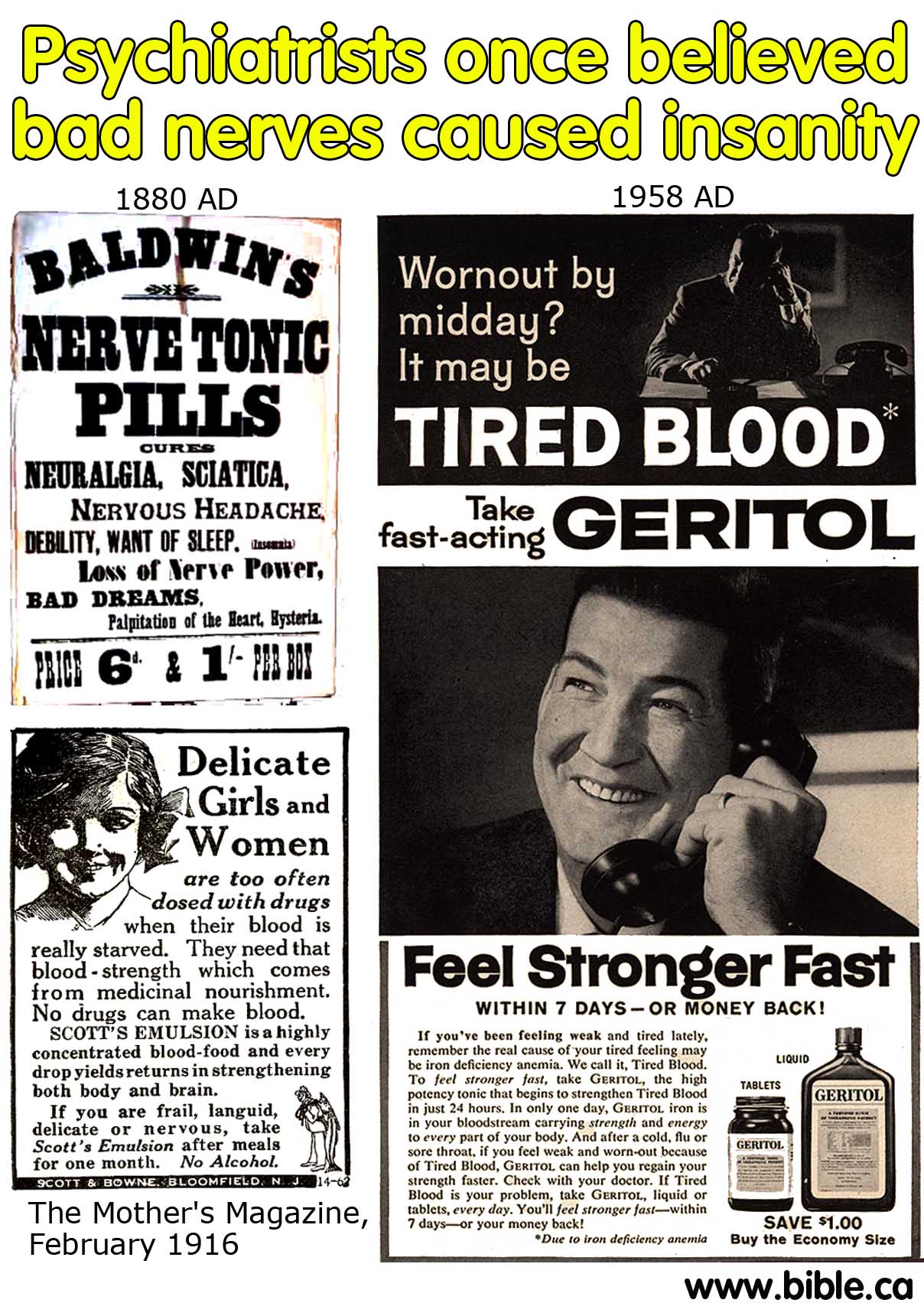
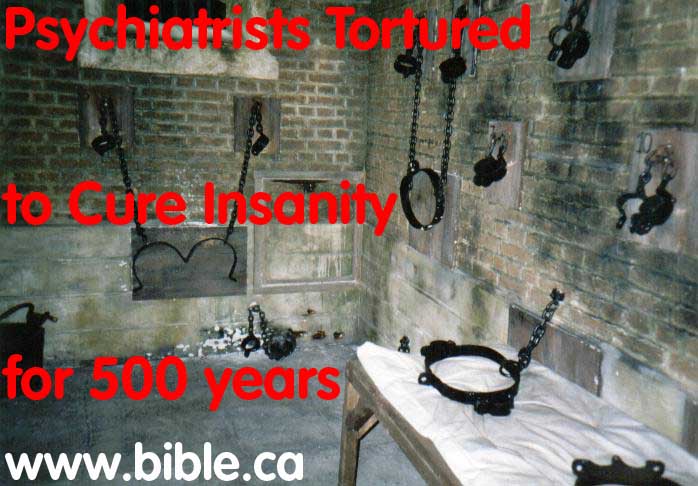
- In 1670 AD, Richard
Baxter, Church Minister, took the view that insanity and depression
were caused by life circumstances, moral choices and sins of an
individual, that induced bad "melancholy blood". Although his
etiology is humoral, it important to realize that he believed that sin and
emotion actually were the foundational cause of melancholy blood, which
then caused insanity! 1. sin. 2. bad blood. 3 insanity. "Root and Foundation, is usually a Depravation of the
Mass of Blood, which is the Vehicle of the Spirits, and that is usually
accompanied with some Diseases of the Stomach, Spleen, Liver"
First on his list of causes of melancholy was: "SINFUL Impatience, Discontents and Cares, proceeding
from a Sinful Love of some bodily Interest, and from want of sufficient
Submission to the will of God, and Trust in him, and taking Heaven for a
satisfying Portion. This is one of the most common Causes". He
then goes on to list things like: "when they
are in Debt to others", "the
secret Root or Cause of all this, is the worst Part of the Sin, which is
too much Love to the Body and this World". He also identifies high
self esteem and a lack of contentment as a cause: "not sufficiently humbled for our Sin, or else we should
be thankful for the lowest State, as being much better than that which we
deserved". He also identifies cognitive dissonance (bad
conscience) as a trigger of insanity: "great
Cause is the Guilt of some great and wilful Sin, when Conscience is
convinced, and yet the Soul is not converted". His cure of
insanity was to repent: "repent, to love God
and your Neighbour, to live soberly, righteously and godly, to pray at
all; here you must strive, and not excuse it by any Backwardness; for it
is that which must needs be done, or you are lost". Although he believed typical Hypocrites junk
medicine, he attributed depression and mental illness to freewill choices
as the primary cause, which in turn cause the blood to become melancholy.
So the real problem lay in fixing the mind, not the body! Repentance, he
believed, would correct the melancholy blood and restore the person to normal.
(The
Signs and Causes of Melancholy, Richard Baxter, 1670 AD)
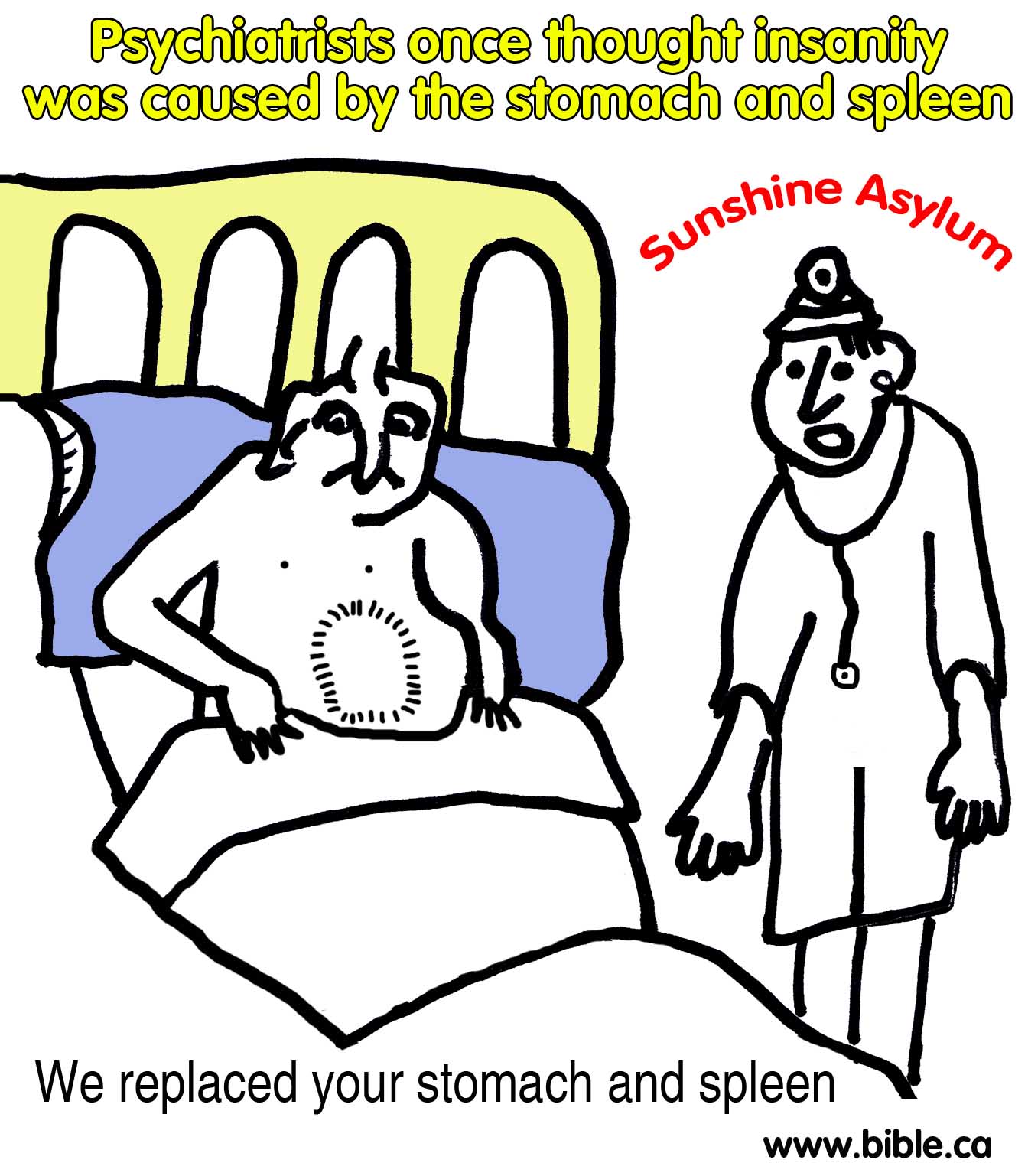
- In 1691 AD, Timothy Rogers, a minister for a church, describes depression (melancholy) as caused by a sin problem: "A sense of Sin, and great sorrow for it", "a sense of the Wrath of God, and a fear of Hell", "terrors of the soul", "trouble of Conscience", "terrors of Conscience", "Anxieties of Soul", "sinking and guilty Fears", "sense of Tormenting", "Racking Pain, the immediate prospect of Death, and together with this, an apprehension of God's Displeasure, and the fear of being cast out of his Glorious Presence for ever", "anguish and vexation", "Raging Fever", "want of sleep", "Real Misery that they are tormented with", "fears and terrors that overwhelm our Souls", "fills them with anguish and tribulation". He describes how the mind can make the body sick: "If a Man, saith he, that is troubled in Conscience, come to a Minister, it may be, he will look all to the Soul, and nothing to the Body; if he come to a Physician, he considereth the Body, and neglecteth the Soul: for my part, I would never have the Physician's Counsel despised, nor the Labour of the Minister neglected; because the Soul and Body dwelling together, it is convenient, that as the Soul should be cured, by the Word, by Prayer, by Fasting, or by Comforting; so the Body must be brought into some temperature, by Physick, and Diet, by harmless Diversions, and such like ways." Rogers cautions not to blame the devil for this depression: "Do not attribute the effects of mere Disease, to the Devil". (A Discourse Concerning Trouble of Mind and the Disease of Melancholly, Timothy Rogers, 1691 AD)
- In 1691 AD, Robert Boyle (inventor of Boyle's Law of the relationship between pressure and volume of gas), believed that the mind, not the body caused insanity. Boyle gave two case histories of hypochondria which he correctly labels as "emotional shock". He clearly shows that the cause is purely of mind affecting the body: "Instances I have met with, that shew the great Power which sudden Passions of the mind may have upon the Body". One was the case of a woman who became immediately paralyzed when her son drowned in a river while under her supervision. She "was struck with so much horror upon the sudden accident that tore from her a favorite Son, that among other mischiefs, she fell into a Dead Palsy of her right Arm and Hand, which continu'd with her in spight of what she had done to remove it, till the time she complain'd of it to me, who had not opportunity to know what became of her afterwards" (Experimenta & Observationes Physicae, Robert Boyle, 1691 AD)
- In 1692 AD, John Moore, a church
minister, preached a sermon to the queen about sin induced depression among
Christians who have a "sincere love of God"
and who experience that "which makes them fear". He correctly
understands that depression is caused by sin: "dread
of those Punishments, which he hath threatened to inflict on unrelenting
sinners". However, he is inconsistent in his view, stating
that the depression is caused by the body rather than the mind, "to judge them to be Distempers of the Body, rather
than Faults of the Mind" and like chemical psychiatrists
today, he actually excuses the sinful conduct as being outside the
person's personal control. "they [bad
thoughts] continue with you much against your consent". He
even excuses their sinful conduct before God on Judgement day: "God . . . no where hath said, That Men shall be
condemned for their ungovernable Thoughts, over which they have no
dominion". Moore then contradicts himself and says that the
cure is self control of the mind, not some drug for the body: [thoughts]
"engaged in a good Matter" and he
orders people to not quit their jobs: "I
exhort you not to quit your employment". He goes on to advice
that the cure is through keeping your mind calm with gentle thoughts: "It is not therefore a furious combat with
melancholy thoughts, which will but weaken and sink the body, and to make
the case worse, but a gentle application of such comfortable things as
restore the strength, and recruit the languishing spirit that must quash
and disperse these disorderly tumults in the head." Notice he
sees the problem as "languishing spirit and tumults in the mind".
This is not a bodily disease at all! This mishmash of contradictory
concepts from a minister of a church may indicate he was trying to water
down the message of the Bible in the audience of the Queen to save his own
head! Perhaps the Queen suffered from depression and Moore did not want to
offend her by blaming her depression on her own sin. (Religious Melancholy,
John Moore, 1692 AD)

- In 1694 AD, Franciscus
Mercurius van Helmont reported a method of water torture used by his
father, Johann Baptista van Helmont to cure insanity. This was later
improved upon by Patrick
Blair in 1725 AD. Most important, was the fact that Helmont believed
"raging madness" was a disease caused by the human spirit and
will. It was a form of water torture and its success in curing the insane.
The insane were suspended by their feet above a large tub of water and
lowered, head first up to their waist to the point of asphyxiation. Some
died, some survived, some were cured. Helmont wisely, advises to get the
court's permission to do this in case they actually drown. It was
practiced upon the worthless and lazy that were "of no use in the Common wealth" to make them
pull their own weight in society, as well as the "Raving mad".
Many cures of insanity were boasted, "did
cure several distracted Persons this way, there are many in Holland that
can verify" ... "several Cases [of
raging madness] be cured by casting the Patients
into the Water". The success of this method prove that a mad
man with "raging madness" can control and change his conduct.
Whether he was faking it or not, he was able to stop acting like a madman
and become a productive worker in society. Houdini performed a stunt of
escape from a water tank that exactly simulated Helmont's water torture.
Today, Water Boarding is called the "enhanced interrogation
technique" used by the US army against Muslim
Terrorists to gain valuable information about future and past
terrorist attacks. The CIA use it because it work! In Waterboarding, a
person is strapped to a board and ice water is dripped on his head with a
cloth covering his face. A combination of the cold and the fear of
drowning changes the will of the person to comply. Water-boarding has its
origin in part, with Helmont. Not only do we feel it should be used the US
government, we would like to see it the "out of control" insane
who are locked up in mental hospitals also waterboarded. It would save us
a lot of tax dollars in a large number of cures! (The
Spirit of Disease; or Diseases From the Spirit, Franciscus Mercurius
van Helmont, 1694 AD)
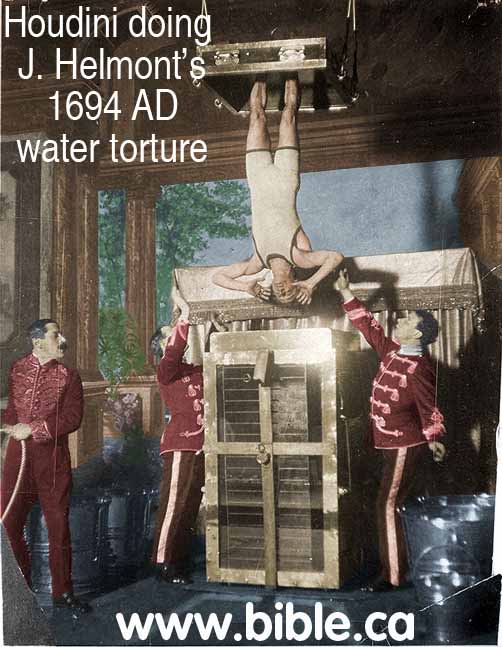

- In 1695 AD, Thomas Tryon correctly understood that madness was a spiritual problem, not a bodily illness caused by chemical imbalances as it believed today. He identified a cause of insanity as being, "bitter envious fierce wrathful proud Spirit" Anger, selfishness, pride, narcissism are all triggers for madness. "The truth is, Madness and Phrensie do generally, and for the most part (for some other few particular causes we shall give an account of by and by) arise and proceed from various Passions and extream Inclinations, as Love, Hate, Grief, Covetousness, Despair, and the like, which do . . . break forth, violate and destroy the give inward Senses of the Soul, whence the outward Senses do arise; So that the Soul loseth its distinguishing property, and then the Imaginative property and Soul's Power becomes rampant, unbounded, or as it were without a Guide, and consequently such a Soul is unchained, or set at liberty from the dark Confinements of the grosser Senses and Reason, even as men in Dreams." Tryon had observed that religious people were affected with madness and noted that the prime cause was anger, pride and narcissism: "some who have seemed very Religious, and soberly inclined, as long as they retain'd their Senses and outward Reason, as soon as they become deprived thereof, the bitter envious fierce wrathful proud Spirit appears in its own form, and has its operation without let or hindrance." He rejected drugs, bloodletting and vomits as effective cures of madness. "As to the Cure of Madness in general, the Schools commonly prescribe Blood-letting, and Sleep procuring Medicines, but with how much success daily experience witnesseth, they mistake the Cause, and therefore blindly combat with the Effect" He also criticized the practice at Bedlam of allowing the general public to pay admission to mental hospitals to mock the patients and ridicule them for their own personal entertainment. "I must acknowledge that Gallant Structure of New Bethlam to be one of the Prime Ornaments of the City of London, and a Noble Monument of Charity, so I would with all Humility beg the Honorable and worthy Governours thereof, that they would be pleased to use some Effectual means, for restraining their inferior Officers, from admitting such Swarms of People, of all Ages and Degrees, for only a little paltry Profit to come in there, and with their noise, and vain questions to disturb the poor Souls" (A treatise of dreams & visions, Thomas Tryon, 1695 AD)
- In 1701 AD, John
Freind, doctor, related a case of contagious hysteria known as
"the barking girls". Two related families of young girls were
having a grand old time putting on a classic show of hysteria. In 1787 AD,
William St.
Clare noted in his "An Epidemic Of Hysterics" the following:
"barking and howling like dogs . . .
accompanied by violent rhythmic movements of the head and contortions of
the face . . . when their breath failed they would one by one fall into a
paroxysm like an epileptic fit". (Uncommon
Kind of Convulsions, John Freind, The philosophical Transactions, vol
5, 1701 AD)

- In 1705 AD, Thomas
Fallowes, doctor and mad house owner, claimed he cured insanity with
"blisters". This was a common procedure of the day, that
produced clear fluid blisters, when sulfuric acid was applied to the
scalp. (Oleum Cephalicum). It is like the blister that forms under a
bubble of skin when you burn yourself with oil or hot water. This practice
continued for hundreds of years until the end of the humoral medicine in
1858 AD. The idea was that vapours from bad melancholy blood needed to
vent out of the scalp to cure the insane! In his own words, "I have discovered a noble Medicine proper to it, being
the Incomparable Oleum Cephalicum, a Composition so very curious, and which I have known the
Use and Benefit of in so many Instances, that I can venture to assure it
to be the Best Medicine in the World, in all the Kinds of Lunacy I have
met with. It is of an excellent and most pleasant Smell; and by raising
small Pustules upon the Head, which I always anoint with it, opens the
Parts which are condens'd, and made almost insensible, by the black
Vapours fix'd upon the Brain; it confirms the Texture of the Brain,
strengthens the Vessels, and gives a Freedom to the Blood and Spirits
inclos'd in them: Being given at first beginning of Disorder, it removes
the Cloudiness of the Mind, makes the Patient chearful, lively and active,
and when apply'd after the greatest Fury and Passion, it never fails to
allay the Orgasm of the Animal Spirits, and sweetly compose 'em. It
removes the Terror of the Mind, scatters the Vapours that are the Cause of
Enormous Dreams, to which Distracted Persons are almost constantly
subject; and procures quiet easy and natural Sleep, to which when the
Patient can be brought, without the use of Opiates, he cannot miss of an
entire Cure; the Distemper will soon be discharg'd, and I have known it
frequently to produce a Cure in the Space of one Month." Note
that Fallowes believed that blistering truly cured insanity and was his
treatment of choice because he got tangible results: "I can venture to assure it to be the Best Medicine in the World, in all the Kinds of Lunacy I have met with". The real question is how
chemically burning the scalp cures insanity! The long and wide use of this
quacky treatment only underscores that insanity is a spiritual, not bodily
problem. Obviously nothing changed in the body, but perhaps placebo or
just the enduring torturous pain was enough for those misbehaving to cure
themselves! They had to make a decision. Stop being insane or continue to
endure the pains and discomforts of treatment. (Incomparable
Oleum Cephalicum: The best method for the cure of lunaticks, Thomas
Fallowes, 1705 AD)

- In 1707 AD, John Purcell, a doctor of medicine, was confused and clueless about the causes and cures of mental illness. His local church minister understood the cause of insanity better than he! Purcell wrongly viewed epilepsy and hysteria ("Fits of the Mother") as two different degrees of the same disease. He describes epileptic fits in great detail and gives great warnings about burying living epileptics alive. To make sure they are dead he advises: "hold a very little fine Carded Wool, a Feather, or burnt Paper before their Mouths". He also believes that Fits of the Mother (hysteria) are caused by the uterus sending vapors up to the head and making one sick. He also viewed hysteria as being transmitted from mother to daughter: "Another Question to be ask'd, is, if she were Born of Parents subject to Hystericks ; for Vapours as well as other Diseases, are transmitted to us from our Fathers and Mothers." John Purcell was a quack who could have learned much from his local church minister for they were way ahead of him. (A treatise of vapours or hysterick fits, John Purcell, 1707 AD)
- In 1715 AD, Herman Boerhaave, Doctor, believed that insanity was caused entirely by "the Blood become thick, black, fat and earthy ... malignancy of the Blood and Humors, which the Ancients have called Black choler ... Atrabiliar Humor, or Melancholy Juice ... thick oil of the Blood ... nervous Juices from the Brain ... Liquids of the Brain and Nerves" Boerhaave believed that it was easy to cure if you followed his instructions: "the Cure doth also occur easie enough from these Principles". The cure involved: "repeated letting of Blood and strong Purges between each Bleeding, and afterwards when you have lay'd his fury, and have brought him to his Senses, then give him Cordials and Opiates." These became standard cures at Bedlam. But he also recommended water boarding which was clearly a moral treatment since it was to be done by surprise and would strike terror into the person: "Patient unwarily into the Sea, and to keep him under Water as long as he can possibly bear without being quite stifled." Boerhaave was either a bad discector or he invented his observastions about how the brains of mad were different in appearance: "by Anatomical Inspection it has been made evident, that the Brain of those is dry, hard, friable, and yellow in its Cortex; but the Vefleis turgid, varicous and distended with black and very tough Blood." (Aphorisms, Herman Boerhaave, 1715 AD)
- In 1716 AD, Samuel Clifford, minister of the Gospel posthumously compiled a collection of writings of Richard Baxter, preacher for a church. As noted above, Baxter viewed madness as a spiritual problem, not a bodily or physical one. He correctly viewed the cause of madness as sin and "wounds of the conscience". He correctly charged the insane as being "guilty of voluntary active Self-pollution" who willfully sinned, then suffered the pains of their conscience. Baxter notes that cognitive dissonance from unrepented sin, can lead to delusion, paranoia, depression and laziness. "I would warn all young Persons to live modestly, and keep at a sufficient distance from Objects that tempt them to carnal Lust . . . For I can tell them by the sad Experience of many, that venerous Crimes leave deep wounds in the Conscience; and that those that were never guilty of Fornication, are oft cast into long and lamentable Troubles, by letting Satan once into their Phantasies . . . especially when they are guilty of voluntary active Self-pollution". Baxter notes the symptoms as self condemnation due to personal sinful conduct, paranoia that others are constantly talking about them and laziness. "Melancholy Persons are commonly exceeding fearful . . . Their Fantasie most erreth in aggravating their Sin, or Dangers or Unhappiness... They are continual Self-Accusers, turning all into matter of Accusation against themselves ... They are still apprehending themselves forsaken of God . . . and that it is now too late to repent or find Mercy ... suspicious of every Body that they see whispering ... given to Idleness, either to lie in Beds, or to sit unprofitably by themselves". Baxter's cure is as puzzling as it is opposite to what is needed. Having already stated that personal sin is the cause of madness, he suggests diversion from consciousness of sin and lots of personal attention, rather than repentance and social isolation as mandated in Matthew 18. "A great part of their Cure lieth in pleasing them, and avoiding all displeasing Things, as far as lawfully can be done ... divert them from the Thoughts which are their Trouble ... Suffer them not to be long alone, get sit Company to them". As a preacher, Baxter should have known better than to suggest this. When someone is in sin, it justifiably makes them feel bad and under the condemnation of hell. The only cure is repentance and forgiveness from God. Baxter's cure for a fornicator who feels condemned by God, for example, would be to have the sinner think about fields of flowers and sunsets rather than his sin. This is equivalent to what is done today in chemical psychiatry where drugs are used to take away bad feelings of the conscious. Baxter also suggests that the sinner should be given lots of undue attention and never left alone. This is opposite to what Jesus said in Matthew 18, where the unrepentant sinner is to be socially isolated. Baxter's system of "diversion and love bombing" does work on the melancholy, but it achieves this in a manner opposite to what the Bible commands. It is like giving a screaming, disobedient and rebellious child who refuses to obey the parent, a candy, in order to shut them up, rather than a good spanking. We are commanded to repent of sin, not ignore it and think of flowers and rainbows. When the sinner sees those around him engage in coddling and reassurance, without discipline, it is like giving that candy to the rebellious child. When many people spend time with a melancholy sinner it sends the message: "Don't feel bad about your sin, we are all here spending time with you in order to remove your bad feelings without repenting." This obvious truth is what Baxter understood 300 years ago! (The signs and causes of melancholy, Richard Baxter, 1716 AD)
- In 1718 AD, Andrew
Snape is the first preacher to diverge from the widely held view that
insanity was caused by solely by sin. Snape marks the beginning of
Chemical psychiatry. Having said this, Snape highlighted that there were
three causes of madness: sin, ignorance, overloaded brain wiring: "But besides Sin and Ignorance, there is a third Sort of
Blindness incident to Human Minds". But it was the new concept
that deep and intense thought could cause the brain nerves to overload and
cause madness, that marks the beginning of the "chemical
imbalance myth" we see today. Snape describes an absurd etiology
to insanity. His view is that the spirit drives the "machine of the
human brain" too hard and it is unable to withstand the pressure.
Like burst water hoses, the "brain fibres" are unable to kept
thoughts separate and they begin to mix inside the brain causing madness: "Whilst the aspiring Soul is pursuing some lofty
and elevated Conception, soaring to an uncommon Pitch, and teeming with
some grand Discovery; the Ferment proves too strong for the feeble Brain
to support, the Intenseness of Thought disconcerts the slender Fibres; the
thin Partitions and Enclosures, that keep the Ideas separate, and rang'd
in a beautiful Order, are burst in sunder by the Force of the labouring
Imagination, and the whole Magazine of Notions and Images lye jumbled
together in a common Heap, and mingled in wild Confusion."
Snape's view of insanity was not particularly clever or novel. It was
utter quackery in hindsight. This is where the idea of the "mad
scientist" or the "insane genius" came from. Just as a body
builder will snap a bone or tendon from too much load, so too the genius
overloads his fleshly brain. Of course, the Christian knows from Luke
16:21ff, that memory and computation are a function of the spirit, not the
brain or the body. Snape worked at Bedlam and suggested that
institutionalized care could cure it: "there
is need of Art and Skill, of proper Remedies, and a strict Confinement of
the Person so afflicted ... Physick and
Diet, and other Management" It is noteworthy that in 1758, William
Battie rejected sin as a cause of insanity and adopted the "brain
wiring" etiology pioneered in part by a local church minister!
Christians today know that thinking hard and deep thought do not cause
insanity, since these happen in the spirit not the physical brain. The
brain is the physical medium the spirit uses to illuminate the body. (Spital Sermon, Andrew
Snape, 1718 AD)
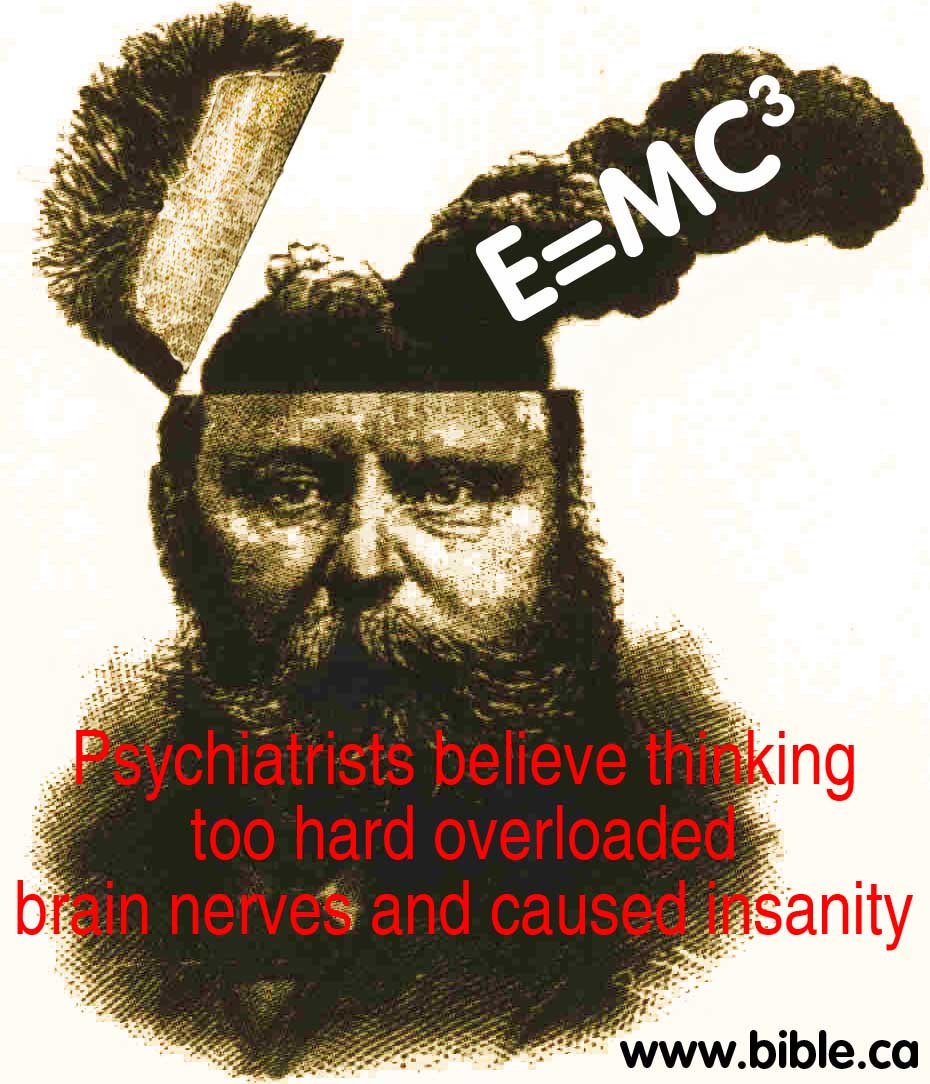
- About 1720 AD, marks the rise of private mad houses for
profit. Three events between 1725-1728 AD mark the beginning of the
transition from privately owned non-profit mad houses run by church
ministers to profit oriented mad houses run by non-Christians. Additionally,
1720 marks a sudden multiplication and proliferation of the number of mad
houses. A new industry is born! The three markers are: 1. Patrick
Blair in 1925, 2. Eliza
Haywood in 1926, 3. Daniel Defoe in
1928. These three witnesses of history also show a new trend of sane wives
been thrown into mad houses to either punish them for disobedience or to
gain access to their family money.
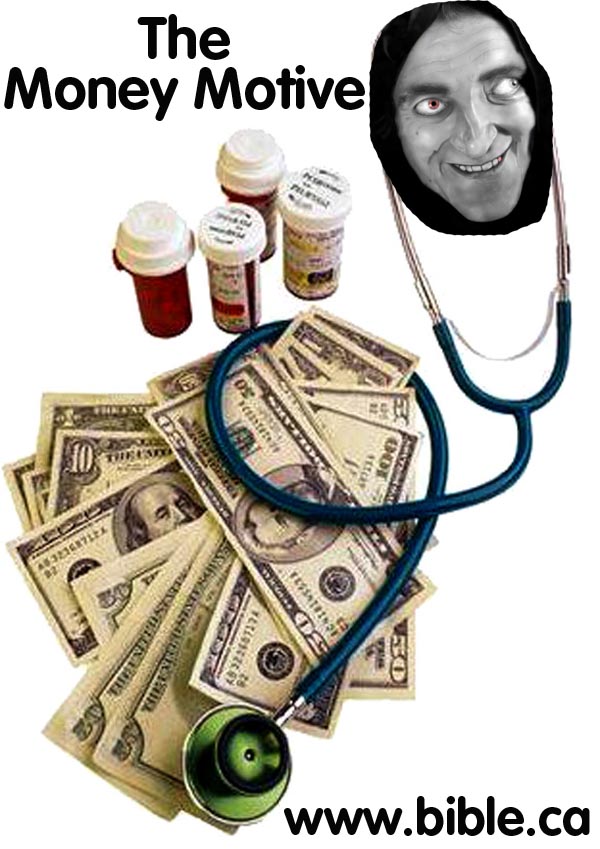
- In 1725 AD, Patrick
Blair, Doctor, perfected a system of torture that cured the insane
that he learned of from Franciscus
Helmont in 1694. Waterboarding continued to be used in prisons in
1858, and is used today by the CIA on Muslim terrorists. Whereas Helmont
lowered a bound mad man, head first into a large tank of water, Blair
dropping large volumes of water on the head of a mad man seated and bound
in a chair. Most important is that both Helmont and Blair viewed the cause
of insanity to be spiritual choices of men rather than bodily diseases.
For this reason, water torture was an effective way of convincing the mad
man to stop his insane behaviour. Blair and Helmont boast that this method
indeed cured the insane! Blair would blind fold people before the
procedure as a way of further inducing terror of death. Whereas Helmont
reported many downed from his cure, Blair never lost a patient! His final
device included a large pump that elevated 18,000 gallons of water 35 feet
in the air above the person strapped to a chair below. Additionally, he
even sprayed water up into the face for a more complete effect. He used
this final version to cure a woman who was, "mad,
neglected every thing, ... kept her room, would converse with nobody but
kept spitting continually" and refused to have sex with her
husband. For 7 weeks before water treatment, she had "frequent bleedings, violent Emeticks, strong purgatives
and potent Sudorificks and Narcoticks were not wanting". This
brought about a partial cure: "gave all signs
of recovery except that of the dislike to her husband". She he
strapped her naked into the chair which, "put
her in an unexpressable terrour especially when the water was let
down. I kept her under the fall 30 minutes,
stopping the pipe now and then and enquiring whether
she would take to her husband but she still obstinately deny'd till at
last being much fatigu'd with the pressure of the water she promised she
would do what I desired". But the next day she refused. So he
water tortured her in this way two more times. But when she recovered,
again she refused. So Blair, "I threatned her with the fourth Tryal, took her out of bed, had her stript, blindfolded and ready to be put in the
Chair, when being terrify'd with what she was to undergo she kneeled submissively that I would spare her and she
would become a Loving obedient and dutiful Wife for ever thereafter.
I granted her request provided she would go to bed
with her husband that night, which she did with great chearfullness ...
About 1 month afterwards I went to pay her a visit, saw every thing in
good order". Blair proclaimed her cured! Whether you view this
as a genuinely insane woman or a stubborn angry wife putting on the act of
a mad man, either way it corrected the bad behavior! Blair claimed his
water treatment by the "fall of water" was, "the safest method of curing mad people ... and sink the
patients spirits even to a deliquium [melted] without the least hazard of their Lives." (Cure
of Mad Persons by the Fall of Water, Patrick Blair, 1725 AD)

- In 1726 AD, Eliza Haywood wrote a play called, "The distress'd orphan" or, "Love in a mad-house", that highlighted a new phenomena of wicked husbands sending their rich and unwanted wives to a private mad house so they could get their wives money and be free to love their new mistress. Haywood shows that it was well known that being thrown into a mad house could actually cause madness since the rich heroine greatly feared going mad herself and "fall indeed into that Disorder of which the was accus'd." This shows that insanity was not a medical condition, but caused by cruel torture and abuse. The mad house is a small building that housed maybe 10 people in "several Apartments", chained naked to the floor on dirty straw with meager food rations. The keepers mocked and beat them into submission. In the play, a rich woman refuses to marry a man who is only after her money, "it was for her Wealth alone that he had seem'd so desirous of engaging her". The woman's "guardians" had likely made a deal with her "new husband" to get a cut of the money. When she refused, the "guardians" threw her into a mad house. While it is important to remember that the play exaggerates a fictional situation, the core of the situation is likely intended to be readily recognized by the audience perhaps as a method of bringing about change through theatre. Being kidnapped from her home, "thrust into the Coach, where the three Keepers immediately crowding in", she finds herself inside the madhouse: "disturb'd with Sounds, which struck so great a Dread into her, that nothing is more strange, than that she did nor die with the Fright, or fall indeed into that Disorder of which the was accus'd. The rattling of Chains, the Shrieks of those severely treated by their barbarous Keepers, mingled with Curses, Oaths, and the most blasphemous Imprecations, did from one quarter of the House shock her tormented Ears while from another, Howlings like that of Dogs, Shoutings, Roarings, Prayers, Preaching, Curses, Singing, Crying, promiscuously join'd to make a Chaos of the most horrible Confusion: but the Violence of this Uproar continued not long, it being only occasion'd by the Entrance of the Keepers into the Cells of those Wretches who were really Lunatick, and had, for the Addition of their Anguish, so much Remains of Sense, as to know what they were to suffer at the Approach of these inhuman Creatures, who never came to bring them fresh Straw, or that poor Pittance of Food allowed for the Support of their miserable Lives ; but they saluted them with Stripes in a manner so cruel, as if they delighted in inflicting Pain, excusing themselves in this Barbarity, by saying that there was a necessity to keep them in awe ; as if Chains, and Nakedness, and the small Portion of wretched Sustenance they suffer'd them to take, was not sufficient to humble their Fellow- Creature. Besides, what is there to be feared from those helpless Objects of Compassion, who being Hand-cuffed, and the Fetters on their Legs fast bolted into the floor, can air no farther than the length of their Chain!" Haywood's play follows Patrick Blair's "cure of madness by the fall of water", in 1725 AD where he actually gives a case of curing a disobedient wife of her madness by water torture. Then in 1728, Daniel Defoe makes a public effort to bring get authorities to stop this injustice to women. (The distress'd orphan or, Love in a mad-house, Eliza Haywood, 1726 AD)
- In 1728 AD, Daniel Defoe, author
of Robinson Crusoe, believed that a husband could drive his sane wife mad
by sending her to a mad house. He believed insanity was caused by life
circumstance, not a disease saying, "it is
much easier to create than to cure madness". He wrote about a new
phenomonea "a practice scarce heard of till
of late years" of the rise of private mad houses and the
jailing of unwanted
rich wives by treacherous husbands in some of these mad houses.
Whereas mad houses had been run for altruistic purposes by church
ministers, Defoe shows the rise of many new mad houses by non-church
ministers for profit by housing the relatives of rich people or their unwanted
wives. "the vile practice now so much in
vogue among the better sort as they are called, but the worst sort in
fact; namely, the sending their wives to madhouses, at every whim or
dislike, that they may be more secure and undisturbed in their
debaucheries; which wicked custom is got to such a head, that the number
of private madhouses in and about London are considerably increased within
these few years." Since mad houses were originally started by
ministers of churches, this sudden surge in the number of mad houses marks
the beginning of the profit motive of running mad houses by non-ministers.
There is simply no way that altruistic ministers would jail unwanted wives
so their husbands could spend the wive's money on their new mistress.
"How many, I say, of beauty, virtue, and
fortune, are suddenly torn from their dear innocent babes, from the arms
of an unworthy man, whom they love, perhaps, but too well, and who in
return for that love, nay probably an ample fortune and a lovely off
spring besides, grows weary of the pure streams of chaste love, and
thirsting after the puddles of lawless lust, buries his virtuous wife
alive, that he may have the greater freedom with his mistresses?"
But Defoe also believes that the causes of insanity is life circumstances
and not a disease. He notes, "If they are not
mad when they go into these cursed houses, they are soon made so by the
barbarous usage they there suffer ... Is it
not enough to make any one mad to be suddenly clapped up, stripped,
whipped, ill-fed, and worse used? To have no reason assigned for such
treatment, no crime alleged, or accusers to confront? And what is worse,
no soul to appeal to but merciless creatures, who answer but in laughter,
surliness, contradiction, and too often stripes ... be not sufficient to
drive any soul stark staring mad, though before they were never so much in
their right senses" Defoe traces the etiology directly back to
the husband as the cause of insanity, not some disease: "When by this means a wicked husband has driven a poor
creature mad, and robbed an injured wife of her reason, for it is much
easier to create than to cure madness, then has the villain a handle for
his roguery; then, perhaps, he will admit her distressed relations to see
her, when it is too late to cure the madness he so artfully and
barbarously has procured." Another factor is that it was the
rich who initially paid for mad houses for the upkeep (or jailing) of
their relatives. In this case it was the wife who was rich and the husband
who used her money: "and he has not a
shilling but what came from her" ... "for if a man is weary of his wife, has spent her fortune,
and wants another, it is but sending her to a madhouse and the business is
done at once." Defoe calls for all mad houses to be regulated
and seeks for new licenced mad houses to be created in various parts of
town. "In my humble opinion, all private madhouses
should be suppressed at once, and it should be no less than felony to
confine any person under pretence of madness without due authority.
For the cure of those who are really lunatic,
licensed madhouses should be constituted in convenient parts of the town,
which houses should be subject to proper visitation and inspection, nor
should any person be sent to a madhouse without due reason, inquiry, and
authority." Defoe is an important marker in history for he
shows the genesis of mad houses run by non-church ministers for rich
people. (Augusta
Triumphans, Daniel Defoe, 1728 AD)

- In 1728 AD, Francis Hutcheson a naturalistic philosopher,
applied Isaac's Newton's scientific laws (ie. F=MA, 1687 AD) to the human
mind. Newton's impact on how all nature can be explained by
"laws" permeated every area of mankind. Hutcheson viewed madness
as the result of chemical processes and fluids inside the body. He wrongly
believed that emotions were the result of chemicals floating around the
blood stream. When these "fluids" were out of balance, the laws
of nature inside the machine (body) were forced to obey. His quacky views
are foundational to the beginning of Chemical
psychiatry in two regards: First, he views man as a mere pile of
chemicals with no spirit that consciously survives death as the Bible
clearly teaches. "certain Motions in the Body
do accompany every Passion by a fixed Law of Nature; and alternately, that
Temperament which is apt to receive or prolong these Motions in the Body,
does influence our Passions to heighten or prolong them".
Second and more significant, he viewed man as not responsible for his
actions: "it appears, that our Passions are
not so much in our Power, as some seem to imagine". This dangerous
slippery slope was seen in the "insanity
defense" 100 years later, and almost daily today. A Church of
Christ preacher's wife shoots
her husband in the back while he slept and she is not held responsible
by psychiatrists! Hutcheson viewed emotions of anger, sorrow, love etc. as
"chemical fluids" that affected the mind like a lingering drug. He
noted that a happy experience could allow a person to more easily endure a
negative experience because the "happy fluids" were still
floating around in the body even days after the "happy
experience". "We find our selves after a
long Fit of Anger or Sorrow, in an uneasy State, even when we are not
reflecting on the particular Occasion of our Passion. During this State,
every trifle shall be apt to provoke or deject us. On the contrary, after
good Success, after strong friendly Passions, or a State of Mirth, some
considerable Injuries or Losses, which at other times would have affected
us very much, shall be overlooked, or meekly received". So
Hutcheson promoted two key foundational concepts adopted by modern Chemical
psychiatry today: Insanity is a chemical imbalance and the insanity
plea is valid because the chemicals make us commit crimes! He was wrong on
both counts as is chemical psychiatry today who believes the mind obeys
chemical "Newtonian like" laws of the body! (An
essay on the nature and conduct of the passions and affections,
Francis Hutcheson, 1728 AD)

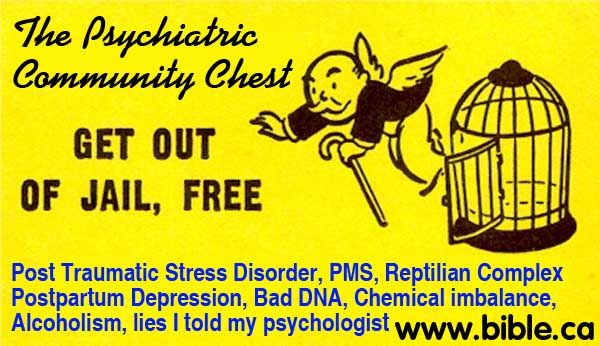
- 1729 AD, Nicholas
Robinson, doctor and governor of Bedlam the same
time James Monro, believed insanity was caused by life choices, sin and
thinking too hard, over excitement of emotion, so as to break the nerves
of the brain, "all the Decays of the Nerves
and Lownesses of the Spirits are mechanically accounted for"
... "Fits had so weakened the Fibres of the
Optic Nerves." Its like trying to put too much current through
an electrical wire and it either melts or blows a fuse! Robinson does take
a biologic view of the etiology of mental illness, but he believes it is a
case of the choices, thoughts and emotions of the mind that is ultimately
responsible for the damage. He notes how damaged nerves can be caused by
sin and guilt: "Hence arise their Difference,
Scruples, and Fears, concerning the Sincerity of their Faith and
Repentance, as also the Certainty of their Election or Reprobation; which
several Points, from the preaching of some hot-headed Gospel-Ministers,
are so strongly fix'd on the Minds of silly, weak, unhappy People, as to
work them into a State of Despondency. THEN their Sins fly glaringly in
their Faces, and are so infinitely great, that no Satisfaction can
compensate; then they think of nothing but the fearful Wrath of God just
ready to be pour'd out upon them; that the Sentence of Condemnation is
already pass'd, and that they certainly shall be damn'd to all Eternity."
A few years later the doctors of Bedlam like John Monro, dropped the idea
that sin, emotion and life choice and circumstance caused insanity, and
focused on correcting the physical problems with treatments that amounted
torture. Robinson shows how an atheist is driven to madness through his
rejection of God: "take a view of the Atheist
... What Hope, what Refuge ... the Mind was in Despair through Doubt ...
Where can he rest his hopeless Hope! where seek for Mercy, when
Conscience, Horror, Despair, and all the dismal Scenes of Woe, that can
afflict the most obdurate Heart, fly glaringly in his Face, and sting his
tortur'd Soul, with Pain and Grief unsufferable to human Nature! Hence
spring those frequent Suicides, to which these harden'd Miscreants have
Recourse, to rid them of a Life most loathed, wretched, and miserable to
endure. So that no Scene of Horror can be more dreadful, than to view an
Atheist on his Bed of Sickness, just reviving to a Sense of his being
forsaken of God, and all Hopes of his Mercy." Nicholas
Robinson believed that mental illness was caused by feelings of sin,
hopelessness and condemnation which in turn damaged the brain nerves. In a
page out of modern chemcial psychiatry, Robinson believes drugs are the
cure: "But of all Medicines in the Spleen, I
know none equal or fit to compare with
that truly noble Drug we call Opium.
It's our Refuge in all Distresses; it gives Ease and Relief in the most torturing
Pains, and when all other remedies fail; ... for by relaxing the Fibres of
the Brain and Nerves". Gotta love the idea of giving heroin to
the insane! It would be much easier if they simply repent Dr. Robinson ...
but you already knew this! (A
New System of the Spleen, Nicholas Robinson, 1729 AD)

- In 1744 AD, George
Berkeley, Bishop of the church at Cloyne, hailed the use of drinking
the distilled acid of tar (turpentine) that became known as "Tar
Water". It cured almost everything, including of insanity (hysteria).
"A cure for foulness of blood, ulceration of
bowels, lungs, consumptive coughs, pleurisy peripheumony, erysipelas,
asthma, indigestion, cachectic and hysteric
cases [insanity], gravel, dropsy, and
all inflammations." He learned about this cure from the
American Narragansett Indians. You mixed tar with water then after a few
days, you skim off the clear liquid and drink several cups per day. Even John
Wesley, founder of Methodism, raved about its successes in curing
disease. It became so common that you could order "Tar-Water" in
the local taverns. By 1830, turpentine was injected into the bladder
though an "elastic gum catheter" and the patient was told to
hold off as long as possible before peeing it out. "Turpentine
pills" were also ingested into the stomach. (Reflections
and Inquiries Concerning the Virtues of Tar Water, George Berkeley,
1744 AD)

- In 1747 AD, John
Wesley, Preacher, Founder of Methodism, understood that insanity was
caused by sin and noted a case of a young 20 year old man who went mad
"by hearing a sermon of Mr. Wheatley's, fell
into great uneasiness". He went to Bedlam and was treated by
Monro who, "blooded him largely, confined him
to a dark room, and put a strong blister on each of his arms, with another
over all his head. But still he was as 'mad' as before, praying or
singing, or giving thanks continually; of which having laboured to cure
him for six weeks in vain, though he was now so weak he could not stand
alone, his mother dismissed the doctor and apothecary, and let him be
'beside himself' in peace". Another case of madness he
understood was triggered by extreme grief of a mother whose son died.
Wesley stated that the mind can cause the body to get sick. "From fretting for the death of her son. And what availed
medicines while that fretting continued ? Why, then, do not all physicians
consider how far bodily disorders are caused or influenced by the mind".
Susannah Wesley wrote her son John Wesley about a case where John Monro
was treating in Bedlam. She said, "the man is
not Lunatick, but rather under strong convictions of sin; and hath much
more need of a spiritual, than bodily physician". Most
interesting, is her comment that Monro (like most of the largest mad house
keepers) believed that religious devotion was actually a sign of mental
illness: "he presently condemned himself and
said, Lord what sin have I been guilty of, and cry'd to God for mercy, and
pardon. This probably may confirm the Dr. in the opinion of his madness
but to me tis a proof of his being in a right mind". Susannah rejected this and believed just the
opposite and that repentance was the way to cure his madness! But Wesley
also a quack when he stated that the cure for "Lunacy" included
his electric shock machine, drinking herb tea 4 times a day, rubbing the
scalp with vinegar many times a day, drinking vinegar. His cure for
"Raging Madness" included water
boarding (fall of water pioneered by Blair
in 1725 AD) and feeding them nothing but apples for a month or nothing
but bread and milk for a month. He is most famous for inventing his
electro-shock treatment, which continues even to this day. He believed
that this machine would cure "nervous
Cases of every Kind", and treated thousands of people in
many different locations. He said: "how many
Lives saved by this unparalleled Remedy... And yet it is absolutely
certain, that in many, very many Cases, it seldom or never fails".
While Wesley correctly understood that insanity was a spiritual choice,
his treatment of shock therapy was simply a torture device, exactly like
water boarding. Strangely, Wesley used his "electric machine"
not only to cure insanity, but many other medical conditions. Electroconvulsive
Therapy (ECT) has been used since 1747 AD to cure insanity. The
difference is that Wesley did not run electricity through the brain as is
done today, but rather up an arm or leg. Wesley's treatment only inflicted
pain. Chemical Psychiatrists today use ECT to run electricity through the
brain. This causes memory loss and has a stupefying effect. In 2006,
psychiatrist Colin A. Ross concluded that "claims in textbooks and
review articles that ECT is effective are not consistent with the
published data". He also found no difference in the cure rates when
he tested using placebos: "real ECT is only marginally more effective
than placebo." Today, ECT is viewed as a short term (30 days)
distraction from insanity until the physical brain recovers from being
shocked. Running electricity through the brain is about as stupid as
applying 220 volts directly to your computers CPU. ECT, applied to the
brain causes temporary damage. During the repair period of the brain,
cognitive functions are degraded not improved. ECT is a way to instantly
drop 40 IQ for 30 days. (Primitive
Physic: or An Easy and Natural Method of Curing Most Diseases, John
Wesley, 1747 AD)
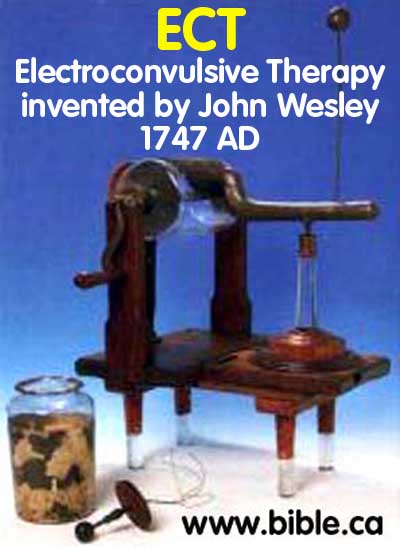
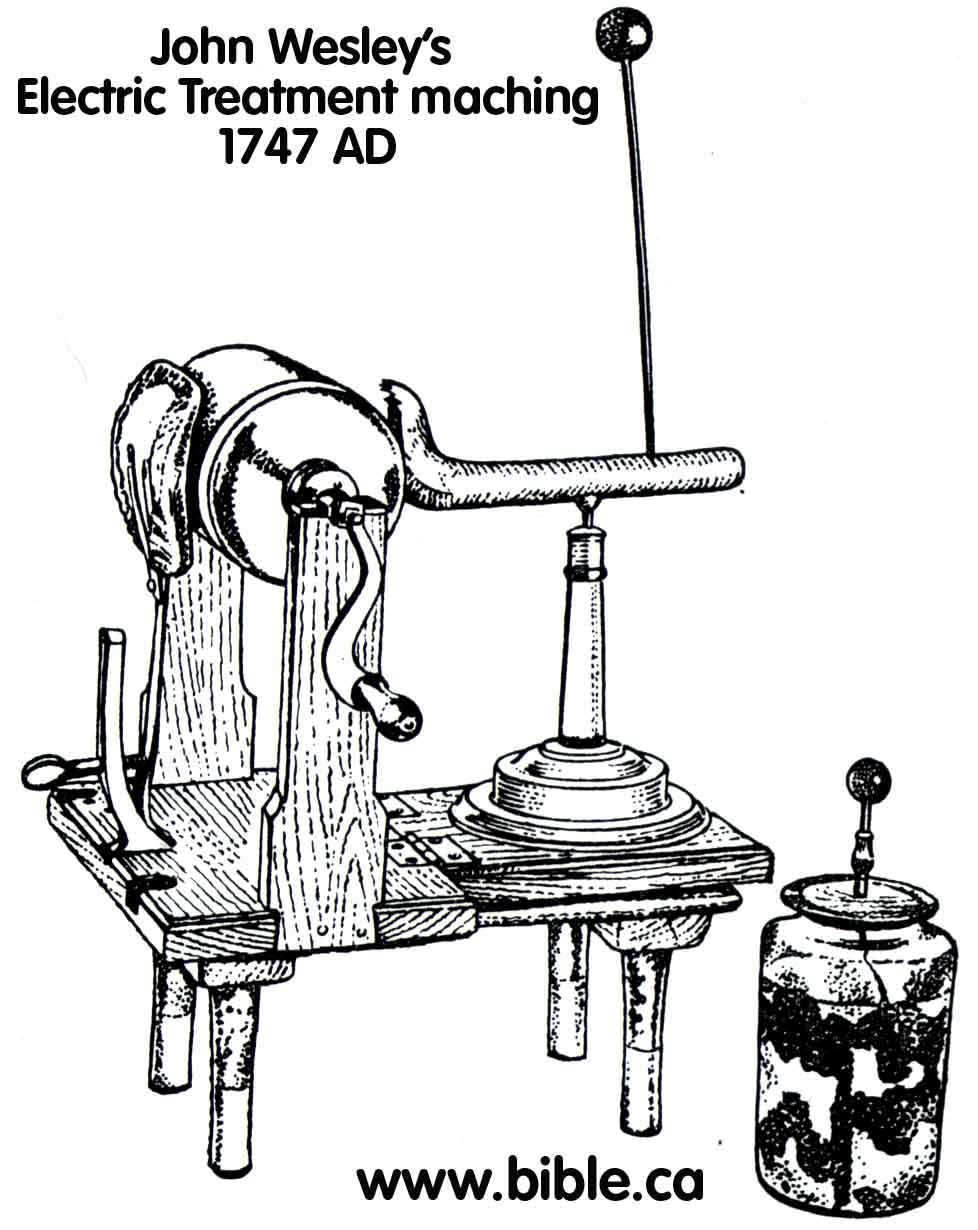
- In 1750 AD, Lewis Southcomb, church minister, departed from a long tradition of his fellow preachers and viewed extreme cases of insanity as a medical problem only doctors could cure like any other disease. However, most of what is viewed as mental illness today would be caused by a guilty conscience from sin and rebellion to God. "Shewing the Distinction between a wounded Conscience, convicted by a Sense of Sin, AND a wounded spirit; proceeding from a disordered Body; PROVING, That the latter is more grievous than the former, and comes not under the Denomination of Conscience, but of Disease, to which all Mankind are liable ; and that, in either Case, the miserably afflicted are neither mad, nor out of their Senses; but only that their animal Spirits are either elated, confused, and hurried, or otherwise oppressed and dejected. Showing, That all Severity's and Confinement are prejudicial; as are all Endeavours that give Pain, or sink the Spirits ; AND THAT, In the former Case, nothing can relieve them but Divines ; and, in the latter, nothing but the judicious Physician, and Apothecaries that will be true both to Physician and Patient." Southcomb clearly rejects all the moral treatments and torture practiced in Bedlam on the residents there. He also rejected that the worst cases of insanity should have any negative stigma attached to them. Like many in chemical psychiatry today, Southcomb did not hold the insane person responsible any more than if he had a fever. "And, if it be no Disgrace to he afflicted with one Disease, why should it be so to be afflicted with another" (Peace of Mind and Health of Body, Lewis Southcomb, 1750 AD)
- In 1758 AD, John
Monro, doctor at the Bedlam asylum,
stated that his cure of choice for insanity: "vomiting is
infinitely preferable to any other". Did you catch that?
"Vomits Infinitely preferable" Monro openly stated that he had
no idea what caused mental illness: "Madness
is a distemper of such a nature, that very little of real use can be said
concerning it; the immediate causes will ever disappoint our search, and
the cure of that disorder depends on management as much as medicine."
Entering the Bedlam asylum under Monro was like entering a torture chamber
from a horror movie since he was more concerned with controlling the
mentally ill by chains, jail cells, and degrading the physical strength of
the insane down to idiotism. Under Montro, the general public were
permitted to pay a fee and enter Bedlam to mock and ridicule the patients
like caged animals. Monro prescribed all the standard humoral treatments
of like bloodletting, blistering, cold baths etc. but his treatment of
first choice was vomits. Here it is in his own words where he induced
vomiting in a man 61 times over 180 days: "the
most adequate and constant cure of it is by
evacuation ... The evacuation by vomiting is infinitely preferable to any
other. ... I lately received from a worthy friend of mine the case of a
gentleman, who had laboured under a melancholy for three years; he himself
calls it an hypochondriacal, convulsive disorder, from which he was
relieved entirely by the use of vomits, and a proper regimen. So
very sensible was he of their good effects, that he did not scruple to
take sixty-one from the third of October to the second of April following;
and for eighteen nights successively one each night; by which means he got
rid of a prodigious quantity of phlegm, and obtained a perfect recovery.
The first seventeen were composed of one ounce of the yin. ipecacoan. with
one grain of emetic tartar, and afterwards he made use of no more than
half an ounce of the wine. And those, who are much used to hypochondriacal
people, will find them in general less weakened with vomits than purges."
The Monros were no friends of Jesus since they viewed earnest religious
devotion and strong Bible preaching as actually driving people insane.
Under John Monro preachers were forbidden to even enter Bedlam, since he
believed ministers of churches drove the patients to further madness. In
1772, under the indirect advice of John Monro, the British Government
passed a law that allowed a person to be committed to Bedlam with a single
doctor's medical certificate, and suddenly for the
first time, church preachers were stripped of any official role in the
process. Today, this has gone so far that insurance companies
forbid church preachers from even engaging in "counseling their
flock", unless they get a certificate from a secular, atheistic
institution. (Remarks
on Dr Battie's Treatise on Madness, John Monro, 1758 AD)

- In 1758 AD, William
Battie, Mad Doctor at Bedlam and then St. Lukes asylum, was
caustically hostile to Christianity and religion in general, like modern chemical
psychiatry today. His A Treatise on
Madness, never mentions the words: soul, spirit, God, Jesus. The only
time Christianity is brought into the subject is his rather stupid
suggestion that the laziness religious leaders causes madness because
their "nerves" were out of shape due to lack of use the same way
the lazy man has weak heart. It was a clear slap against religion, or his
narrow personal exposure to Christianity. He was one who actually believed
that Christians were generally mentally ill. This attitude prevails
today in modern psychiatry. To Battie, all mental illness had a physical
cause. Battie's etiology of insanity was borrowed from Nicholas
Robinson, who in 1729 AD, wrote a book where he stated bad nerves was
a cause of madness. "When once these finest
Fibres of the Brain, that immediately support the regular Exercise of our
Thoughts, have suffered such a fatal Shock; no Operation of the Mind, that
is regular, sedate, and uniform, can ever after be expected".
Battie's quacky idea of "weakness of nerves"
is seen today in quacky products like "Geritol" which are modern
versions of 18th century "nerve tonics" to keep you healthy and
ward off insanity! He believed the mind, through joy and anger, could
induce madness because it over stimulated the nerves. He believed laziness
and gluttony induced madness because it clogged up the nerves: "viscera being slopped in such a manner as to compress
the many nervous filaments ... stomach, intestines, and uterus, are
frequently the real seats of Madness" It is important to realize
that as an agnostic who didn't attend church, Battie rejected the idea
that anxiety was a spiritual problem. He believed anxiety was common to
all humanity, but only those with weak, bad or out of shape nerve fibers
would be afflicted with anxiety. This explains why modern
chemical psychiatry is in love with him as their hero. William Battie
was trained for ten years at Bedlam under John
Monro. He left and started St. Luke's mental hospital in England.
Bedlam and St. Luke's were the two largest mad houses in London. They
correspond to mainstream psychiatry today. But there were many smaller mad
houses that continued to view the primary cause of insanity as spiritual
and not organic/bodily. Although he made some dramatic changes from what
was practiced in Bedlam, almost all of his "innovations" were in
print and practice up to 100 years earlier! He strongly criticized John
Monro's practice at Bedlam of selling tickets to the public so they could
entertain themselves by teasing the patients. "the impertinent curiosity of those, who think it pastime
to converse with Madmen and to play upon their passions, ought strictly to
be forbidden". He viewed some forms of insanity as untreatable
in any way: "Original Madness [incurable] therefore,
like most other morbid cases, rejects all general methods: ... bleeding, blisters,
caustics, rough cathartics, the gumms and faetid antihysterics, opium,
mineral waters, cold bathing, and vomits." Like Monro, Battie
believed "consequential madness" was most often cured with
"vomits". Battie treated all new patients initially with a kinder,
gentler version of the tortures experienced at Bedlam. If that didn't fix
them, they were classified as having incurable "original
madness", all treatments were stopped and they were put in a separate
section of the asylum. Battie notes that after people had been given up as
incurable that they suddenly cured themselves. "when given over as incurable, recovered his
understanding." Of course this is clear evidence that it was
always in the freewill power of the insane to "act normal". When
they reached the end of the line, they wanted out of "jail".
Battie was every bit a humoralist as Monro. As such, he believed the
curing effect of "vomits" was due to the physical shaking of the
nerves and brain matter that resulted from the convulsions of act of vomiting.
(A
Treatise on Madness, William Battie, 1758 AD)
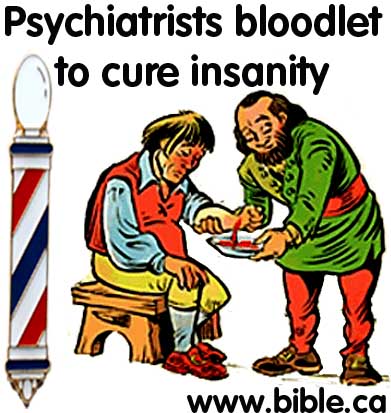
- In 1761 AD, Giovanni
Battista Morgagni, doctor, decided that the etiology of madness could
be determined by, "dissecting the heads of
persons who have been disorder'd in their senses". Morgagni is
called the father of modern pathology and he dissected over 700 people of
all diseases. In his conclusions for the cause of madness, which he
believed to the same as "melancholy", he concluded it as due to,
"a considerable hardness in the brain".
Wow! That was clever! What a Quack! He cuts open the brain of an insane
person and pokes his finger in the dura matter and notices it is harder than
normal people! We are reminded that most doctors before the 19th century,
had no more training than a typical thirteen year old today who cut open a
few raccoons, squirrels and cats on the picnic table in his back yard and
the chemistry set he got for Christmas that year! Strangely, we applaud
Morgagni for trying. But notice that his quest for the cause of insanity
in the brain he speculated by saying, "I suspect the cause":
"And I suspect that those corpuscles, which
rais'd themselves up here and there from the dura mater". This
is exactly what he hear today in modern clinical textbooks of psychiatry
when they speculate by saying, "The most promising cause of insanity
is a chemical imbalance in the brain and bad DNA." In 1761 AD,
Morgagni expected that with the advancements of modern science, that the
true etiology of madness could be clearly seen in the brain. However in
2010 AD psychiatrists are still echoing Morgagni in their expectation that
"one day... we will see it in the brain". Of course times up!
Game over! Mental illness is a spiritual problem, not a physical bodily or
brain disorder. The bodies of the insane are physically and chemically
identical to those who are normal. (Seats
And Causes Of Diseases Investigated By Anatomy, Giovanni Battista
Morgagni, 1761 AD)
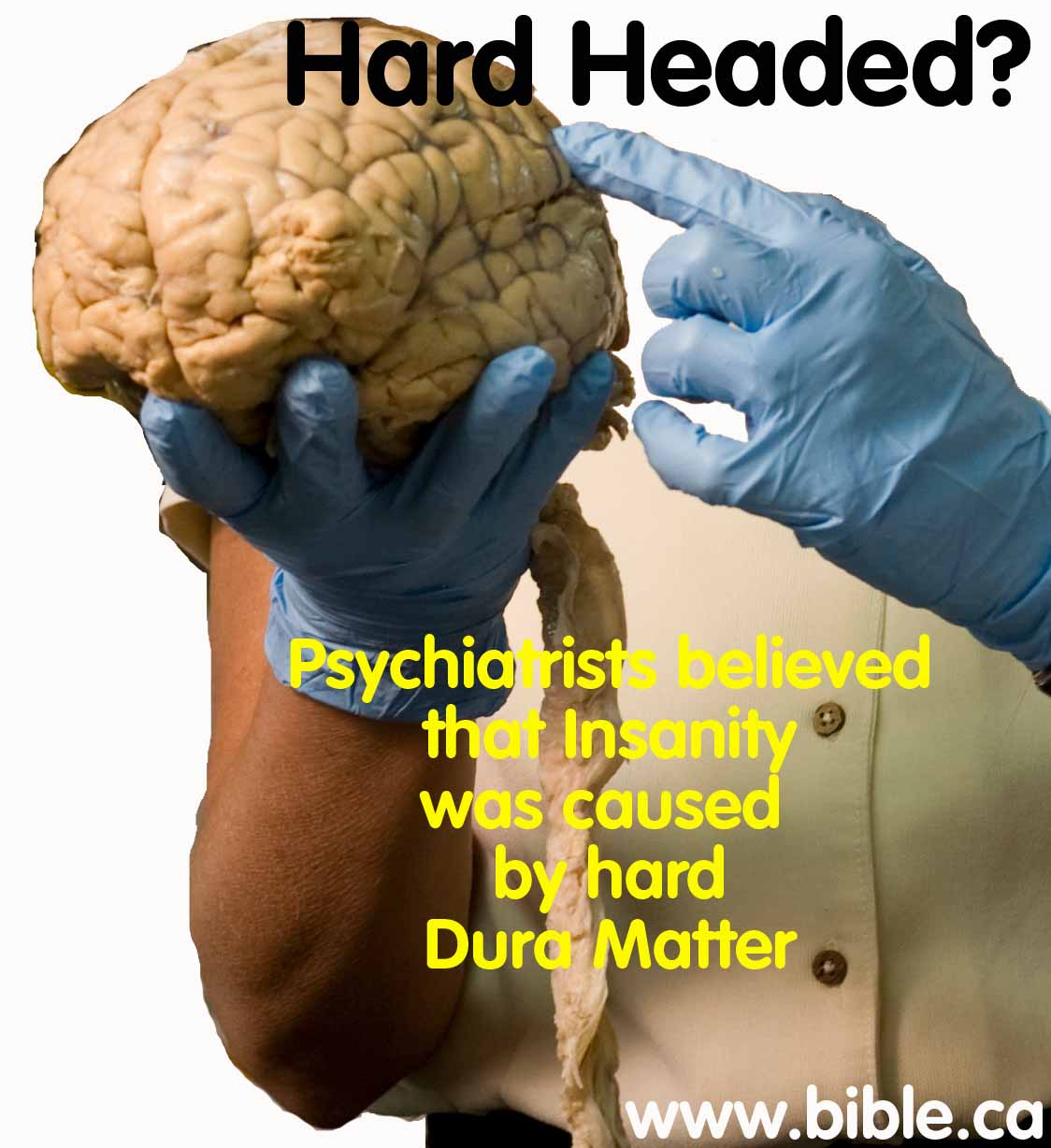
- In 1766 AD, John Hill,
a doctor, was contemporary with William
Batty and John
Monro of Bedlam.
As such, he took the view that Hypochondriasis (depression) was induced by
melancholy blood clogging the spleen. "To
call the hypochondriasis a fanciful malady, is ignorant and cruel. It is a
real, and a sad disease: an obstruction of the spleen by thickened and
distempered blood; extending itself often to the liver, and other parts
... this obstruction in the spleen is the true
malady" Others viewed the causes as, air, diet, lack of
sufficient sleep, too little or too much exercise, constipation, emotions.
Hill's primary etiology of a clogged spleen was inactivity of mind and
body and a sedentary lifestyle. He targets intellectuals that sat around
reading and writing as most at risk: "Fatigue
of mind, and great exertion of its powers often give birth to this
disease; and always tend to increase it. The finer spirits are wafted by
the labour of the brain: the philosopher rises from his study more
exhausted than the Peasant leaves his drudgery ... The first and lightest
of the signs that shew this illness are a lowness of spirits, an
inaptitude to motion ; a disrelish of amusements, a love of solitude and a
habit of thinking, even on trifling subjects, with too much steadiness."
Typical of the anti-Christian
attitudes of John
Monro and the institutional psychiatry of the day at Bedlam, Hill
takes a pot shot at the clergy: "Among particular
persons the most inquiring and contemplative are those who suffer oftenest
by this disease; and of all degrees of men I think the clergy. I do not
mean the hunting, shooting, drinking clergy, who bear the tables of the
great; but the retired and conscientious; such as attend in midnight
silence to their duty". The general view of the day was that
preachers were lazy and sedentary, and that few were physically active. He
described the symptoms similar to a depression. "lowness of spirits, and inaptitude to motion; a
disrelish of amusements, a love of solitude, Wild thoughts; a sense of
fullness". His cures focused on natural herbs like "Water-Dock" and "Spleen-wort".
He outright rejected all drugs: "No acrid
medicine must be directed, for that may act too hastily, dissolve the
impacted matter at once, and let it loose, to the destruction of the
sufferer; no antimonial, no mercurial, no martial preparation must be
taken; in short, no chymistry: nature is the shop that heaven has set
before us, and we must seek our medicine there". Insanity was
viewed as being caused by stomach and digestion problems. Hill, like many
of his day, therefore instructed the diet to be soft and easy to digest:
"plenty of boiled vegetables, are always
right; and give enough variety, raw vegetables are all bad".
So essentially Hill was a quack who, apart from avoiding the drugs
administered by the mad doctors of his day, he had it all wrong. (Hypochondriasis:
A Practical Treatise, John Hill, 1766 AD)

- In 1775 AD, Hugh
Farmer, church minister, correctly taught that demon possession never
caused insanity. Farmer would not "ascribe madness
and epileptic fits to possession, rather than other disorders".
The Bible does teach demon possession during the apostolic age, but oddly,
he Farmer did not believe the devil or demons even existed. Instead he
explained the Devil and demons to be caused by physical diseases like
epilepsy or flu viruses. Farmer said, "the
New Testament doth not countenance the doctrine of real possessions."
Demon possession is real in the New
Testament and is always accompanied by supernatural
powers and knowledge. It was impossible for demon possessed men to be
bound with even chains. They also knew things normal humans did not know.
People in need of the N1H1 flue vaccine or epileptics never exhibit supernatural
power and knowledge. Demon possession was a real thing in the apostolic
age, but did not cause insanity. Farmer believed that Jesus did perform
genuine miracles of casting out demons, but equated it with a miracle of
healing a simple disease. "From hence it
follows, that when we read in the New Testament, that Christ and his
apostles cast out demons; this must mean, that they cured demoniacs; and
it can mean no more . . . And therefore when we are told, that the demon
threw down a man, who is said to have an unclean spirit, and convulsed
him, and then came out of him, and hurt him not; the meaning must be 'that his disorder',
which was of the kind ascribed to demoniacal possession, returned upon him
with great violence." Notice Farmer rejects demon possession
and instead calls it a "disorder". Farmer almost stands alone as
a church preacher for first equating demon possession with the diseases
like common cold, and second for viewing insanity as having a
physical/biological cause. It seems he may have been strongly influenced
by William
Battie and John
Monro, who took the same view. What is important to point out, is that
he correctly rejected the idea that insanity was caused by supernatural
demon possession. In this regard, he was orthodox among his fellow church
preachers. Supernatural demon possession is real, but it has never been
the cause of insanity. (Essay
on the Demoniacs of the New Testament, Hugh Farmer, 1775 AD)

- In 1779 AD, Franz
Anton Mesmer, founded "Mesmerism" where a man could transmit
animal magnetism to another and bring about an instant cure for
"diseases of the nerves". The idea that a person has been
"mesmerized" or that something is "mesmerizing" are
verbs that owe their origin to this charlatan quack. Mesmer believed he
and his disciples, had the ability to transmit a magic power to cure
insanity from their body to another. For 70 years, Mesmerism became a
prosperous and lucrative trade as forerunners of today's junk science,
pop-psychologists who jump on any new thing that the public will pay money
for. James
Braid put the Mesmerizers out of business in 1843 when he discovered
it was mere hypnotism. There are many modern images of mesmerism in
today's culture, like the way the Emperor from Star Wars, zapped Luke with
electricity coming from his hands. Even today's hypnotists mislead
audiences that they possess some inherent power they are able to transmit
from their hands to the person being hypnotized. Since hysteria is all in
the mind, Mesmer found a deceptive, but effective cure in Mesmerism. The placebo and
nocebo effects are well documented forms of simple hypnotism, which is
nothing more than the power of suggestion. In Acts 8, Simon the sorcerer
was called "the great power of god". However when he saw the
apostle Peter lay his hands on a man and impart one of the 9 supernatural
powers listed in 1 Cor 12, Simon converted to Christianity and gave up his
"Mesmerism". (Propositions
Concerning Animal Magnetism, Franz Anton Mesmer, Mesmerism, 1779 AD)
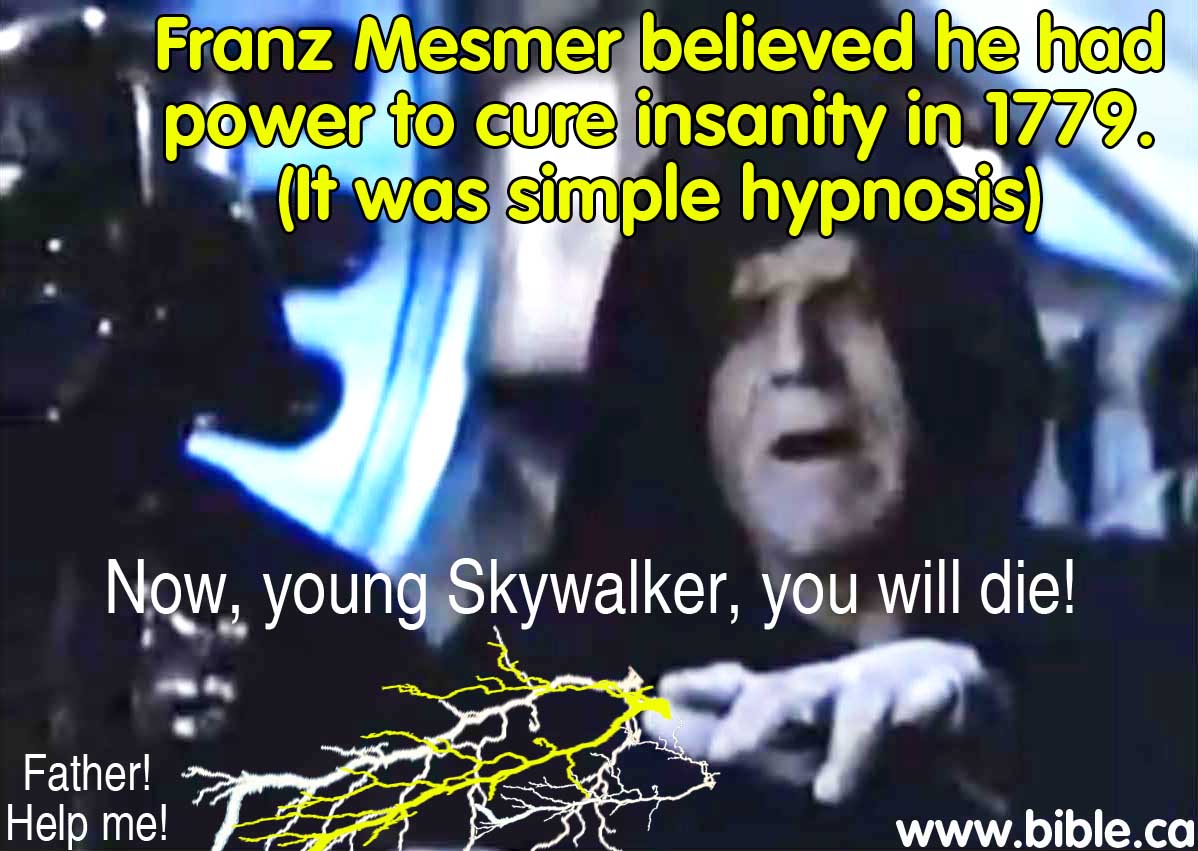
- In 1782 AD, Thomas Arnold, Doctor and Mad house owner of Leicester Lunatic Asylum in Britain, went to great lengths to describe 13 different types of insanity, which he divided into two major groups: Hallucinations and delusions. However, he also noted that, "all these species of Insanity may be variously combined, and frequently interchange, one with another." He described the etilogogy of insanity to "derive its origin from some accidental, and temporary, state . . . or to take its peculiar turn from the prevailing notions, and fashionable prejudices, of the times, or places, in which it occurs". In other words, the insane person was influenced by his environment from the outside, not some problem with brain nerves. (Observations on the Nature, Kinds, Causes, and Prevention of Insanity, Lunacy or Madness, Thomas Arnold, 1782 AD)
- In 1787 AD, William St.
Clare, doctor, wrote about a classic case of hysteria where,
"a girl put a mouse into the breast of
another girl who had a great dread of mice. The girl was immediately
thrown into a fit, and continued in it with the most violent convulsions for
24 hours". A total 24 girls began to imitate the symptoms and
the cotton mill where they all worked was shut down for fear of a plague
that entered the factory from a bag of cotton. Clare cured them all
instantly with his electric shock machine! Here is an example of how a
form of torture, instantly snapped these girls out of their acting. The
motive was likely a combination of fun, attention and getting a few days
off work. Meric Casaubon had correctly speculated in his "A treatise
concerning enthusiasme" (1655) that such events were contagious
(learned and imitated), "should be
contagious: though not contagious in the same manner, as the Plague, or
the Pox is; yet contagious in their kind". In 1701
AD, John Freind noted a case of two related families of what became
known, "the barking girls", who "barking
and howling like dogs . . . accompanied by violent rhythmic movements of
the head and contortions of the face . . . when their breath failed they
would one by one fall into a paroxysm like an epileptic fit".
These three cases show that "insane behaviour" is often a game
and play acting, known also as hysteria. (An Epidemic Of
Hysterics, William St. Clare, 1787 AD)

- In 1789 AD, J. C. Lavater trod
down the center road of typical psychiatric quackery when he equated a
persons personality and aptitude based on the shape for their face.
Equally spectacularly stupid was phrenology
(Spurzheim and Gall, 1815 AD) that determined a persons personality and
aptitude based upon the shape and bumps of the scull cap. (Essays on physiognomy,
J. C. Lavater, 1789 AD)
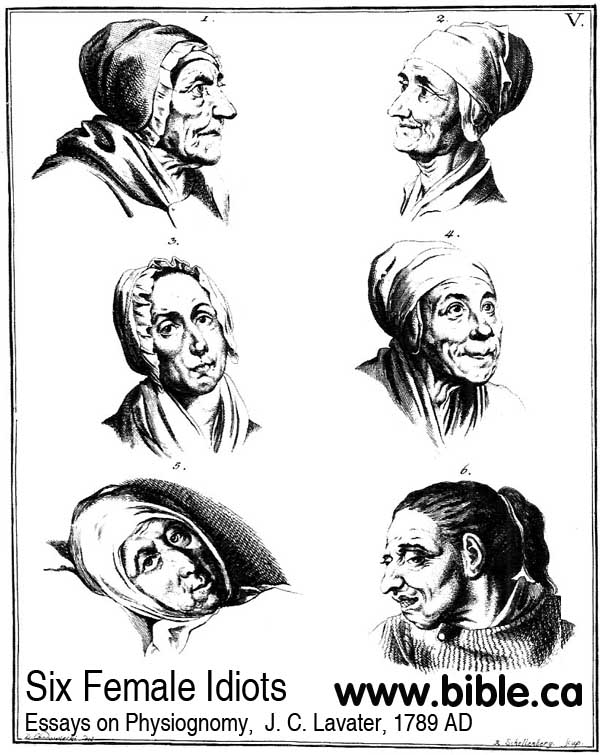
- In 1792 AD, William
Pargeter, Doctor and Chaplain, cured the insane by "catching the
eye" of the patient. This was not hypnotism, but simple good, caring
bedside manner. "He should be well acquainted
with the pathology of the disease - should possess great acumen - a
discerning and penetrating eye - much humanity and courtesy - an even
disposition, and command of temper." He gives several
successfully cured cases using this method that utilizes the element of
surprise: "the physician's first visit should
be by surprise". Pargeter criticized the torture and drugs
that was taking place at the other mad houses like Bedlam. He
gives this example: "The maniac was locked in
a room, raving and exceedingly turbulent. ... I then suddenly unlocked the door - rushed into the room
and caught his eye in an instant. The business was then done - he became
peaceable in a moment." Of course this proves that insanity is
not some chemical imbalance in the brain where a person is unable to
control themselves. Rather, the "madness" can be turned on and
turned off at the will of the "madman". Benjamin
Rush would adopt "catching the eye" as a treatment in 1812.
(Observations
on Maniacal Disorders, William Pargeter, 1792 AD)

- In 1803 AD, Johann
Christian Reil, an anatomist, believed that insanity was caused by the
mind and choices people made. He rejected a physical etiology of insanity.
He practices all the moral treatments of his era. Reil coined the phrase,
"non-injurious torture" with used the shock of fear and terror
to cure insanity. Examples of how he induced terror include: seating an
unsuspecting patient in a quiet place then firing cannons nearby; dressing
up in a ghost costume and waking up soundly sleeping patients; suddenly
throwing a patient into a pond who couldn't swim. Typical of all the mad
doctors of his day, he used coercion and discipline to gain control over
the insane. He would water board, pour hot wax on the body, burn the souls
of the feet, surprise baths with live eels, recommend sex with prostitutes
to elevate sexual insanity. But he most famous for his Cat piano
(Katzenklavier) therapy where cats "be
arranged in a row with their tails stretched behind them. And a keyboard
outfitted with sharpened nails would be set over them. The struck cats
would provide the sound. A fugue played on this instrument-particularly
when the ill person is so placed that he cannot miss the expressions on
their faces and the play of these animals-must bring Lot's wife herself
from her fixed state into prudential awareness". The cat piano
was a fictional instrument of folklore. Reil's clever and imaginative use
of this instrument was a hyperbole designed to drive his point home that
the madman was to be cured by appealing to the will of the individual.
While other mad doctors of his day dreamed up treatments to cure insanity
by fixing the broken body or brain, Reil's KlinkenKaten as we call it, represented
a lightening rod that attracted attention to his method of curing broken
souls. The KlinkenKaten was in fact pure satirical genius, because even
today, it attracts enormous attention and curiosity. After the marvel,
disgust and chortling in defense of the felines has come to an end, the
mind is driven to wonder how such a device cured insanity. In this way
Reil not only focused on what the cure was, as much as what it was not. We
believe every chemical psychiatrist today, should have a KlinkenKaten in
his office as a reminder that chemical
imbalances are a myth and that it is the soul that needs repair, not
the body. (Rhapsodies
in the Application of the Psychological Method of Cure in Mental
Alienation, Johann Christian Reil, 1803 AD)
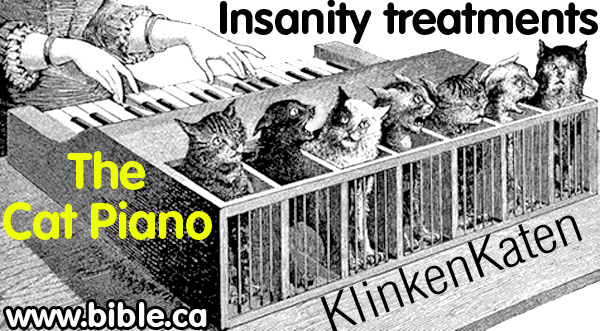
- In 1806 AD, Sir
Charles Bell, Artist, describes how madness begins in the spirit moves
to affect the body, seen in the facial expressions. "to lay a foundation for studying the influence of the
mind upon the body" This is rather obvious, but in fact
rejected by chemical psychiatry today, which views man as a pile of
chemicals and the mind
as a non-existent myth. Unlike Lavater (Essays on physiognomy,
1789 AD) who interpreted the bone structure of the face as a roadmap to
intelligence and madness, Bell understood that a person whose spirit is
continually under anxiety, will show up in the face through muscle and
wrinkle patterns. Bell was a forerunner of body language expert, Tonya
Reiman. As an artist Bell had visited Bedlam and was surprised to learn
that some of his own stereotypes of the insane were wrong, before he
visited. The visit gave his a whole new view of insanity. Written to coach
painters, Bell's book opens a window into the etiology of madness just
before the torture at Bedlam came to
an end. He backs up his belief that the spirit has a direct effect upon
the body by quoting Dr. James Beattie, "Descartes,
and some other philosophers, have endeavoured to explain the physical
cause which connects a human passion with its correspondent natural sign.
They wanted to show, from the principles of motion, and of the animal
economy, why fear, for example, produces trembling and paleness; why
laughter attends the perception of incongruity; why anger inflames the
blood, contracts the brows, and distends the nostrils; why shame is
accompanied with blushing; why despair fixes the teeth together, distorts
the joints, and disfigures the features; why scorn shoots out the lip; why
sorrow overflows at the eyes ; why envy and jealousy look askance ; and
why admiration raises the eyebrows and opens the mouth. Such inquiries may
give rise to ingenious observation, but are not in other respects useful,
because never attended with success. He who established the union of soul
and body knows how and by what intermediate instruments the one operates
upon the other. But to man this is a mystery unsearchable. We can only say
that tears accompany sorrow, and the other natural signs their respective
passions and sentiments, because such is the will of our Creator, and the
law of the human constitution." It is important to remember
that Bell viewed the facial expressions of emptiness or anger seen in a
madman as the result of emotions felt in the spirit. (Essays
on the Anatomy of Expression in Painting, Sir Charles Bell, 1806 AD)
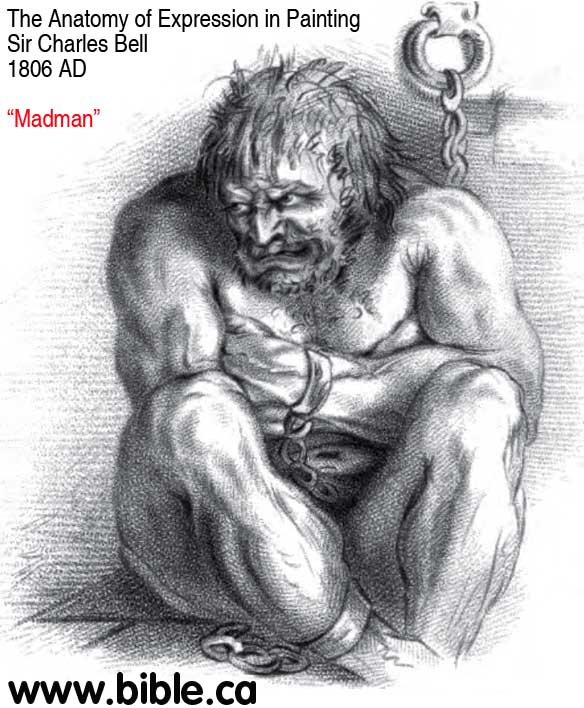
- In 1806 AD, Philippe Pinel,
doctor for the Bicetre Asylum in France, gets our gold star of achievement
of all the major mad house doctors. Pinel correctly understanding that
insanity was a spiritual problem, not an organic/physical problem with the
brain. Instead of drugs,
he cured insanity by "moral treatments". "My faith in pharmaceutic preparations was gradually lessened,
and my scepticism went at length so far, as to induce me never to have
recourse to them, until moral remedies had completely failed"
His views were in fact what church preachers had understood since before
the 1500's. Pinel describes the treatments practiced at Bedlam as a,
"depleting system of treatment to a state of
extreme debility or absolute idiotism", his views were
remarkable correct and chemical
psychiatrists of today should learn at his feet. D. D. Davis, stated
in the introduction that "The inestimable
importance of moral management is the great key note sounded by the
present author almost in every subdivision of his treatise ... for
subduing the extravagances and arresting the hallucinations of the insane"
Pinel's moral treatments cured people in: "chaos
and confusion ... gloomy and desponding melancholy ... furious ...
perpetual delirium ... violent sallies of maniacal fury ... stupid
ideotism and imbecility." He rejects the etiology that brain
legions caused insanity and identifies this error as the reason doctors of
his time also viewed the insane as incurable. This is exactly what we see
today when chemical psychiatrists view insanity as a chemical imbalance in
the brain and you labeled
for life as a mental biologic misfit. He reveals his "great and invaluable secret in the management of well
regulated hospitals" is understanding that insanity is not an
incurable organic disease, but a curable condition caused by the human
spirit "nervous excitement" which
he said affects both body and the way people think: "affects not the system physically by increasing muscular
power and action only, but likewise the mind". He describes
his "moral treatment" as such: "we
trace the happy effects of intimidation, without severity; of oppression,
without violence; and of triumph, without outrage. How different from the
system of treatment, which is yet adopted in too many hospitals, where
the. domestics and keepers are permitted to use any violence that the most
wanton caprice, or the most sanguinary cruelty may dictate."...
"I saw a great number of maniacs assembled
together, and submitted to a regular system of discipline. ... I then
discovered, that insanity was curable in many instances, by mildness of
treatment and attention to the state of the mind exclusively, and when
coercion was indispensible, that it might be very effectually applied
without corporal indignity. As a Frenchman, he gives the credit for
the "experimental" concept of "moral treatment" to the
English: "I Have given a sufficient number of
examples to illustrate the importance which I attach to the moral
treatment of insanity. The credit of this system of practice has been
hitherto almost exclusively awarded to England." Penel was a
humoral doctor and did believe a bit of quacky stuff. He rejected
phrenology in all cases of insanity "the
heads of maniacs are not characterised by any peculiarity of conformation",
although he inconclusively wondered if physiognomy might explain
"idiots" with diminished brain capacity: "double the ordinary density. From the extraordinary
thickness of this skull, it would be easy to calculate how much the
internal capacity of the cranium was diminished". Finally,
Echoing the fact that even today there are no medical tests that can
detect insanity, Pinel notes that there is no real test for insanity back
in his day either: "It may be thought
astonishing, that in an object of so much importance as that of
ascertaining the actual existence of mental derangement, there is yet no
definite rule to guide us in so delicate an examination. In fact, there
appears no other method than what is adopted in other departments
of natural history: that of ascertaining whether the facts which are
observed belong to any one of the established varieties of mental
derangement, or to any of its complications with other disorders."
Philippe Pinel would rise up today and oppose the chemical psychiatrists
who believe insanity is a chemical imbalance of the brain, that insanity
is incurable. He would object to labeling the insane as biological
misfits for life because it unnecessarily robs the soul of all hope. (A Treatise on
Insanity, Philippe Pinel, 1806 AD)
Pinel's table demonstrates his non-biological etiology of insanity

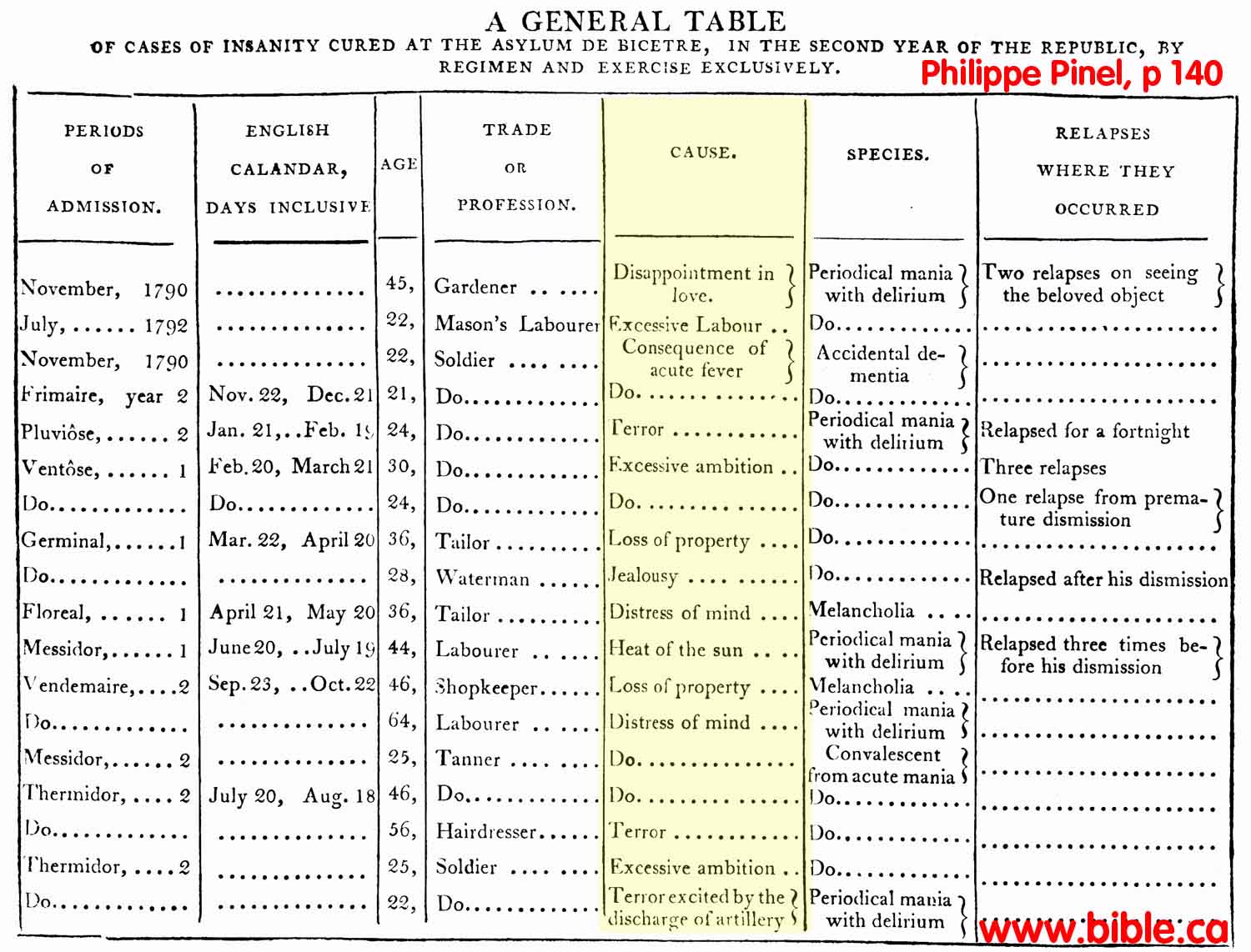
- In 1811 AD, Joseph
Mason Cox, doctor, popularized a form of torture that cured insanity
called "the swing". John
Monro, (1758 AD) used "vomits" to cure insanity: "vomiting is
infinitely preferable to any other". Cox invented the
swing as a way to induce vomiting without the use of drugs (emetics). The
swing became a treatment of choice for 100 years in various. Many different
machines were invented to spin people into motion sickness so they would
vomit. This was a proven method of curing insanity. It worked by making
people feel miserable and break down their will to engage in "insane
behaviors". Cox described the swing as, "both a moral [discipline] and medical
mean in the treatment of maniacs." It was widely used and
believed to be the preferred treatment to cure insanity: "Though we cannot accurately explain in what way the best
remedies promote relief in madness, yet we have the most unequivocal
proofs that those which occasion a degree of vertigo, often contribute to
correct the morbid state of the intellect, and no one of them is so well
calculated to produce this effect as the swing." The swing
spun an insane, uncontrollable and obstinate person in a straitjacket
until motion sickness, vomiting, unconsciousness and shock set in. When
they began begging to get out of the machine, they would be asked if they
would obey orders. The person would then be put to bed and sleep until
they recovered. Often the person would become obstinate again and they
would be put back in the swing again only to repeat the process until full
compliance was attained. Citing a specific case, Cox says, "all his promises were forgotten ... next day the swing
was repeated as before ... entreated to be relieved, and repeated his
former promise ... [next day] his former mental peculiarities soon after
returning, the swing was prepared, and the necessary steps taken for its
employment, but rather than repeat the ride in the whirligig, as he termed
it, he submitted entirely to my wishes, and, with some occasional returns
of obstinacy and disinclination to persist in the remedies I prescribed, I
had the pleasure to see him gradually improve till he advanced to perfect
reason." Another case of an insane man put in the swing:
"I was determined to try the effects of the
circulating swing as a last resource, into which he was placed as an
inanimate lump, with his eyes shut; after a few circumvolutions one eye
was observed to be occasionally opened, and at length both, a degree of
alarm seemed next excited, then nausea, and retching to vomit; the motion
was then suspended, and he was consulted as to his unwillingness to comply
with my requisitions, but he still refusing, the gyrations were renewed,
when the former effects were soon obvious, and the motion being increased,
full vomiting ensued; he now begged to be liberated, and promised
compliance with my wishes; he was taken out, put to bed, and slept for
some hours, when food was offered, but, as usual, refused; he was reminded
of his promise, and threatened with an immediate repetition of the swing;
this succeeded, and for some days the prognosis seemed more favourable,
but the reluctance to eating returned, and recourse was again had to the
swing, two or three times, with the former success, till at length he
yielded entirely to my wishes, and by very simple management, both mind
and body were at length perfectly restored, and I have the pleasure of knowing
that he continues well, and I am confident owes his life and reason to the
swing." Like Patrick Blair's water
treatment in 1725 AD, the swing was a similar form of torture that
brought about true cures of insanity. What is clear from all this that the
cure worked because insanity is not a chemical imbalance in the brain or a
bodily disease. It is a spiritual choice made by the person. The chair
would cure a good many in today's mental hospitals but civil liberties
violations would not allow it. (Practical
observations on insanity, Joseph Mason Cox, 1811 AD)
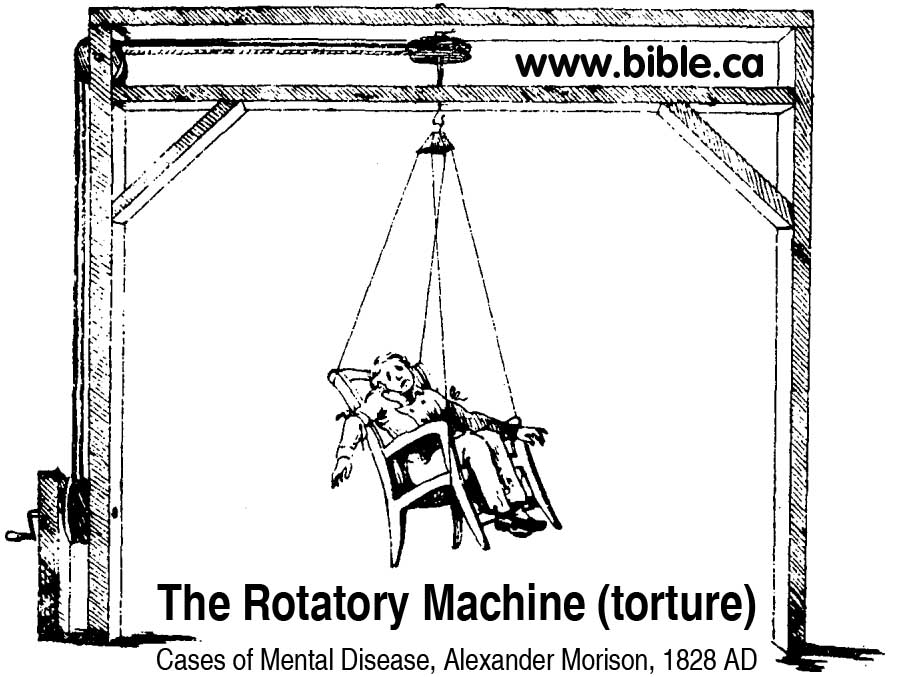
- In 1812 AD, Benjamin
Rush, a doctor known as the "father of modern psychiatry",
believed that madness was caused by blood vessels in the brain and cured
it by threatening to kill the insane if
they did not cure themselves! Rush suffers from
"scholastic schizophrenia" because he devotes an entire section
to, "The causes which induce intellectual
derangement, by acting upon the body through the medium of the mind".
From an etiological viewpoint, it is clear that Rush believed that the
human spirit through emotion, feelings and guilt for sin actually
"induced" insanity. So in one breath he says insanity is caused
by blood vessels and in the other the human spirit. The only way to cure
Rush of his "scholastic schizophrenia" is to suggest that the
human spirit affected the blood vessels in the brain, which then caused
madness. Of course his medical views were quackery because blood vessels
in the brain have nothing to do with insanity. So lets take a closer look
at the hero and founder of chemical psychiatry that today believes
insanity is caused by mythical
chemical imbalances of the brain that are as much quackery as Rush's
idea that blood vessels cause madness! Rush believed that voluntary sins
like murder, theft, lying and drunkenness, progressed into a disease where
the person committed these sins involuntarily the same way a spasm affects
a muscle. He concluded that these kinds of sins, became involuntary, they
became a disease which needed a medical doctor to treat. Rush therefore
believed that insanity was outside a person's will and that they are
"not cognizable by law". This is the earliest forms of the
insanity laws we see today, where everyday sins are called "diseases
of the will". [insanity] acts without a
motive, by a kind of involuntary power. Exactly the same thing takes place
in this disease of the will, that occurs when the arm or foot is moved
convulsively without an act of the will, and even in spite of it ...
I have called it MORAL DERANGEMENT. I have selected those two symptoms of this disease (for
they are not vices) from its other morbid effects, in order to rescue
persons affected with them from the arm of the law, and to render them the
subjects of the kind and lenient hand of medicine. But there are several
other ways, in which this disease in the will discovers itself, that are
not cognizable by law. I shall describe but two of them. These are, LYING
and DRINKING. Because the insane were not acting on free will, Rush
set up "Sober House", (for drunks) where
they could be "held against their will". Incredibly, he
reasoned: "Let it not be said, that confining
such persons in a hospital would be an infringement upon personal liberty,
incompatible with the freedom of our governments." He was
fully aware that many viewed insanity as a spiritual problem that affects
the body: "I know it has been said in favour
of madness being an ideal disease, or being seated primarily in the mind".
But he considered all the medical views of madness and rejected them all:
"liver, spleen, intestines, nerves, Madness
has been placed exclusively in the mind" in favor of, "the cause of madness is seated primarily in the
blood-vessels of the brain". From autopsies, he noted that mad
people had brains that were "hardness and
dryness ... softness ... enlargement or reduction of the skull bone
thickness." This echoes the views of Giovanni
Morgagni, who in 1761 AD concluded from autopsies, that madness caused
"considerable hardness in the brain"
Amazing what you can conclude by poking your finger in the brain of dead
madmen! Rush notes specific spiritual causes of madness induced by the
human spirit: "Intense study",
"frequent and rapid transition of the mind
from one subject to another", "constant
exercises of the imagination in poets", memorization: "undue labour in committing his [clergyman] sermons to memory", "Extravagant joy produced madness", " Charles the Sixth, of France, was deranged from a
paroxysm of anger", " Terror has
often induced madness in persons who have escaped from fire, earthquakes
and shipwreck", " Fear often
produced madness", " Distress
often produced this disease", "
Public humiliation: "A player destroyed himself in Philadelphia, in
the year 1803, soon after being hissed off the stage", " Homesickness: "Swiss soldiers sometimes languish
and die from that form of madness which is brought on by absence from
their native country", " Africans
become insane, ... soon after they enter upon the toils of perpetual
slavery in the West Indies", "
Hundreds have become insane in consequence of unexpected losses of money",
" clergyman in Maryland became insane in
consequence of having permitted some typographical errors to escape in a
sermon which he published upon the death of general Washington",
"Several instances of madness, induced by the
cruel or unjust conduct of schoolmasters and guardians",
"persons who destroyed themselves immediately
after drawing high prizes in a lottery", " A conscience burdened with guilt, whether real or
imaginary, is a frequent cause of madness", " Intellectual derangement is more common from mental
than corporeal causes. Of 113 patients in the Bicetre Hospital in France,
at one time, Mr. Pinel tells us 34 were from domestic misfortunes, 24 from
disappointments in love, 30 from the distressing events of the French
Revolution, and 25 from what he calls fanaticism. Of course all the
above proves that Rush was very aware that the choices of the human
spirit, guilt, sin and circumstances were the real etiology of madness. He
then makes observation as to who is predisposed to insanity: "A predisposition to madness is said to be connected with
dark coloured hair", " Women ...
are more predisposed to madness than men", " Certain occupations predispose to madness more than
others. Pinel says, poets, painters, sculptors and musicians, are most
subject to it", " mechanics to be
more affected with madness than merchants and members of the learned
professions.", " Certain climates
predispose to madness. - It is very uncommon in such as are uniformly warm",
And last but not least, "Different religions,
and different tenets of the same religion, are more or less calculated to
induce a predisposition to madness. ... There are certain tenets held by
several protestant sects of Christians which predispose the mind to derangement".
In a section called, "Remedies of Mania" he spells out his cures
and controls for the insane including his famous tranquillzer chair that
calmed down the madman and relieved the stress on the blood vessels in his
brain: "Confinement by means of a strait
waistcoat, or of a chair, which I have called a tranquillzer."
The Tranquilizer Chair forced the person to calm down by restricting
movement. It indeed worked by bring the unruly into submission the same
way Cesar Millan, the Dog Whisperer, pins a violent pit bull to the ground
on its side until it surrenders. Rush further suggested: "Privation of their customary pleasant food [no
pizza and cigarettes]", "Pouring cold
water under the coat sleeves, so that it may descend into the arm pits,
and down the trunk of the body. [probably more effective on women
who make you roll the windows up on your car and turn the heat up, than
men...]" "Low DIET, consisting wholly of
vegetables, and those of the least nutritious nature." "Salivation induced by mercury with calomel (teething
powder) was seen as a "cure of hypochondriac
derangement". "We come next to mention
the remedies that are proper to act upon the body through the medium of
the mind: absurdity, folly, cruelty ... music ... terror ... fear, accompanied with pain, and a sense of
shame" In a spectacular grand finale of cures from the Father
of modern psychiatry himself, when all else fails threaten to murder the insane! On page 181
Rush gives this account: "If all these modes
of punishment should fail of their intended effects, it will be proper to
resort to the fear of death. Mr. Higgins proved the efficacy of this fear,
in completely subduing a certain Sarah T , whose profane and indecent
conversation and loud vociferations, offended and disturbed the whole
hospital. He had attempted in vain by light punishments and threats, to
put a stop to them. At length he went to her cell, from whence he
conducted her, cursing and swearing as usual, to a large bathing tub, in
which he placed her. "Now, (said he) prepare for death. I will give
you time enough to say your prayers, after which I intend to drown you, by
plunging your head under this water." She immediately uttered a
prayer, such as became a dying person. Upon discovering this sign of
penitence, Mr. Higgins obtained from her a promise of amendment. From that
time no profane or indecent language, nor noises of any kind, were heard
in her cell." It is clear that Rush, followed the practice of
the day to torture the insane into submission as was currently in practice
at Bedlam,
for he says, "By the proper application of
these mild and terrifying modes of punishment, chains will seldom, and the
whip never, be required to govern mad people. I except only from the use
of the latter, those cases in which a sudden and unprovoked assault of
their physicians or keepers may render a stroke or two of a whip, or of
the hand, a necessary measure of self-defense." So although
Rush believed madness was caused by brain vessels, we today, know he was
wrong. His observations about how the human spirit can induce madness
though emotion and his corporal methods of controlling and curing the
insane are good and valid. Clearly these effective treatments would never
be used today for a long list of obvious reasons, but the fact remains
that they did work! Modern chemical psychiatry believes insanity is cause
by a chemical imbalance but cannot account for how such "moral
treatments" cured the insane. These "moral cures" prove it
is not a bodily disease but a spiritual choice of freewill moral agents.
So this is the "hero of modern psychiatry" with his
Tranquillizer Chair and threats of murder and bloated brain blood
vessels! (Medical
Inquiries and Observations Upon the Diseases of the Mind, Benjamin
Rush 1812 AD)
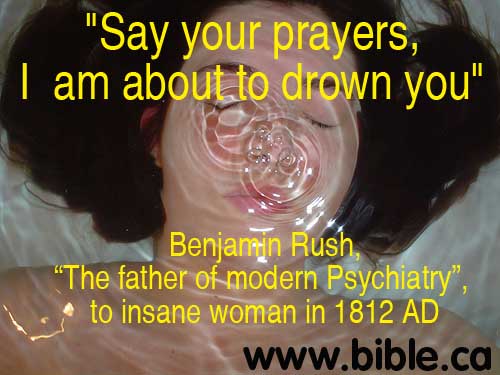
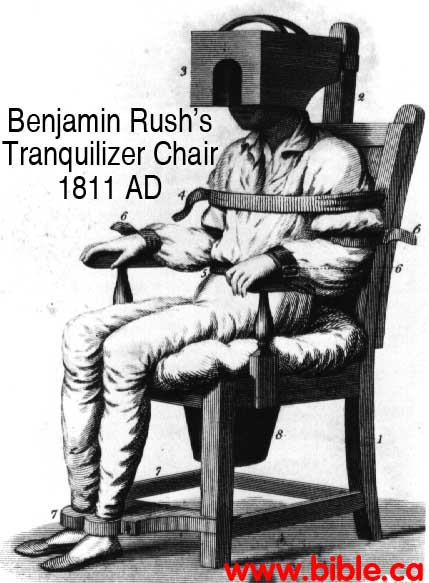
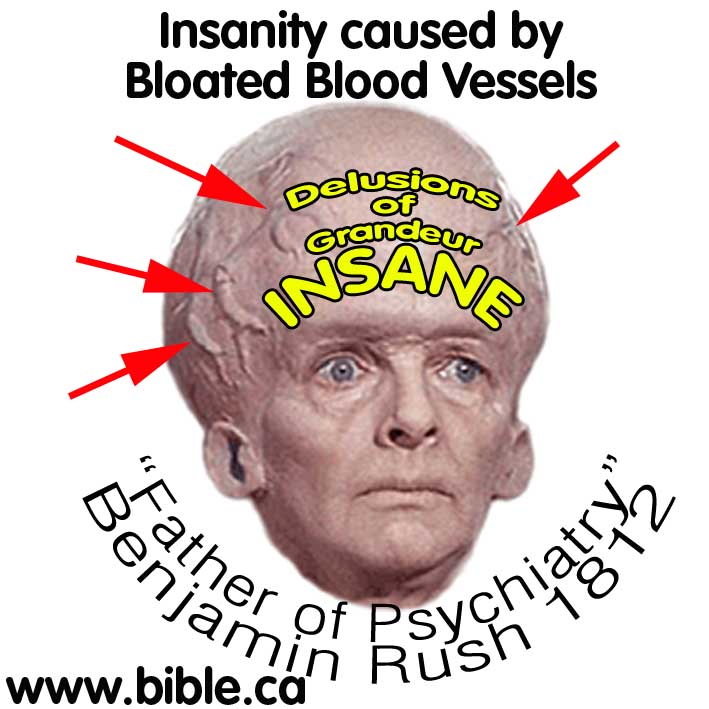
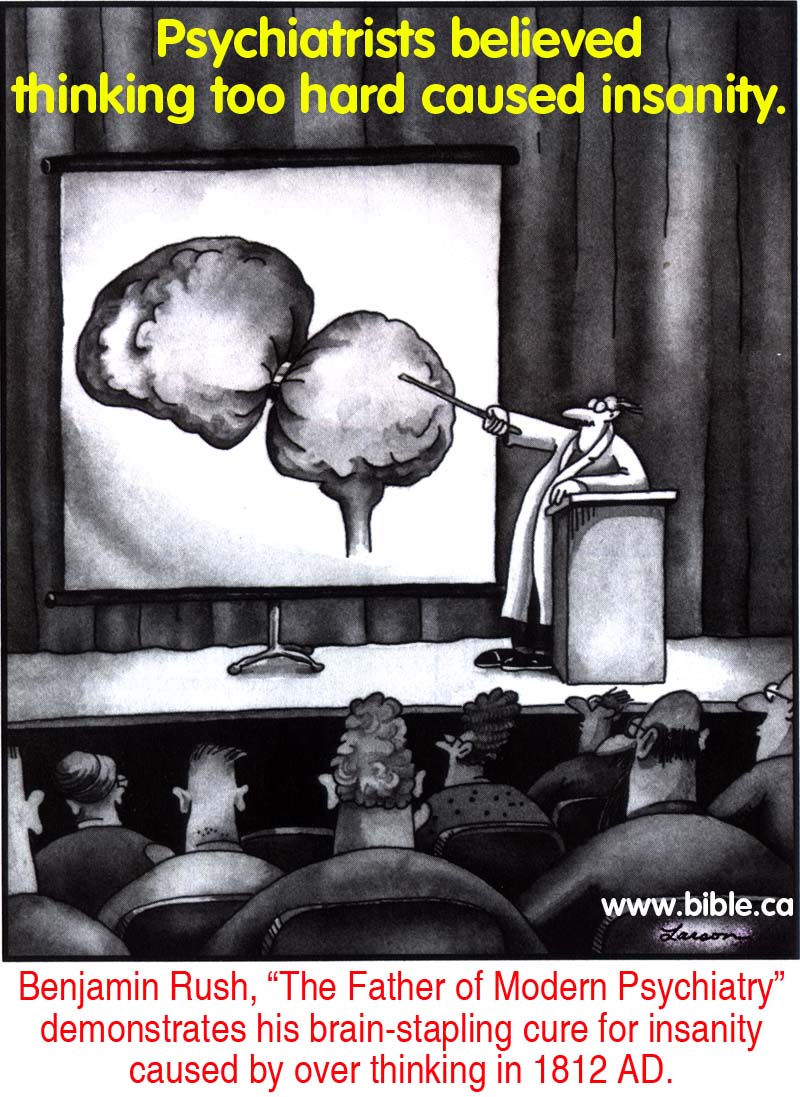
- In 1813 AD, Samuel
Tuke, minister for Quakers, devoted his life to the Retreat for the
insane at York. Although he was unsure if the cause of insanity was
spiritual/mind, or physical/body, but he strongly leaned towards the
spiritual/mind etiology. "If we adopt the
opinion, that the disease originates in the mind, applications made immediately
to it, are obviously the most natural; and the most likely to be attended
with success. If on the contrary, we conceive that mind is incapable of
injury or destruction, and that, in all cases of apparent mental
derangement, some bodily disease, though unseen and unknown, really
exists, we shall still readily admit... In the present imperfect state of
our knowledge, of the very interesting branch of the healing art, which
relates to the cure of insanity; and unable as we generally are to
ascertain its true seat in the complicated labyrinths. He made a
powerful disclaimer against those who believed insanity was a physical
disease: "We are, however, far from adopting
it as a universal maxim, that maniacal symptoms are aggravated by bodily
disorder." Most important, he believed the insane never lost
their self control or freewill in action. "that
madness, in all its forms, is capable of entire control".
Unlike the tortures that took place at other mad houses, Tuke's treatments
were kind and gentle, like warm baths: "The
power of judicious kindness over this unhappy class of society, is much
greater than is generally imagined." "The comfort of the patients is therefore considered of
the highest importance, in a curative point of view." He
highly questioned the standard practices of the day: bleeding, blisters,
seatons, evacuants, cold baths, although he did practice them all at times
as a lasts resort in isolated cases. He understood the importance of a
good nights sleep and recommended lots of food, rather than opium: "difficulty of obtaining sleep for maniacal patients, and
the unpleasant effects frequently produced by the use of opium ...
however, a liberal supper would perhaps prove the best anodyne."
He, like Pinel,
used coercion, but much less than the other mad houses. The famous quote
that Tuke "never allowed the use of chains" is misleading, since
he invented a bed sized strait jacket with leather straps for all limbs,
chest and waist to confine out of control people. "At each end is a leather strap one foot long, one inch
and a half broad, and a quarter of an inch thick ; with a buckle fastened
at the joining of the web and strap". So while Tuke refused to
use chains of steel, but invented "chains of leather". In
addition to straitjacket and confinement, Tuke used fear and intimidation
with rewards and punishments for good and bad behaviour. He also used peer
pressure to humiliate the insane into submission. He did not try to change
the delusional thinking of the insane, but he expected them to pull their
weight and behave like those who were not delusional. This model of
functional delusion, is like saying: Let the delusional wives believe what
they want as long as they do the dishes... and the delusional men can
believe their delusions, as long as they go to work each day to support
their families. The fundamental concepts Tuke used in the treatment of the
insane were their inherent ability to exercise self control because
insanity was a spiritual problem, not bodily disease. He noted that the
insane die much younger than the general population: "melancholic patients seldom live long ... many die
before thirty or forty". All of Tuke's treatments (attending
church, kindness, coercion, warm baths, humiliation) pointed to the fact
that he correctly suspected insanity was not a bodily disease, but caused
by life choices and circumstances. (Description
Of The Retreat For Insane, Samuel Tuke, 1813 AD)

- In May 1814 AD, the case of torture and confinement of
William Norris led to the dismissal of the pharmacist and psychiatrist at
the Bedlam
asylum a year later! "William Norris, aged fifty-five, in the
apparatus by which he had been confined for at least ten years (evidence
of the exact length of time was conflicting) when he was discovered in May
1814 by Edward Wakefield, MP, and a party of gentlemen in 'one of the
cells on the lower gallery' in Bethlem Hospital. Some weeks later he was
freed but died in February the following year from 'a very considerable
disease of the lungs; a consumption' according to Sir William Lawrence who
conducted the autopsy. This etching was made from the original drawing
executed on the spot on 7 June 1814 at Wakefield's request and exhibited
by him to The Select Committee of the House of Commons appointed to
consider of provision being made for the better regulation of madhouses,
1815. The discovery of this horrible example of restraint and neglect
roused public feeling and set the machinery in motion which ultimately led
to the dismissal of Bethlem Hospital's apothecary and physician."
(300 years of Psychiatry, Richard Hunter, 1963, p 695)
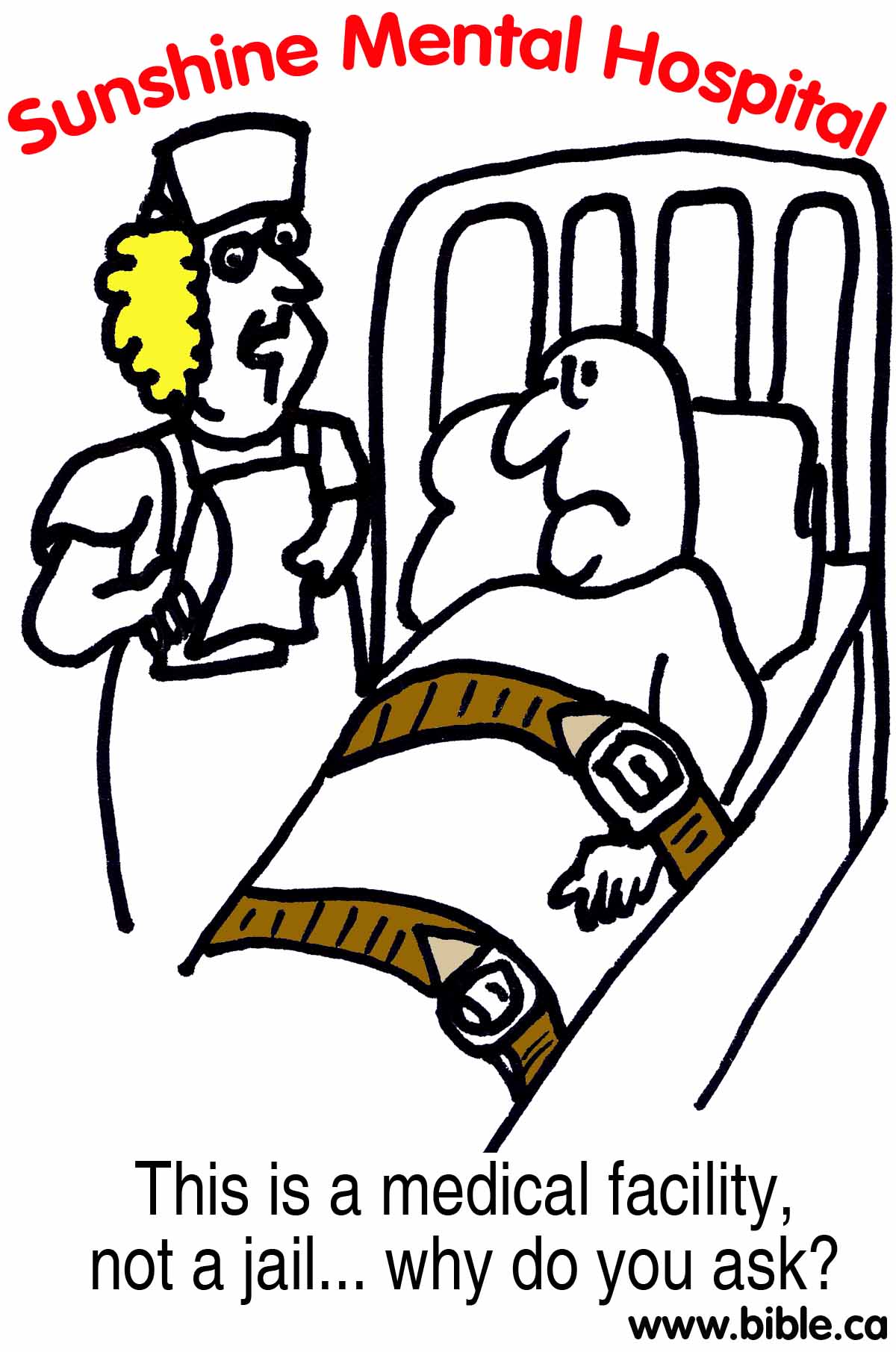

- In 1815 AD, Franz
Joseph Gall and Johann
Gaspar Spurzheim came up with a new and improved version of the
junk-pop psychology theories of Lavater's physiognomy,
who taught the shape of a persons skull determined their mental abilities.
Phrenology
taught that the shape and size of the joints between the 22 bones of the
human skull, determined all mental and personality traits. "he [Gall] observed any mechanician, musician,
sculptor, draughtsman, mathematician, endowed with such or such faculty
from birth, he examined their heads to try whether he might point out a
particular development of some cerebral part. In this way, he found in a
short time, in musicians and mechanics, the development of particular
cerebral parts. ... individuals who from
birth were stubborn, proud, courageous, thieves, murderers, religious
&c., and if he found that the size of some cerebral part was
corresponding to these actions, he called these parts of the brain, organ
of pride, of firmness, of courage, of theft, of murder, of religion
.. . He [Gall] was also bold enough to speak to
every person in whose head he observed any distinct protruberance" Phrenology
was later popularized by Samuel Wells in 1891 AD. This tradition of quack
psychiatry continues today with the God
Helmet in 2002 AD, where magnetic impulses on the side of the are supposed
to generate spiritual experiences in the wearer. Poor gullible atheist Richard
Dawkins actually tried on the God Helmet. How else could he expect to
see God? So the stupid junk science of phrenology has a dark tradition
that continues into modern chemical psychiatry. Gall taught that since a
person's mental and moral characteristics are determined by the shape of
the skull he was born with, criminals really couldn't be blamed for their
crimes. This thinking is seen today in the insanity
plea and chemical
evolutionary psychiatrists. "In criminology he advocated reform
by re-education rather than punishment and suggested at a time when the
criminal was thought to be made and not born, that there were degrees of
responsibility proportionate to innate propensities which could also be
determined by craniological examination. In this he anticipated much of
Lombroso's work at the end of the century as well as the concept of
irresistible impulse and diminished responsibility." (300 years of
Psychiatry, Richard Hunter, 1963, p 711) (The
Physiognomical System of Franz Joseph Gall Johann Gaspar Spurzheim,
phrenologists, phrenology, 1815 AD)
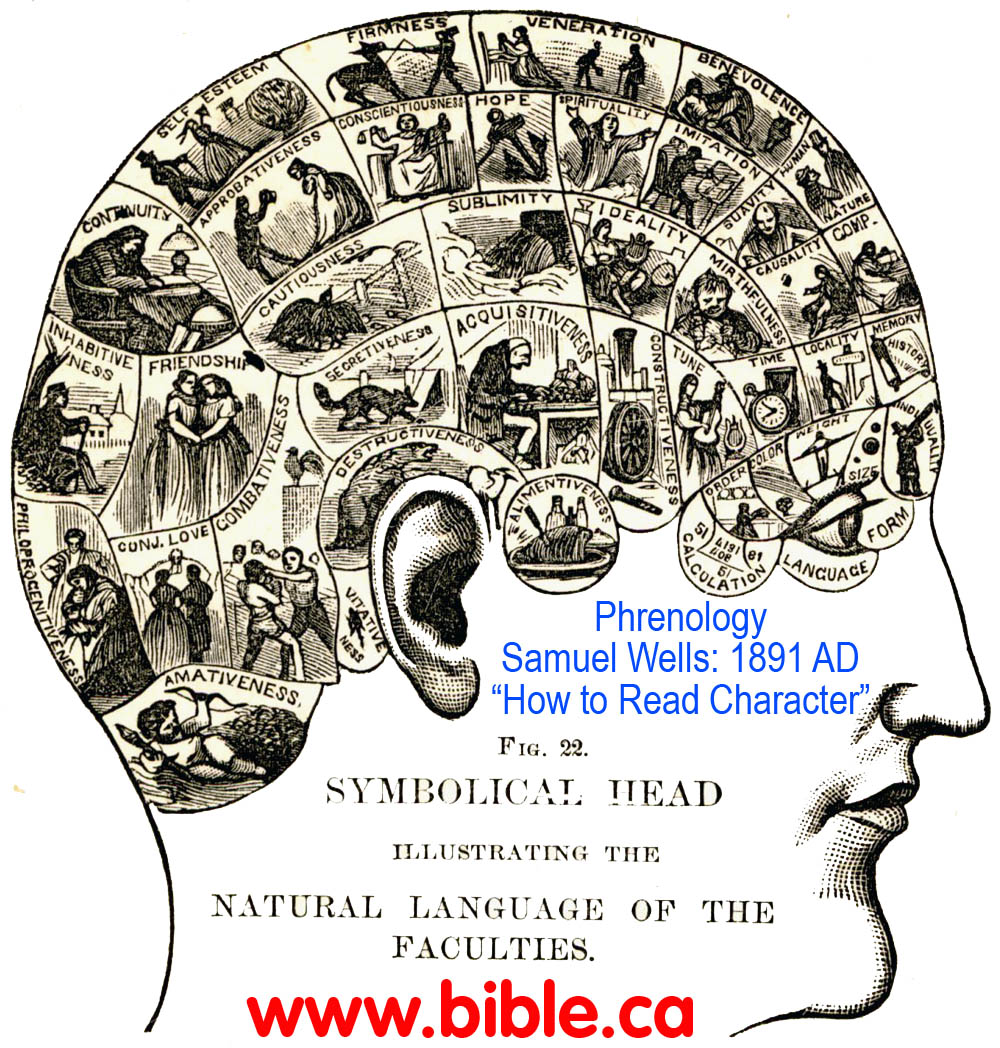
- In 1818 AD, William
Saunders Hallaran, Doctor, described the use of the swing in the
Lunatic Asylum of Cork, England as "a safe
and very effectual remedy for the description of maniacs". He
fully credits Joseph
Mason Cox, 1811 AD with the invention which induced the vomiting
without (emetics). Remember that John
Monro raved about vomits as a cure for insanity. "The circulating swing erected in our asylum, appears to
be improvement on the model suggested by Doctor Cox. It is worked by a
windlass, and capable of being revolved a hundred times in a minute"
... "from repeated trials, I can confidently
declare, that its efficacy, to the extent alleged by Doctor Cox, appears
to be incontrovertibly ascertained" ... "This method of subduing furious maniacs, has succeeded
in an admirable manner". Hallaran was the primary doctor for a
major asylum and testified boldly that the swing cured the insane to his
surprise! "The advantages to be derived from
the swing, in the intermitting form of insanity, cannot be too highly
estimated. Several proofs of its superior efficacy have come within my
observation, where, immediately on the approach of the paroxysm, the
symptoms had nearly subsided on the first effort." The key was
to bring those who are out of control, into submission: "I have generally found patients to become at once so
subservient to my wishes, as willingly to take any medicine prescribed."
... "inflexible maniacs already referred to;
on whom no influence can be exerted sufficient to effect a medical purpose
... I have generally found patients to become at once so subservient to my
wishes, as willingly to take any medicine prescribed." The
common practice of torture in mad houses of the 18-19th centuries included
the swing, bloodletting, vomits, isolation and chains. These methods
indeed cured the insane in the same way a spanking fixes the bad behaviour
of a two year old. The chair was the new treatment of choice because it
induced vomits without drugs. And it worked, proving that mental illness
is not a bodily disease, but a moral choice of the madman within his power
to control and change. Incurables were those who did not respond to any
known treatment, yet the chair cured them! "In
several cases of continued insanity of long standing, where the swing had
been employed as a last resource, I have been most agreeably surprised at
the unexpected alteration which was effected after a few trials. In some
who, from their disposition to violence, and who, from necessity, were
closely confined to solitary apartments, it had so far succeeded, as not
only to render them easy of access, but also to induce kind and gentle
manners; effecting in the end, the most willing service in the daily
occupations of cleansing, and attendance on the sick." The
insane have always been in full control of their own actions and the chair
is an effective method of aversion therapy that works! Later, Sir
Alexander Morison, 1828 AD, would also adopt the swing which induced
motion sickness and brought about compliance from the insane. (Practical
Observations on the Causes and Cure of Insanity, William Saunders
Hallaran, 1818 AD)
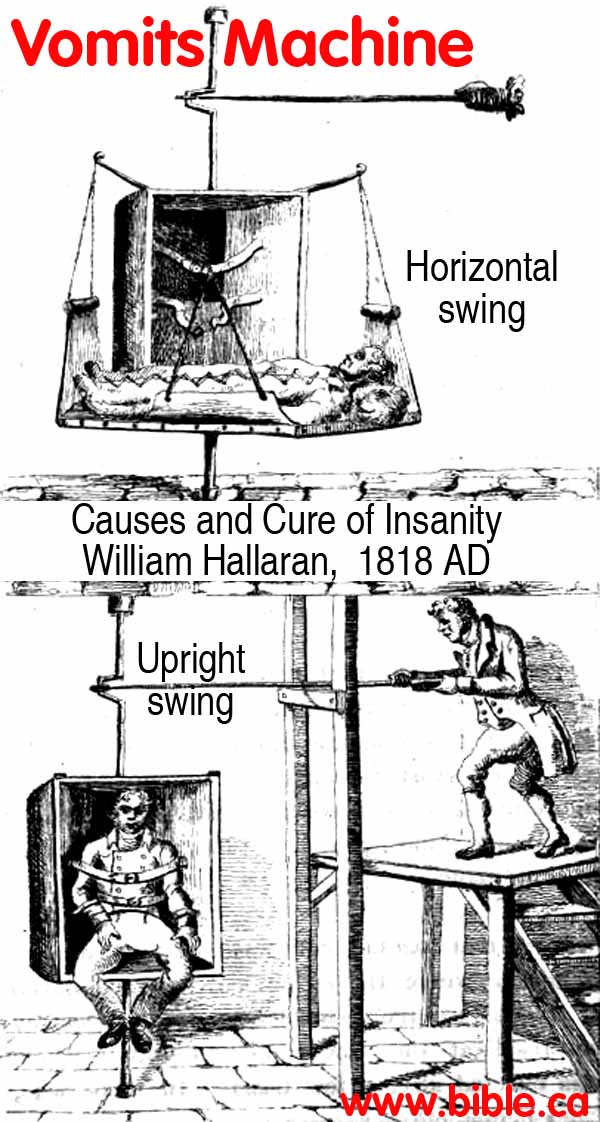
- 1818 AD, Urbane
Metcalf, a Patient at Bedlam, gives a
shocking first hand account of what it was like to be "treated"
for insanity at Bedlam. He was a patient before and after Parliament fired
the doctors and staff at Bedlam in 1815 AD because he had reported how a
keeper named Blackburn murdered a patient named Fowler: "Fowler, who one morning was put in the bath by
Blackburn, who ordered a patient then bathing, to hold him down, he did
so, and the consequence was the death of Fowler, and though this was known
to the then officers it was hushed up; shameful". He describes
a keeper named Davis as a, "cruel, unjust and
drunken man, and for many years as keeper secretly practised the greatest
cruelties to those under his care". He described another
keeper named Rodbird, that he is as "an idle,
skulking, pilfering scoundrel". He describes how the butcher
stole from the patients their portion of food for personal gain: "Mr. Vickery the cutter [butcher], has it in his power to
defraud the patients in many instances...". Metcalf stands as
the final witness that helped forever change the kinds of brutal physical
torture and neglect that existed in the largest English insane asylums for
over 100 years. (The
Interior Of Bethlem Hospital, Urbane Metcalf, 1818 AD)
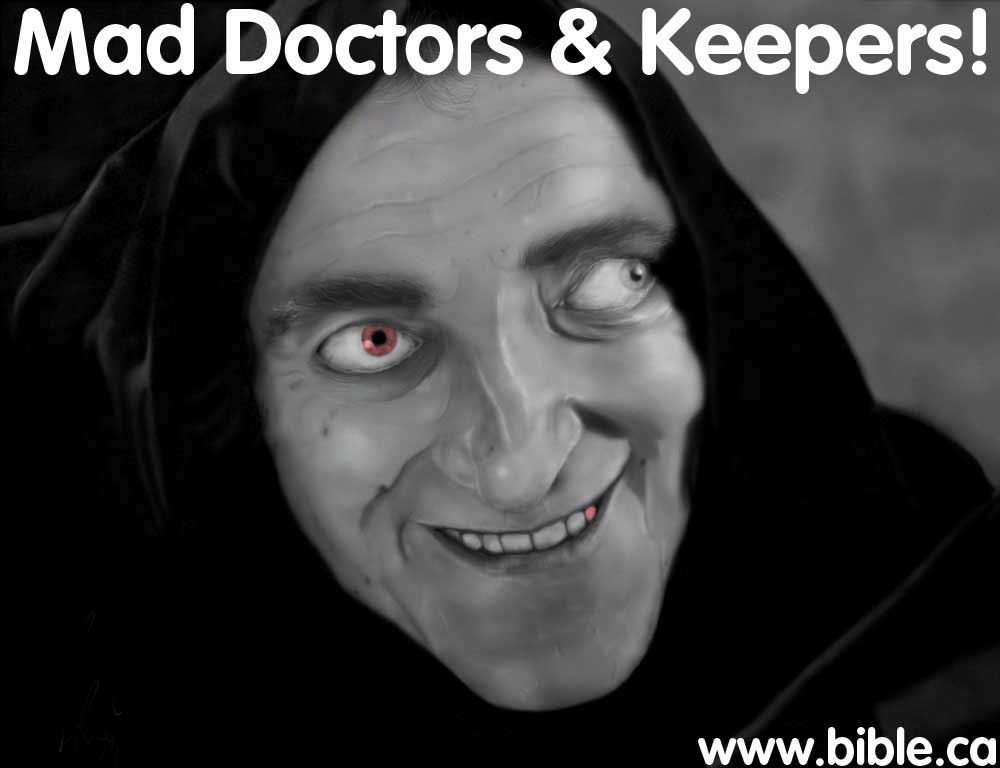
- In 1818 AD, Johann
Christian August Heinroth, Doctor and Christian, invented the term
"psychosomatic". He clearly stated that insanity was not a
bodily illness, but a spiritual choice that violates the conscience that
is caused by sin and selfishness: "They
[mental illnesses] all have a common starting point, a main principle to
which they are subordinated: selfishness". "This presents a difficult problem indeed for the
world-man and the Self-man, who, till now, has been accustomed to live and
seek his consciousness in these two elements alone. Nevertheless, if the
voice of his conscience has indeed come awake, he will have no other
choice. He must either live in permanent dissatisfaction, permanently
divided against himself and his destiny, or else must obey the demands of
his conscience, which is his only means of preserving unity and harmony
within himself. His only other course is to deliberately kill his
conscience, and thus gain apparent peace of mind bought at the price of
self-stupefaction." He then goes on to reject all the humoral
the causes that most other doctors believed caused insanity. This is
remarkably way ahead of his time for a doctor: "The views held on this subject, from antiquity to our
own days, are almost ridiculous: black and yellow bile; the melancholic
juices in general; the darkened spirits of life; malignant demons; the
moon; excessive elasticity of brain moisture; diseased congestion of the
cerebral vessels; sthenia or asthenia (excitement and collapse) of the
brain (even though these two ideas are not without importance); each of
these has at one or the other time been held to constitute the immediate
cause, and the immediate cause was usually confused with the disease
itself." Heinroth adopts the Christian view that man has a
distinct body and soul: "Our inner being, or our
inner I, is our soul, while our external Self is our body."
Heinroth openly discusses the fact that many doctors believe that insanity
is a bodily illness. He rejects this entirely: "A great controversy centers on the question whether the
various forms of morbid conditions of the psyche originate and have their
seat in the life of the soul, or in the body, namely, in an overexcited,
deranged, decayed, disorganized brain ... there
is still a tendency to attribute the cause of mental disturbances to the bodily
rather than to the spiritual side. To this we have already answered: the
body alone is nothing, it has no significance in itself, but only as
related to the soul or to the spirit in the wider meaning of the word,
since in this life it is the body which is the carrier, supporter, and
tool of the soul and of the spirit. This is most clearly indicated by
human consciousness, without which there is no human life; and who would
contradict his own consciousness?" Heinroth understood that
often, there was nothing physically wrong with the insane. "The complete concept of mental disturbances includes
permanent loss of freedom or loss of reason, independent and for itself,
even when bodily health is apparently unimpaired, which manifests itself
as a disease or a diseased condition, and which comprises the domains of
temperament, diseases of spirit and will." Heinroth believes
that the insane have brought it on themselves by their own choices: "A man is not an animal ... his consciousness, his
reason, lead him towards the Deity. That this so rarely happens is his own
fault; and this guilt gives rise to all evils that beset him, including
the disturbances of the soul." He places the blame for those
who are insane squarely upon themselves, their personal choices and self
deception: "Anyone imprisoned by passion is
unfree and unhappy. The man who is fettered
by passion deceives himself about external objects and about himself. This
illusion, and the consequent error, is called madness. Madness is a
disease of the reason and not of the soul, but it originates from the
passion within the soul." Heinroth understood that the mind
can make the body sick and the body can affect the way one feels, he
believed that in the majority of cases, insanity was caused by the soul
alone. "no longer inquire if the soul
disturbances are bodily affections (we fully agree that they cannot take
place without a bodily affection, but just as firmly deny that their
source is in the body) ... For the same reason, the totality of mental
disturbances must not be denoted as diseases of the soul organ, because
even though the entire body, which is certainly a soul organ, is able to
give rise to mental diseases, in the great majority of cases it is not the
body but the soul itself from which mental disturbances directly and
primarily originate, and it is these disturbances which then affect the
bodily organs indirectly." ... "For
if we tentatively assume that the body is the materialized soul which has
entered the darkness of corporeality, we firstly facilitate the
explanation of the mutual interaction between body and soul: for since the
body was born of the soul and thus is a part of it, the soul can act on
the body, and the body, which is of the same origin, can react on the soul."
He states that sin is the etiology of madness and that being insane is
actually a sinful state itself like "living common law". Thus he
sees all insane as lost souls to the Devil. It important to remember that
he also rejected demon possession as a cause of insanity: "A man who stumbles about, with much pain and vanity, in
passion and in madness, leads a foolish life, and folly is the sum total
of the activity of passion and madness. However, all action originates
from the will, and if this will follows and panders only to the compulsion
of passion and to the illusions of madness, while ignoring the voice of
the as yet undeveloped reason, that is, the conscience, for the sake of
freedom and independence, or the voice of matured reason with its clear
consciousness of a life of duty, we have a state of recognized sin, and if
it is continued and becomes a constant habit, it is vice. ... All three are states of slavery; but while the birth of
passion and madness is not voluntary, vice originates from a free will
which has made a free choice against good and which has passed to the
opposite side in defiance of the call of conscience. Those living in
passion and madness merely fail to conduct their lives according to the
rule of good (are godless), but those living actively in vice worship evil
(are sons of Satan)." Heinroth realizes that his view (evil
causes of insanity and the state of insanity itself is evil) is rejected
by his fellow "mad doctors" of his day: "Thus, both the inclination and the stimulus, and their
product, must be definitely recognized as evil. This consideration is
completely ignored by conventional views on the morbid conditions of the
psyche." Heirnroth, as a Christian, sees a loving God calling
a rebellious man to himself. When man on the basis of his own free will
rejects God, sometimes the result is insanity. This is the foundation of
his etiology of madness. It is not the fault of
the Creator, Who communicated His nature to us and then left us free, but
the fault of the man who voluntarily abandons this nature. ... The man who
scorns this repeated summons and is content with and stays only in the
non-Divine existence and life will become enslaved by the non-Divine and
lose his free will; ... A prey to passions, madness, and vice, the
creative processes will be impeded, halted, and forced back in many
different ways. Thus, ... we arrive at the concept of a disturbed mental
life, or, in short, disturbance of the soul. Heinroth recognizes
that not all sinners destined for hell are insane. He describes a group of
"lost sinners" who are on their way to insanity, though they
still retain free will: "All passions,
follies, and vices, all prejudice, all meanness, all malice, all
wickedness, all dishonesty of individuals and the masses, and all effects,
results, and products of perverted activities, and perverted life in
general, are just so many spurs to evil, so many weights imposed on the
soul to pull it down into the kingdom of gravity, darkness, and slavery.
... But unless a powerful stimulus gains sway over
this sick soul and pulls it into the sphere of an actual disturbance of
the soul, only the inclination to evil will persist, and the life of this
individual, though joyless, dreary, and oppressed, will not be devoid of
consciousness and free will." Heinroth does not believe church
preachers should be involved in curing insanity. His logic is this. Since
insanity is a states of "unfreedom" the "talking
cures" preachers provide are of no use. This is why all his
treatments are physical moral treatments and punishments. "The clerics, as the recognized shepherds of the soul,
are just as unfit for the tasks". But he also defrocked all
the atheistic chemical
psychiatrists of today who are absolutely ignorant, or violently
opposed to God, Christianity, the Bible and the spiritual outlook of man.
"It is the purpose of the doctor of the soul
to bring the mentally disturbed, whose inner life is totally darkened,
back to light. But how can he do this if he himself does not live in
light? It is necessary to sharply emphasize this point of view of the
doctor of the soul. Whoever cannot make this point of view his own must
give up the name and the power and the business of a doctor of the soul."
Heinroth takes the unusual position that although man becomes mad on his
own free will choices, once full insanity has set in, the man becomes
"unfree" and is no longer to be held responsible for his crimes.
This is the earliest
concept of the insanity plea in Germany. About 50 years later, the
insanity plea was first used in England. "But
we must not forget that in a true mental disturbance each of these
disorders must occur to an extent equivalent to complete, permanent loss
of freedom ... For the moment at which
unfreedom makes its appearance and clearly manifests itself by unnatural,
i.e., unreasonable, actions, behavior, words, glances, or gestures, that
is the moment of this procreation. From this moment on, the man has lost
claim to the kingdom of freedom, to the kingdom of the spirits, at least
for as long as he remains in this cycle. He is an automaton: his thinking,
his sensation, his activity, proceed in a mechanical manner, no matter
whether it appears as if they were determined by himself. They are in fact
determined by urgent impulses only, if they are controlled at all."
He argues that the murderer who is insane cannot be held responsible for
reason of insanity: "A murderous or a
predatory attack, or a public insult and abuse can set a man entirely
beside himself; and this is confusion in the highest degree. ... This condition is unfree, and a man cannot be held
responsible for the consequences thereof, except if it can be proved that
the condition was self-inflicted, or else that he could have prevented it
from arising. ... The state of a compulsive
urge occurs if somebody, without being confused, is still unable to resist
the urge to commit an illegal action. The urge itself is called
compulsive, since it is not voluntary but is guided by a compulsive
stimulus. Heinroth states that the mad doctor alone determines if a
person is "unfree" and can invoke the insanity plea. "This will be easy for the physician to determine once he
has observed the type and the degree of the unfree state."
Heinroth has 9 type of insanity, all of which are unfree: "Insanity, Dementia, Rage, Melancholia, Idiocy, Apathy,
Insane melancholia, Confusion, Timidity" Finally, Heinroth
employs all the forms of "moral treatment" that all the other
mad houses were using. He gives great details on how to run an asylum and
specifies a building that could be viewed in hind sight as a torture
chamber: "A special building must be set
aside for the physical treatment of the mentally disturbed. This building
should have a special bathing section, with all kinds of baths, showers,
douches, and immersion vessels. It must also have a special correction and
punishment room with all the necessary equipment, including the Cox swing
(or, better, rotating machine), Reil's fly-wheel, pulleys, punishment
chair, Langermann's cell, etc." (Textbook
of Disturbances of Mental Life and Soul, Johann Heinroth, 1818 AD)

- In 1828 AD, Sir
Alexander Morison, doctor, illustrated two torture machines widely
used between 1725 AD and 1850 AD to cure the insane: Water treatment and
the Swing. The fact they were so widely used and indeed cured the insane,
is historic proof that mental illness is not a bodily disease or chemical
imbalance in the brain, but a spiritual choice made by the
"patient". (Cases
of Mental Disease, with Practical Observations, Sir Alexander Morison,
1828 AD)
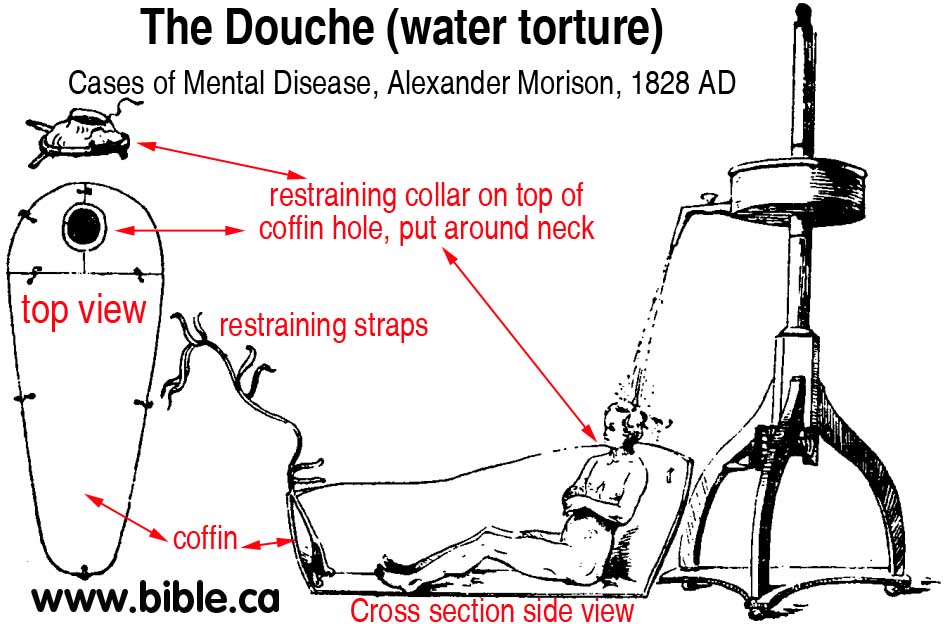
- In 1835 AD, James
Cowles Prichard, Doctor, pioneered , the idea of "moral
insanity" (to the detriment of mankind) so that criminals would
not pay for their crimes. As the term "moral insanity" infers, a
disease of the body causes someone to commit immoral acts (crimes) without
any traces of delusion, paranoia or schizophrenia. "I have described a form of mental derangement, under the
title of moral insanity, consisting in disorder of the moral affections
and propensities, without any symptom of illusion or error impressed on
the understanding". In a page out of modern chemical
psychiatry, Prichard ascribes as many different kinds of moral
insanity as sins listed in the Bible: "the
varieties of moral insanity are perhaps as numerous as the modifications
of feeling or passion in the human mind" So Prichard has moral
insanity varieties like "theft", "murder", "ponzi
stock market scheming" etc. Prichard, like psychiatrists today,
believed that insane people were forced to commit crimes like mal-adjusted
chemical robots: "A propensity to theft is
often a feature of moral insanity, and sometimes it is its leading if not
the sole characteristic . . . There is reason to believe that this species
of insanity has been the real source of moral phenomena of an anomalous
and unusual kind, and of certain perversions of natural inclination which
excite the greatest disgust and abhorrence" Prichard believes
that it is the disease forcing the sinful behaviour upon an otherwise
model citizen: "There are instances of
insanity in which the whole disease, or at least the whole of its
manifestations, has consisted in a liability to violent fits of anger
breaking out without cause" He has his eye on murderers who he
believes are forced by disease to kill: "Various
cases are on record in which homicides and other atrocious acts have been
committed by persons of morose and wayward habits, given up to sullen abstraction,
or otherwise differing in their propensities and dispositions from the
ordinary character of mankind." We do not understand why
psychiatrists are always wanting to excuse sinful behaviour on the basis
of insanity. "In this form of moral derangement
the disordered condition of the mind displays itself in a want of
self-government, in continual excitement, an unusual expression of strong
feelings, in thoughtless and extravagant conduct". Prichard's
primary goal is to promote the insanity plea so that physically sick
people driven to criminal activity, are excused: He describes his desire
for criminals to be excused: "lessening
culpability", "maintain a plea on
the ground of insanity in this country, with a view to the removing
culpability in a criminal accusation" and "abolishing all capital punishments". We see
exactly this today in case after case, like Andrea
Yates who drowned her 5 kids because she was diagnosed with postpartum
depression. Satan is behind this trend of excusing sinners from the
consequences of their sins. (A
Treatise on Insanity and Other Disorders Affecting the Mind, James
Cowles Prichard, 1835 AD)

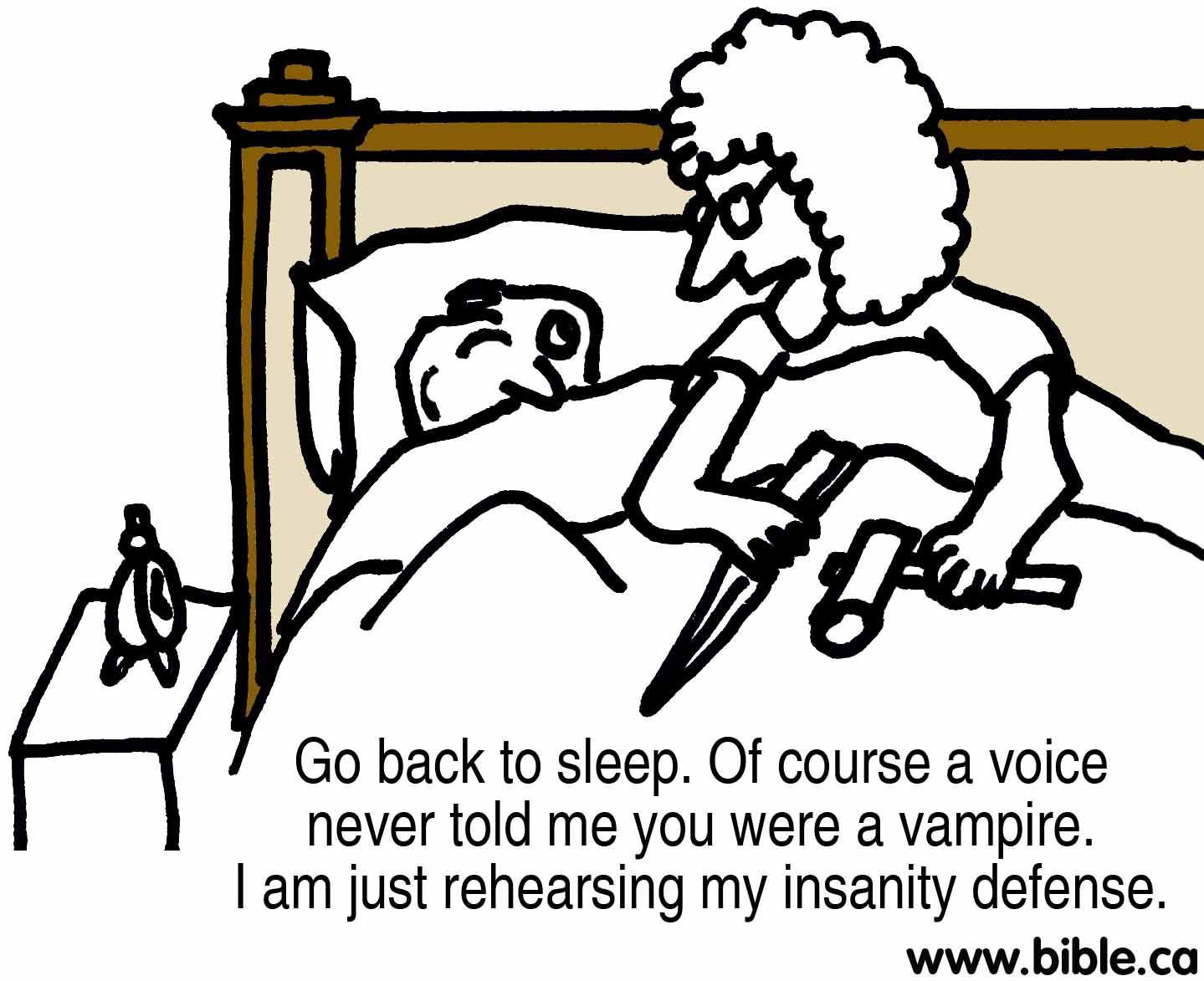
- In 1843 AD, James
Braid, doctor, discovered "hypnotism" and coined the word.
He believed he could cure many diseases including Epilepsy; Rheumatism;
Paralysis and hysteria. His greatest successes were with hysteria: "The most striking cases . . . for illustrating the value
of the hypnotic mode of treatment, are cases of hysteric paralysis . . .
In such cases, by . . . substituting a salutary idea of vigour . . . the
patients are found to have acquired . . . voluntary power over their
hitherto paralysed limbs, as if by a magical spell or witchcraft."
Obviously hysterics are the only one's who the power of the will can
change through hypnotism. Braid was attracted to Franz
Anton Mesmer, with his claims of being able to transmit animal
magnetism to sick people as a cure. Braid was able to prove that Mesmer's
claims at "mesmerizing" people was "a system of collusion or delusion, or of excited imagination,
sympathy, or imitation". He correctly understood that Mesmer
was merely hypnotizing people, "I still
consider the condition of the nervous system induced by both modes to be
at least analogous". A lot of people today think that the
hypnotist possesses the power to control another's actions at will, but in
fact, Braid correctly rejected this claim not only of Mesmer, but of
hypnotism: "not at all on the volition, or
passes of the operator, throwing out a magnetic fluid, or exciting into
activity some mystical universal fluid or medium". In other
words, there is no power being transmitted by the hypnotist to the person
being hypnotized. Instead, Braid understood, we know today, that people
hypnotize themselves. The two key concepts required to hypnotize anyone is
the belief that the hypnotist can hypnotize, and a submissive, suggestive
personality or disposition at the time. Hypnosis is seen to day with
charismatics and pentecostals who are "slain in the spirit"
by the "powerful man of God". They falsely believe he is
transmitting the power of the Holy Spirit and they therefore fall
backwards and "do the dead chicken" on the floor for a couple of
minutes. It is learned behaviour and the "slain" are obeying the
hypnotist's command! Slain in the spirit has occult origin and is seen in
many other non-Christian religions. In the first century the apostles
performed true miracles and imparted genuine power of the Holy Spirit
through the laying on of their hands. (Acts 8:4-21; 19:1-7) Modern
hypnotists know they have not power, but often make the audience believe
otherwise. For example, the fabulous hypnotist Reveen, will picture
himself with a spell-casting hand as though he is zapping the person being
hypnotized with some good old Mesmer magic! (Neurypnology;
the Rationale of Nervous Sleep, Hypnotism, Hypnosis, James Braid, 1843
AD)
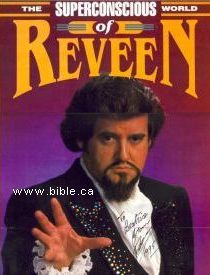
- In 1853 AD, Robert Brudenell Carter, world renounced ophthalmologist, wrote his first book on hysteria and faking insanity. Having concluded much of insanity was pure faking, he lost interest in psychiatry and specialized in eye surgery. It is a truly remarkable, "must read" book. Most important, Carter recognized that the physical symptoms were caused by the power of the mind: "That emotion is a force adequate to the production of very serious disorders in the human frame, acting upon the muscular, vascular, and secreting organs, and causing various derangements both of their structure and function,-the proclivity to its influence being greatly increased by the operation of all debilitating agents, whether local, or general, and by all circumstances tending to make individual parts the subjects of attention." While psychiatrists in the 1940's actively treated hysterics as insane because of physical problems with their bodies, Carter saw the symptoms as having their origin in the freewill of the human spirit: "in some cases, to a short attack of laughter or sobbing; and in others, producing very energetic involuntary movements, maintained during a considerable time, and occasionally terminating in a period of catalepsy or coma". He also mentions: epileptic type fits, vomiting, drooping eyelids, muteness. For this reason, he would oppose the chemical psychiatrists today who always prescribe drugs that never cure: "Against ... hysteria ... I should regard all medicines to be absolutely useless and inert." It is clear that Carter viewed hysteria as a blatant and deliberate deception where a person acts like they are insane or sick in order to gain sympathy, attention or be excused from life's responsibilities and be catered to. In the case of Sarah W. he noted, "the convulsive movements continued for upwards of two hours without the smallest abatement; and then, becoming gradually less violent, were at last succeeded by a state of perfect catalepsy, which lasted nearly an hour, and yielded in its turn to sleep" Carter viewed both men and women as hysterics, but noted: "greater proclivity of the female sex to hysteria, and also for the absolute rarity of its occurrence in man". Although he is wrong about the sex drive being the etiology of hysteria, "Women of strong [sexual] passions ... are especially liable to hysterical attacks." he correctly identified that much of mental illness was like a cunning stage performance for personal gain. "The subjects of tertiary hysteria may be advantageously divided into two classes, which fade imperceptibly into each other, and yet present a sufficiently marked difference in their respective types. The first will comprise women whose sexual propensities have been disappointed, but whose lot in life may be in all other respects desirable; and the second those in whom some form of envy or discontent is the predominant feeling." Carter describes their motives as being driven by "envy", "discontentment" unhappy with their position in life, "desire for sympathy" ... "an union of selfishness and deceptivity, allied in order to indulge that desire for sympathy" Carter lays "down rules for the detection of malingerers" and describes the mentally ill: "ingenuity of the performer" ... "The motives by which hysterical women are actuated, in the performance of their objectless deceptions and self-imposed penances, are remarkable no less for their strength than for their obliquity". Narcissism is always present, since the mentally ill get all kinds of undue sympathy and attention. "It is scarcely to be doubted, that if a girl who has thought herself neglected and uncared for, becomes the subject of a primary paroxysm, her chief feeling on recovering from it will be one of gratification at the fuss that has been made about her, and at the temporary oblivion to which all other things and persons have been consigned in honour of her illness". This is shockingly opposite to what mental health officials do today when they lie to the public that mental illness is just like a heart attack, which demands no personal accountability or fault and heaps of sympathy. But Carter understood 150 years ago, that people deliberately fake a mental illness: "discovered her own power of producing an attack" ... "an extraordinary development of cunning, by means of which hysterical women often carry out most complicated systems of deception, and succeed in baffling". Since hysterics love attention and to be considered special and unique, Carter has this advice: "destroy the impression, that there is anything remarkable, or singular, in the particular case under consideration, which must always be spoken of as most ordinary and common-place". Carter noted that upstanding women in churches were often targets of sympathy: "Small, or very enthusiastic religious communities, are the most usual victims of this kind of imposture, which is constantly practiced upon the benevolent ladies of a village". Unlike many of the mad doctors before him, Carter openly recommended hysterics attend church as a positive cure: "Whenever, therefore, the kind of religious teaching which is likely to be beneficial, can be obtained, it must be used and appreciated as a most important aid". Carter practiced "moral treatment" which avoided the outright torture of the previous century seen in most mad houses, but specifically targeted the hysteric's personal conduct and thoughts in order to bring them into repentance for their sins. Although he noted that torture did work in some cases, he opposed them at ineffective because the hysteric often had the will to endure in order to escape detection as a faker. "Moral treatment has been put in practice against hysteria in a very large number of cases, by the use of various harsh measures ... in isolated cases, been exceedingly successful; thus showing that some right principle was involved in their application"... "these harsh measures failed more frequently than they succeeded". While he accepted the fact that torture indeed "cured" in some cases, he realized that most hysterics were prepared to endure even torture, to gain the desired sympathy, attention and special privileges associated with "being sick". "that a girl who yielded to a few duckings [cold water baths], and a little discomfort, would have to suffer the disgrace and degradation consequent upon detected imposture; while one who passed safely through the ordeal, would be considered by her friends to be really the victim of disease; and the discerning doctor who subjected her to harsh treatment, would be condemned by them as a monster of ignorance and inhumanity ... that a certain amount of perseverance on her part, will exalt her into a martyr in the eyes of her family, and will enable her to bid defiance to professional denunciations". In other words, by enduring the torture, she got way more sympathy and attention than if she had not been tortured. It also made her look morally better than the very doctors who were fully aware of her fraud. "the system which is about to be described, acts by wearing out the moral endurance of the patient, and also by taking from her all motives for deception, or for the voluntary production of convulsive attacks" In the first stage of treatment, Carter recommends deceiving the deceiver! "indulge her in every trifling bad habit (that of breakfasting in bed for instance) ... some pleasantly-flavored medicine ... completely deceive her as to the nature of the treatment which she has to undergo". Then when she has been observed for some time with her guard down confront and rebuke the hysteric and attempt to bring them into repentance: "commence by a positive assertion that she has nothing at all the matter with her, and is, in reality, in perfectly good health ; her ailments being, one and all, fraudulent imitations of real disease. Such a statement will usually be met by an indignant but still half-frightened denial of its truth ... exhibit violent anger ... obstinate taciturnity [silence] and sullenness ... expressions of anger and wonder, mingled with tears and sobs ... a tempest of indignation, violently repudiates the charges brought against her ... jumps up from her chair, overturns it, and exhibits furious passion ... as the storm of her words has abated for lack of breath, she must be told to sit down, and to conduct herself like a lady ... obstinate, irritable, and frivolous. ... the patient is very ingenious, and practises many devices before yielding ... [they] trust in their sullenness as their most effectual shield". In other words, hit dogs howl. Today, this kind of reaction is to be always expected when treating the mentally ill, when you tell them they do not suffer from a chemical imbalance, there is nothing wrong with their body, and their problems are the result of their own personal and moral choices and they are to be held at least partly personally responsible for their problems. Carter suggests blackmailing the hysteric by "exposing the fraud" unless they quit acting insane. It worked! "he will abstain from exposing her, either to the members of her own family or of his, so long as she manifests a sincere desire for amendment" ... "The dread of losing caste [shame] by such a discovery, would be a strong inducement to a girl who was under treatment in her own home, to hold out to the very last, and would keep alive a motive, which it should be the first object of the medical attendant to destroy. Now and then cases will be met with, in which the patient is heartily weary of, and sorry for, the system of deception which she has commenced, and waits only for the smallest help from a wise and friendly hand, to abandon practices which she would have left off before, had she known how to do so without exciting the suspicions of her friends." He even suggests assisting the faker from shame, by inventing cures that are as false as the disease being faked. This was in order to create the false appearance to the hysterics friends and family that they really were suffering from a bodily disease. "she must be well assured herself that these pretended remedies are perfectly inoperative; and she must be encouraged to exertion by the threat of exposure, if she fails to get rid of each symptom within the specified time". He gives a timeline for the patient to obey, in order to make it appear she is being cured slowly over time: "any self-produced ailments besides the hysteric paroxysms, as vomiting, ptosis [drooping eyelids], aphonia [muteness], or the like, she should be told to leave them off within a certain time, as a week or a fortnight." Carter notes that often hysterics chose to display the wrong symptoms of a disease exposing her "forked tongue" of deception, but others are almost perfect chameleons of deception that only a trained medical doctor can discern. "she will almost inevitably either be unfortunate in her original selection, or inconsistent in her collocation of symptoms, and thus betray the cloven foot; but when a cunning woman, in playing her last stake, simulates a disease which she has had ample opportunities of observing ... her medical attendant will have need of all his discrimination". He stresses that the treatment must "conduce to her humiliation and shame, must be brought fully before her" ... "until ... the patient exhibits signs of contrition and regret ...any sign of penitence". ... "She must be told, at first, that the way in which she is treated will depend entirely upon her own behaviour, and that if she manifests causeless sulkiness or rudeness, she will be left to her own companionship, and to her own resources for amusement and occupation, until she has made proper atonement for her error" Carter notes that godless people will fix themselves because of "The fear of shame and exposure, the fear of the world's opinion, the desire to gain credit for resolution, or self denial, or cleverness, will often produce a change of action in persons with whom the fear of God is an empty sound, and to whom the necessity of doing right, might have been ineffectually preached till doomsday." They may have not listen to God in the Bible, but they are still concerned with self preservation. Many cases of mental illness today would be almost instantly cured if mental health officials stopped telling people its not their fault, that they are not responsible for it, that it is the same as any other medical condition and placed the blame for their own condition squarely upon their own heads. He highlights that mental illness patients are fundamentally liars and deceivers who are clever actors in their own play whom he has caught red handed in the act: "I have often been complained to in the morning, about the severe operation of a purgative, which I had placed in the patient's hands overnight, and which had just before been brought back to me, by a servant who had found it concealed in her bedroom." Carter notes a few problem areas like the friends and family of the hysteric who blindly accept the deceptive act of insanity: He places the blame on the parents of hysterics: "who have been treated with excessive and ill-judged indulgence by their parents, who have perhaps been delicate and sickly in early life, and whose moral training has, on this account, been neglected". These parents have as much trouble accepting responsibility for their children's hysteria as the hysteric themselves! Carter note he often hears from parents: ""My daughter, is a religious, moral, and well-conducted young woman, quite incapable of such practices as those which you impute to her; and from our knowledge of her character, we are satisfied that you are mistaken in her case." The parents will never learn that their darling daughter has already admitted she is faking to the doctor. He notes that hysterics will often write letters and make phone calls to rally up support in one last vain attempt to admit the lies and deception: "she will often endeavour to escape from it, by writing letters to her friends, full of the bitterest complaints and the most doleful lamentations". Often families of the insane are more of a problem than the one mentally ill. Carter states that his system has a 100% success rate over many years and hundreds of cases: "The system of treatment which I have thus endeavoured to describe, has been tested for many years, and in a great number of cases, but always with success" ... "The process is always troublesome, and often difficult, but I have yet to hear of the case, in which it would ultimately fail of success". Like many medical students today who consider a career in psychiatry, see it for the deceptive confusion it really is, then chose to specialize in a real medical career, Carter left psychiatry and became a world class eye surgeon. His book on hysterics should have been the writing on the tombstone that exposed insanity for what it really is and psychiatry as quackery and junk pseudo science. But the Devil was raising to power, two of his demon angels: Sigmund Freud and Charles Darwin's Origin of the Species in 1859 AD. The result is the chemical psychiatry we see today. (On the Pathology and Treatment of Hysteria, Robert Brudenell Carter, 1853 AD)
- In 1857 AD, Richard
Robert Madden observed many historic cases of a kind of mass hysteria.
What is interesting about this phenomena, is that it is clearly induced by
freewill choices of the minds of a large number of people at the same
time. This proves that such mass delusions and hallucinations are not
caused by the body, but the mind. Madden understood that if the mind of a
single person could induce insanity, so could it happen on a mass scale:
"It is with individuals as with nations, they
are controlled and restrained by the same influences, or corrupted and
perverted by the same wild impulses of passion . . . Hallucinations of
various kinds ensue; and imagination dominated by disease will eventually
give a being, shape and form, 'a local habitation, and a name', to fixed
ideas and chimeras which are the productions of the brain." (Phantasmata
or Illusions and Fanaticisms, Richard Robert Madden, 1857 AD)
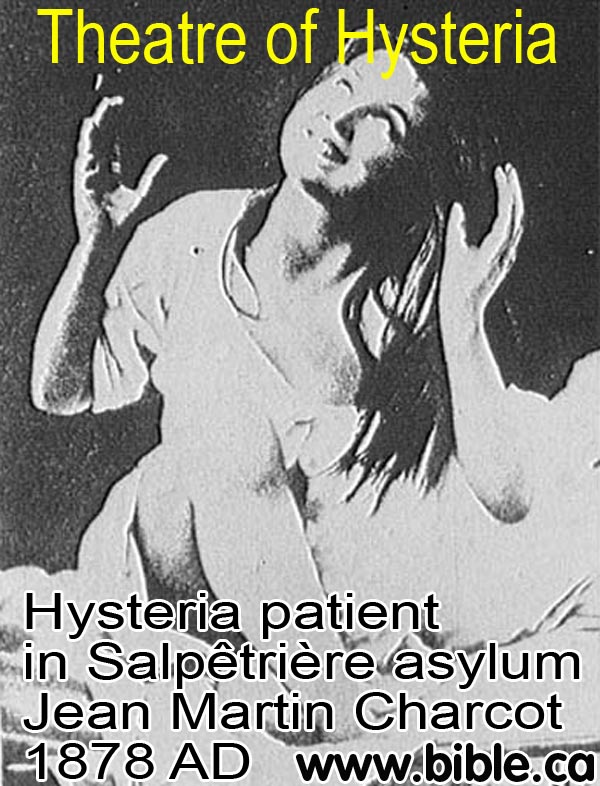
- In 1857 AD, Alexandre
J. F. Brierre De Boismont, doctor, viewed hallucinations as the
product of the human mind and cured by cold baths and cold water torture.
"hallucinations complicated with mental
diseases: Do the hallucinations depend upon the organic changes
super-induced by the mental disease? Are they associated with the
psycho-cerebral excitement which has produced the insanity? In a word, are
they physical or moral? The distinction is often very difficult, yet the
nature of the hallucinations and their immediate connection with the cause
of the insanity, justify us in thinking that they often arise from moral
causes." Suggesting that both insanity and hallucinations are
entirely products of the mind and not the body is a stunning contradiction
to chemical
psychiatry today, but this view was actually the historically majority
view. In regard to large numbers of people experiencing the same
hallucination, Boismont notes that, "in our
opinion, decides the question in favor of moral causes. In fact, epidemic
hallucinations, such as vampirism, ecstasy, and the visions observed in
the different forms of plague, are not susceptible of any other
explanation. In these cases, the hallucinations are transmitted by means
of the ideas which exist in society, or have been inculcated by education
and by the force of example" Boismont had over 305 cases of
hallucinations and concluded that the body was not the cause, but the
mind: "clearly prove the influence of moral
causes in the production of hallucinations. The following details cannot
leave any doubt on this point. Out of 190 cases collected by other
writers, or by ourselves in 115, the circumstances which favored the
production of the hallucinations were meditations carried to the state of
ecstasy, the prevalent notions of the period in regard to religion,
philosophy, politics, superstition, &c., imaginative works, concentrations
of the thoughts, mental struggles, particular passions, a preoccupied
state of mind, troubles, remorse, grief, excessive study, love, hope,
jealousy, and anger." In curing hallucinations he practiced:
"reasoning with the patient, the use of
ridicule or the douche, will succeed in banishing the false sensation"
Practicing at the very end of the Humoral medical era, he wrongly
attributed part of the success to cooling off the "melancholy
blood" of the brain. "The principal
physical agents which are used in the treatment of hallucinations, consist
of general and local blood-letting, of prolonged general baths, either by
themselves or combined with the douche, with the bath of irrigation, or
with purgatives; occasionally emetics, narcotics, and anti-spasmodic; and
lastly, external revulsions, by means of blisters, moxas, and setons."
After almost 150 years of treating the insane with "the fall of
water", he was just another witness to how the "douche"
cured the mentally ill. "We have substituted
for the douche, continued irrigation. The water is allowed to fall, for
hours together, in a thin stream, or in a number of streams like those
from a watering-pot, on the head of the patient while seated in the bath. The effect produced by this continued sprinkling has, first,
the advantage of keeping up a constant cooling effect on the organ which
is congested, without causing those injurious results which have been laid
to the charge of ice. In the second place, it harasses the patient, so that he will often ask for pardon. What others have
stated, as regards the instantaneous action of the douche, we have also
observed from the use of continued irrigation. After this treatment has
been persevered in for some hours, the patients have begged of us to
remove them from the bath, admitting they were previously deranged, that
what they had said was nonsense, but that now they were completely
cured". Although Boismont's etiology of "melancholy
blood" was junk Hippocratic science, he clearly understood that
people could be tortured into sanity. In fact, Boismont's methods would
clearly "cure" a sizeable number of those currently under
psychiatric care. This should not surprise us, since insanity is not a
bodily disease, but a conscious choice made by those who are either
wanting to escape life responsibility or situation, or gain some material
or emotional benefit. His overall assessment of water torture was this:
"We have, however, found such beneficial
results from the use of irrigation, that we constantly employ it; and the
cures we have affected by combining it with baths of considerable
duration, have been so numerous and rapid, that we consider we have
rendered an important service to the therapeutics of mental diseases in
pointing out the circumstances under which this treatment should be
pursued. The facts which we have just
related can scarcely leave a doubt as to the efficacy of physical agents".
He gives an example of a man suffering from hallucinations who just
happened to also refused to work. This man was restored to perfect health
and his job through water torture. Obviously the man was lazy and simply
used the hallucinations as an excuse to receive Obama-welfare and get the
handicap parking permits for the Wal-Mart mall. He was water boarded 6
times and started working again! It is important to note that one of the
key problems with most mental patients is that they are often very lazy.
Amazingly, Datura stramonium, which is a poison that acts as a
hallucination, was also claimed to cure insanity when given over days or
weeks in increasing doses. "Seven were cured,
and three experienced only a temporary amendment. The cures were
accomplished in from four to seven days to a month, by means of graduated
doses of the sweetened extract of stramonium". The multitude of cures of this poisonous
drug, can be none other than the placebo effect in the mind of the insane.
This underscores that insanity is not a bodily illness but actions in the
control of the mentally ill. Boismont was way ahead of his time because he
understood this: "Drugs may sometimes cure
hallucinations; not by means of their therapeutic action, but by breaking
the chain of ideas which possess the mind of the patient." The
drugs
prescribed in chemical
psychiatry today likewise do not cure insanity. (On
hallucinations: a History and Explanation, Alexandre J. F. Brierre De
Boismont, 1859 AD)
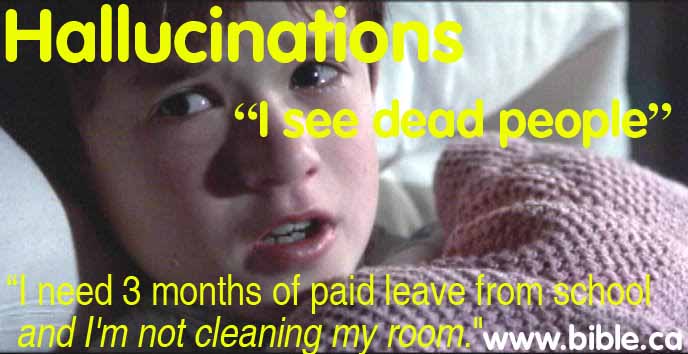
- In 1890 AD, Charles
Arthur Mercier, psychiatrist, insisted that the insane, who are not a
physical danger to others, should be kept locked up against their will on the
basis of social and behaviour control. "the
seclusion of the insane in asylums is necessary and right." This view continues today. However Mercier
stated in blunt terms what every psychiatrist knows today, but would never
be honest enough to publicly admit. He wants the insane to be locked up in
order to protect the public from conduct that is "revolting, shameful, indecent, obscene, disgraceful and
filthy". Of course, this is not insane behaviour, it is sinful
conduct that the insane have chosen to engage in. He states that the
behaviour of the majority of the insane is "more
shameless and filthy in their conduct than so many monkeys".
Mercier argues that the insane must be protected against themselves:
"in order to prevent him from squandering his
means and ruining himself and his family". He cleverly argues
that the insane will actually thank those who locked him up when he gets
out, by preventing him from shaming and humiliating himself in public.
"restraining him from performing acts which
are not dangerous, but which are disgraceful, and which he himself would,
on his recovery, be loudest in blaming his friends for not preventing".
But the 300 year history of psychiatry as a parallel penal/legal system
and method of behaviour control is clear! "It
is not merely that the public must be protected from such conduct as this.
They have a right, also, to be prevented from witnessing it, to be
protected from the danger of witnessing it; and it is for this reason,
more than for any other, that the seclusion of the insane in asylums is
necessary and right." (Sanity and
Insanity, Charles Arthur Mercier, 1890 AD)
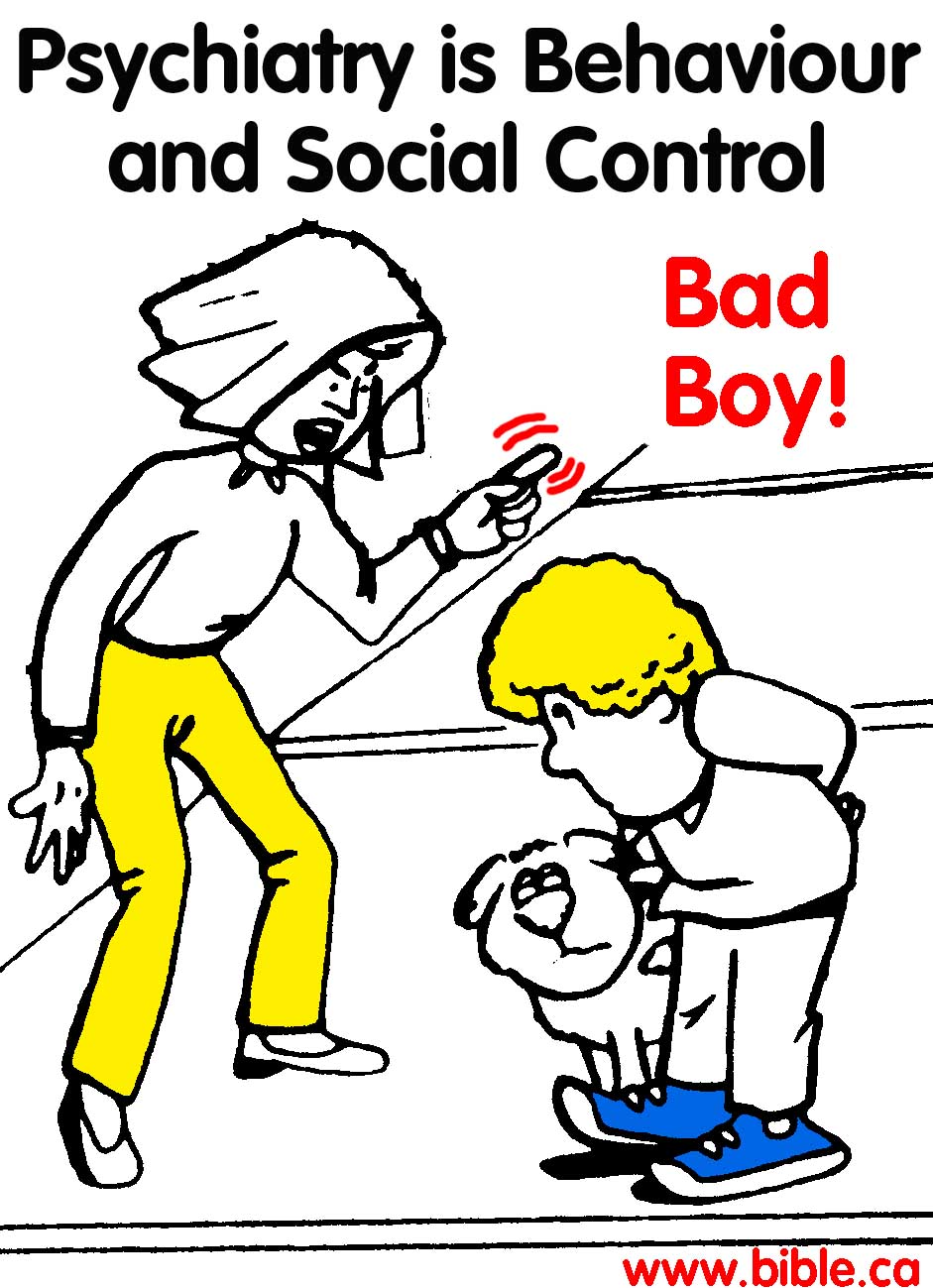
- In 1890 AD, William Booth, church minister and founder of the Salvation Army, was influenced by Heinroth's 1818 AD book and adopted the view that men who chose to sin can slide down a slippery slope into involuntary insanity. "some men of science [Heinroth] hold that persistence in habits tends to convert a man from a being with freedom of action and will into a mere automaton". Both Booth and Heinroth believed that insanity was a robotic state that was entered by freewill choices to engage in sin and that they should be committed to asylums against their will and taken care of at tax payer expense. Although the salvation Army is a church that actually refuses to baptize or partake of the Lord's Supper, they are really not viewed as a religion by the general public, but a type of public charity helping human suffering. It may come as a surprise to many that Booth's view was to "only help them who help themselves" and throw into an asylum, "those who refuse to help themselves": "when all has been done and every chance has been offered, when you have forgiven your brother not only seven times but seventy times seven, when you have fished him up from the mire and put him on firm ground only to see him relapse and again relapse until you have no strength left to pull him out once more, there will still remain a residuum of men and women who have, whether from heredity or custom, or hopeless demoralisation, become reprobates." Booth viewed the insane as a "lost soul on this side of the grave". He understood that laziness was a huge common factor with the insane and recommends involuntary committal to an asylum anyone who refused to work or care for themselves: "There are men so incorrigibly lazy that no inducement that you can offer will tempt them to work; so eaten up by vice that virtue is abhorrent to them, and so inveterately dishonest that theft is to them a master passion. When a human being has reached that stage, there is only one course that can be rationally pursued. Sorrowfully, but remorselessly, it must be recognised that he has become lunatic, morally demented, incapable of self-government, and that upon him, therefore, must be passed the sentence of permanent seclusion from a world in which he is not fit to be at large." He viewed the insane as, "carrying with them the contagion of moral leprosy, and multiplying a progeny doomed before its birth to inherit the vices and diseased cravings of their unhappy parents." It was on this basis that his charitable efforts must cease: "But when they have reached a certain point [of sinfulness] access to their fellow men should be forbidden." ... "after an [insane] individual had suffered a certain number of convictions for crime, drunkenness, or vagrancy, he should forfeit his freedom to roam abroad and curse his fellows. ... I include vagrancy in this list" Booth viewed the insane as condemned sinners engaging in sinful behaviours that the general public should be protected from coming in contact with. (In Darkest England and the Way Out, William Booth 1890 AD)
- In 1899 AD, Sigmund Freud popularized psychoanalysis with
his book "Interpretation of Dreams". Freud used talk, electric
shocks and hypnotism as therapy. His etiology for insanity was similar to
Christians in that life events and personal choices rather than biological
causes, induced madness. Science fiction writer L. Ron Hubbard, founder of
Scientology, created a new non-Christian religion,
by inventing fictional histories (space traveler Xenu gets stuck in a
volcano 50 million years ago and your mission is to release him) and a dictionary of scientific
sounding words (like "clearing" or "Aberrated
Wog", Hubbard's term for the unenlightened commoners derangement or
insanity. The Scientology cult dictionary, Star Wars lingo, Lord of the
Rings lingo, the Manual of Star trek science terms are directly parallel
to the scientific sounding mythical words and concepts invented by Sigmund
Freud. Freud invented an entire ecosystem of mythical concepts like his
confusing "Id, Ego, and Super-Ego". To Freud, early sexual
trauma's we experienced while in diapers and in the hands of our mothers,
were repressed, but then surfaced later in the form of insanity. Freud contributed little or nothing to the correct
understanding of insanity and is today generally irrelevant.
"Anyone reading Sigmund Freud's original works might well be seduced
by the beauty of his prose, the elegance of his arguments and the acuity
of his intuition. But those with a grounding in science will also be
shocked by the abandon with which he elaborated his theories on the basis
of essentially no empirical evidence. This is one of the main reasons why Freudian-style psychoanalysis has long since fallen out
of fashion: its huge expense - treatment can stretch over years -
is not balanced by evidence of efficacy." (Editorial, Nature 461,
847, 15 October 2009) The idea of a "Freudian Slip", is a rather
commonly understood concept among teenage boys when they "slip"
what is really on their mind when talking to a pretty girl, without every
studying Fraud. The concept of "repressed
memory syndrome" is pure junk pop psychology that has its origin
in Freud and has wrongly convicted and harmed thousands of innocent
people. The truth is, if you can't remember it, it either never happened
or it is not bothering you. Also the myth that we only use 5% of our brain
power and capacity is pure Freud, and derives from his science fiction
terms: Id, Ego, and Super-Ego. The important thing to note, is that Freud,
although an atheist, rejected biological causes of insanity and focused on
talking cures like church ministers have been doing for 2000 years. But
his impersonal approach, with the couch and the chair arranged so neither
could see each other, is exactly opposite to true talking cures that
Christians do face to face for each other over a cup of coffee. Freud
would have made a more concrete contribution to society had he gone into
construction work. Today his ideas are almost universally rejected a wrong
except for a few remaining rabid cult followers who view him as their Charles
Darwin of psychology. For that matter both Freud and Darwin should have
started a construction company together! Psychoanalysis is the price
non-Christians pay for not reading their Bible. Freud suffered from oral
cancer from smoking and committed suicide through doctor assisted morphine
injections.
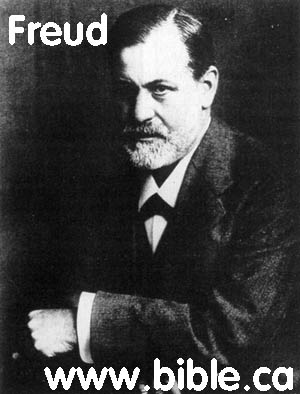
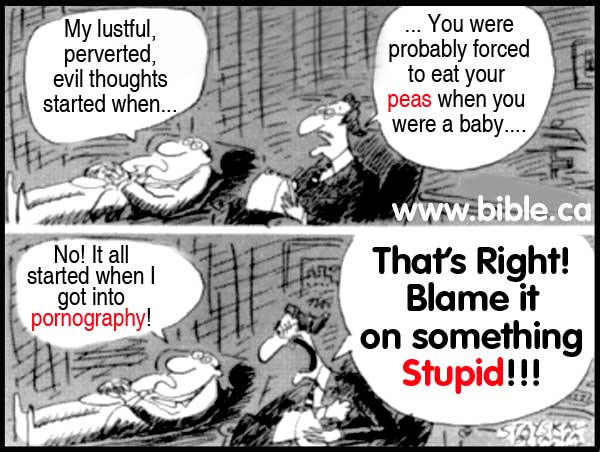
- In 1901 AD, Richard
Maurice Bucke, psychiatrist, published "Cosmic
Consciousness" a year before he died and revealed in great detail his
etiology of insanity as purely evolutionary biology and viewed the insane
and "mentally ill" as incurable evolutionary misfits, failures
in "natural selection" with weak, deformed minds operating at
mere animal level: "We know that in some men
the intellectual functions are so unstable that as soon as they are
established they crumble down—crushed (as it were) by their own weight -
like a badly built house ... cases of so-called developmental insanity ...
in which the mind falls into ruins as soon as it comes into existence or
even before it is fully formed ... running down at once back into chaos.
The hopelessness of this class of cases (as regards recovery) is well
understood by all alienists [psychiatrists], and it is not difficult to
see why such insanities should and must be practically incurable, since
their very existence denotes the absence of the elements necessary to form
and maintain a normal human mind in the subjects in question....
inevitable that we should meet with constant lapses, omissions, defects,
breakdowns. Clinical observation teaches day by day that the above
reasoning is solidly grounded." Being deceived by Charles
Darwin, he was also deceived by the Haeckel
fraud of embryonic recapitulation, practiced eugenics by sterilizing
over 109 women Canadian in his last ten years in order to prevent further
pollution of the human race with their obviously defective genes. Of
course he justified his dark inward "survival of the fittest"
motives of cutting out female ovaries with the recently discovered
endocrine treatments for hypothyroidism and the current view that insanity
was caused by secretions of the sex organs and masturbation. He justified
his practice of putting a wire cage over the penis or sewing a suture
(stitch) directly onto the prepuce, to prevent further insanity caused by
masturbation, but it was more likely that it was a method of birth control
within the London Asylum. Like Haeckel, Bucke falsified his "clinical
trials" as proof he had discovered the best treatment for insanity.
He was a racist who believed African Negroes and Australian Aboriginals
operated on the animal level of mere "simple consciousness"
which accounted for their much lower rate of insanity that Aryan nations
who had developed the higher levels of "Self and Cosmic
Consciousness". "members of low races,
such as the Bushmen of South Africa and native Australians, who never
attain to this faculty [of self-consciousness]... It seems impossible to
believe that as a race these creatures are self conscious."
White people had evolved their "higher executive faculties" at a
fast rate and this made them more susceptible to insanity. Bucke felt that
Negros and Aboriginals couldn't go insane, because insanity involved the
loss of higher thinking which they did not possess. For Bucke there were
three stages of intellectual evolution within humans on earth: 1. low: animal
men with mere "simple consciousness". 2. average men with
"self-consciousness". 3. the 14 god's with "Cosmic
Consciousness" which represented what all men would "evolve
into", in the "utopian socialist future". "This new race is in fact of being born from us, and in
the near future it will occupy and possess the earth". His
book, Cosmic Consciousness was his personal inventory his 14 guru's who
represented this future race: Buddha, Jesus, Paul, Plotinus, Mohammed,
Dante, Casas, Yepes, Bacon, Behmen, Blake, Balzac, Walt Whitman,
Carpenter. (He obviously viewed himself as the 15th) When his idol, mentor
and fellow humanist, Walt Whitman died, he proclaimed, "The Christ is dead!" and dedicated his book
to Whitman as possessing "The Most Exalted Moral Nature". He was
also communist who looked forward to the classic Marxist
"utopia" where religion would vanish when in the future every
man will be his own god: "all religions known
and named today will be melted down ... Each soul will feel and know
itself to be immortal". Although the son of a church minister,
he had very confused religious views that were a mix of atheism, humanism,
Bahai, Buddhism, John Lennon, Shirley Maclaine while firmly parroting (but
disbelieving) the Christian doctrine of conscious life after death.
Speaking to his deceased son in 1899, he echoes what his father taught
him: "Only a little while now and we shall be
again together and with us those other noble and well-beloved souls gone
before. I am sure I shall meet you and them". The material
part of his dichotomous
view of man, was that the intellect was physically located in
cerebral-spinal nervous system and that the moral nature and emotions are
physically located in the sympathetic nervous system. He was the first
chief psychiatrist at the Hamilton Asylum for the Insane (later the Hamilton
Psychiatric Hospital [HPH] and today St Joseph's Healthcare Hamilton, West
5th Campus) in Ontario Canada for a year, then moved and spent the last 25
years of his life as head of the "London Asylum" in Ontario. He
was co-founder of the University of Western Ontario's medical school.
Being widely respected and very influential, he is responsible for setting
the type of care all Canadians have experienced including insulin shock
injections up to 1960 and ECT to the present. In Canada, chemical
psychiatry has been the dominant view ever since. Bucke lobbied 350
doctors in Ontario for support of his sterilization treatment for
insanity. For the amount of actual influence he had, there wasn't much
science he had right, being trained as a humoral
doctor and adopting the view of William
Battie (1758 AD) and Nicholas
Robinson (1729 AD) that insanity was caused by defective nerves and
body secretions. His evolutionary view and biologic etiology of the human
mind led him to view most cases of insanity as incurable. Just as Darwin
conceived his theory of biologic evolution on an incorrect understanding
of the geology he observed at Tierra del Fuego, so too Bucke conceived his
theory evolution of the mind upon Darwin. As a philosopher, Bucke's views
are widely accepted among today's chemical
psychiatrists, who are restrained from harming people like Bucke did,
only by law. His hostile views against Christianity endure to this very
day in the Canadian Mental health industry. Clarence B. Farrar, the first
head of the Toronto Psychiatric Hospital (TPH) when it opened in 1925 AD,
was a strong advocate of sterilizing the insane and a member of Eugenics
Society of Canada (ESC)." (Cosmic
Consciousness, Richard Maurice Bucke, 1901 AD)

- In 1902 AD, S.
Weir Mitchell, doctor, popularized rest therapy where a hysteric is forced
to lay in bed for up to three months at a time. A few years earlier, in
his 1894
AD address to the American Medico-Psychological Association, Mitchell
decried the deplorable conditions of the asylums as being nothing better
than jails. He quotes a woman who visited an asylum for the first time:
"Oh, I should go mad here if I were not so
when I came. Why can't some one move the furniture about and make it look
less sepulchral." In this address he notes that the general
public were suspicious and critical of asylums and psychiatry in general:
"Of the feeling of distrust concerning the
therapeutics of asylums now fast gaining ground in the mind of the general
public I have said nothing. This lack of medical confidence is of recent
growth. Once we spoke of asylums with respect; it is not so now."
Having said this, Mitchell understood that most of the female hysterics
were manufacturing symptoms as a way to escape an unhappy home life, daily
work and responsibility. He takes a similar view of insanity faking to Robert
Brudenell Carter. He identified them as being selfish and lazy, "having a taste for invalidism", "mimic fatigue". He has many such women in
his practice: "Nothing is more common in
practice than to see a young woman who ... is tired all the time, by and
by has a tender spine, and soon or late enacts the whole varied drama of
hysteria. As one or other set of symptoms is prominent she gets the appropriate label, and sometimes she continues to exhibit only the single
phase of nervous exhaustion or of spinal
irritation. Far more often she runs the
gauntlet of nerve-doctors, gynecologists, plaster jackets, braces, water-
treatment, and all the fantastic variety of other cures." ...
Curiously, having a sore back is a common faked complaint: "They acquire tender
spines, and furnish the most lamentable
examples of all the strange phenomena of hysteria." Mitchell
sees these fakers as causing others much harm and trouble: "There is one fatal addition to the weight which
tends to destroy women who suffer in the way I have described. It is the self-sacrificing
love and over-careful sympathy of a mother, a sister, or some other
devoted relative. Nothing is more curious, nothing more sad and pitiful,
than these partnerships between the sick
and selfish and the sound and over-loving. ... The patient has pain, —a tender spine, for example ; she
is urged to give it rest. She cannot read; the self-constituted nurse
reads to her. At last light hurts her eyes; the mother or sister remains
shut up with her all day in a darkened room. A draught of air is supposed
to do harm, and the doors and windows are closed, and the ingenuity of
kindness is taxed to imagine new sources of like trouble, until at last,
as I have seen more than once, the window-cracks are stuffed with cotton,
the chimney is stopped, and even the keyhole guarded. It is easy to see
where this all leads to: the nurse falls ill, and a new victim is found. I
have seen an hysterical, anemic girl kill in this way three generations of
nurses." Typical of the insane, they are insulted when you
openly accuse them of being selfish to the needs of others: "If you tell the patient she is basely selfish, she
is probably amazed, and wonders at your cruelty. To cure such a case you
must morally alter as well as physically amend, and nothing less will
answer." Mitchell's solution is to replace the sympathetic
relative who is deceived into a slavery of needless service of a faker,
with order, discipline and obedience: "The
first step needful is to break up the companionship, and to substitute the
firm kindness of a well-trained hired nurse." He warns to keep
a look out for the faker hysteric who is "always
able to do what it pleases her to do, and who is tired by what does not
please her". Mitchell's sleep therapy, therefore was a way to
turn the tables of control enjoyed by the hysteric. He basically bores
them back to activity. It is all about a battle of wills and control: He
first describes the kind of life the hysteric enjoyed before they met
Mitchell: "To lie abed half the day, and sew
a little and read a little, and be interesting as invalids and excite
sympathy, is all very well" The he describes his approach in
contrast: "but when they are bidden to stay
in bed a month, and neither to read, write, nor sew, [or to use the hands
in any active way except to clean the teeth] and to have one nurse, who is
not a [sympathetic and deceived] relative, then repose becomes for some
women a rather bitter medicine, and they are glad
enough to accept the order to rise and
go about when the doctor issues a mandate which has become pleasantly
welcome and eagerly looked for. ... the man
who resolves to send any nervous woman to bed must be quite sure that she will obey him when the time comes for her to get up. What is amazing about all
this, is that Mitchell understood that laying in bed for 3 months harmed
the body. NASA understands weightlessness without exercise is a huge
problem. "When we put patients in bed and
forbid them to rise or to make use of their muscles, we at once lessen
appetite, weaken digestion in many cases, constipate the bowels, and
enfeeble circulation. When we put the
muscles at absolute rest we create certain difficulties". This
proves that sleep therapy had little to do with actual "recharging
the body", and everything to do with boring the hysteric back to her
home duties and responsibilities. It is a case of reverse psychology: She
can either do a few hours of work each day at home and then be free to do
what she wants, or she can be sent back to the asylum where she is
grounded to her bed for 3 months doing nothing that she wants. (Fat
And Blood, treatment of Neurasthenia And Hysteria, S. Weir Mitchell,
1902 AD)
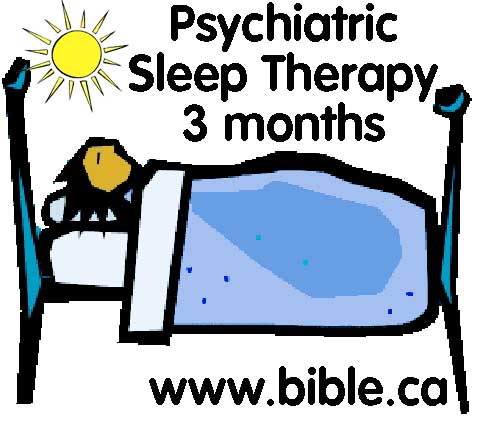
- In 1920 AD, Carl Gastav Jung, Swiss psychiatrist, (1875-1961 AD) had crystallized his "analytical psychology" (or "Jungian psychology") which rejected the biopsychiatric model of the etiology of insanity. At age 12, Jung fell and struck his head and "At the moment I felt the blow the thought flashed through my mind: "Now you won't have to go to school any more." ... "From then on I began to have fainting spells whenever I had to return to school, and whenever my parents set me to doing my homework. For more than six months I stayed away from school, and for me that was a picnic. I was free, could dream for hours, be anywhere I liked, in the woods or by the water, or draw." He had actually developed the habit of faking fainting spells so that when the time came that he wanted to go back to school that the fainting spells continued, but gradually diminished. We know from neurological studies of the brain, that this is essentially what happens in Tourette's or OCD. The brain actually rewires the voluntary behaviour into a semi-involuntary behaviour. However, Jung set his mind to stop fainting and he over came it entirely by willpower. He commented: "That was when I learned what a neurosis is." He clearly place too much weight on the interpretation of dreams. Like embryonic recapitulation, Jung believed that "archetypal" experiences of evolutionary ancestors was embedded in the unconscious that affected how one behaved and thought in the present. These vestigial archetypal remnants of the past evolutionary forms was to Jung, the cause of insanity and neurosis but was in fact as bizarre as Freud's view that insanity was caused by childhood sexual trauma while breastfeeding. Apart from the anomalies of dream interpretation and ancestral archetypes, Jung's approach to "treating" the insane was to look for a rational cause for behaviours. Jung clearly rejected the idea that insanity was a physical disease. "As a neurosis starts from a fragmentary state of human consciousness, it can only be cured by an approximative totality of the human being. ... Such a cure cannot be effected by pills and injections." Jung also understood that people must be free to chose to commit suicide if that is their choice: "When somebody says, `I am going to commit suicide if' ... I say, 'If that is your intention, I have no objection.'" Jung understood insanity as simple human behaviour that others find different from cultural norms: "To be 'crazy' is a social concept; we use social relationships and definitions in order to distinguish mental disturbances. You can say that a man is peculiar, that he behaves in an unexpected way and has funny ideas, and if he happens to live in a little town in France or Switzerland you would say, 'He is an original fellow, one of the most original inhabitants of that little place'; but if you bring that man into the midst of Harley Street, well, he is plumb crazy." (Memories Dreams Reflections, Carl Gastav Jung, 1961 AD)
- In 1927 AD, Manfred J. Sakel, Insulin-induced coma and
convulsions, to treat schizophrenia. Insulin had been discovered a few
years earlier in 1921 AD, by two Canadians: Charles Best and Frederick
Banting. The idea of injecting insulin into the blood stream to bring the
sugar level down to almost zero is pure quackery. But this didn't stop
psychiatrists from using it on thousands of patients resulting in a 70%
improvement in their schizophrenic symptoms. A few controlled studies put
insulin shock therapy on the shelf beside bloodletting... which seems to
be the place all psychiatric treatments eventually end up.

- In 1935 AD, the lobotomy
(leucotomy or psychosurgery) was invented by Egas Moniz. The procedure was
crude, destructive and caused direct brain damage. It jammed a butter
knife into the eye socket until it hit the orbital bone. Then it was hit
with a hammer to punch through the bone into the brain. Then the knife was
used to cut brain tissues connecting the left and right frontal lobes. In
1941, James W. Watts, and Walter Freeman performed a lobotomy on Rosemary
Kennedy (John F Kennedy's sister) when was 23. Rosemary was asked to sing
while the knife cut brain tissue. She continued to sing, so he cut more
until suddenly, she stopped singing and never sang again. Rosemary
suffered permanent brain damage and was left in a vegetative state until
she died natural causes at the age of 86 in 2005. Only chemical
psychiatrists would imagine such a treatment would cure insanity because
they believe in evolution and reject the Christian doctrine that man has
both spirit and body. This forced them to always look to the brain for the
cause of mood and behaviour disorders. Like modern neuroleptic drugs, a
lobotomy simply disables or damages the brain and changes normal function.
It is outlawed in many countries of the world however Japan, Australia,
Sweden and India still perform lobotomys as a social control for violent
and out of control people. While effective in "dumbing down"
these violent people, it might be more humane just to shoot them. Lobotomy
is one of the most obvious examples of chemical psychiatry. However, in
hindsight, it was one of the more honest and up front treatments for insanity.
It was clear to every one of the 100,000 lobotomy patients and their
families, that this was a treatment that caused direct brain damage.
Modern treatments with drugs and electric shocks are not so easily
recognized for what they really are. More
detail on Lobotomy.
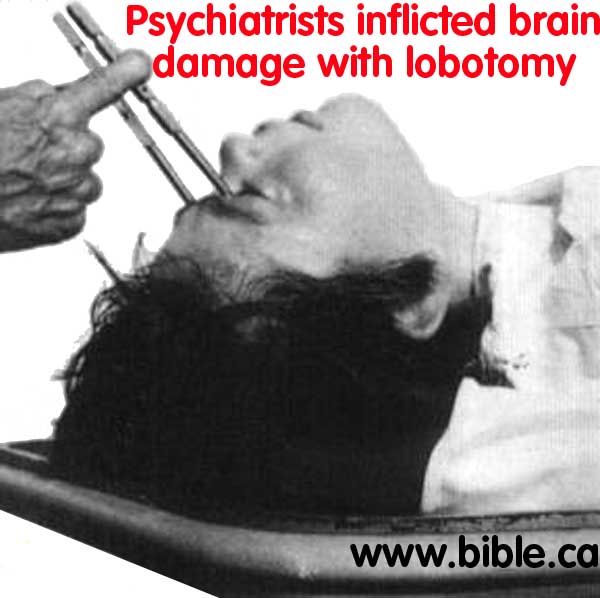
- In 1938 AD, Ugo Cerletti conceived Electroconvulsive
Therapy, (ECT), while he observed how pigs at a slaughter house were
shocked into unconsciousness, then killed by slitting the throat. He noted
that it was not the shock did not actually killed the pigs. Being a
specialist in epilepsy, this is where Cerletti first got the idea of
shocking the human brain to cure schizophrenia and the invention of ECT.
Using electricity to cure insanity has a long history dating back to Charles
Wesley, the founder of Methodism in 1747 AD. With ECT people undergo 5
- 20 shocks over several weeks. The shock is enormous and uses 450 volts
DC in pulsed square waves at a current of .9 Amps for 6 seconds. ECT is a
form of electric lobotomy. A single ECT treatment passes enough
electricity through your brain to light an 84 watt light bulb for 6
seconds or a 500 watt halogen light for 1 second. ECT has been documented
to cause death, strokes and tissue damage. "PA-PSRS has received five reports of patients experiencing skin burns or injuries from a fire during
electroconvulsive therapy (ECT) treatments. ... in the report of a fire, a
bright flash and flames were noted on the right
side of the patient's head at the instant that the ECT shock was given.
Though the flames were quickly extinguished, the patient experienced first and second-degree burns on one ear and
first-degree burns on the forehead above one eye." (Skin Burns and
Fires during Electroconvulsive Therapy Treatments, PA-PSRS Pennsylvania
Patient Safety Advisory, Vol. 4, No. 1, March 2007)
The original theories for ECT treatment were founded on the invalid idea
that epileptics were never schizophrenic and that the two conditions were
mutually exclusive and could not co-exist. Therefore it was originally
thought that inducing epileptic convulsions would cure schizophrenic.
Although we know today that this is just another example of psychiatric
quackery theory, ECT effectively disables brain function by wiping out
memories that make us sad and cause depression. Entire university
educations were erased from people's minds. "Memory
Loss: ECT is a common cause of severe retrograde amnesia, i.e..
destruction of memories of events prior to an injury. The potency of ECT
as an amnestic exceeds that of severe closed head injury with coma. It is
surpassed only by prolonged deficiency of thiamine pyrophosphate.
bilateral temporal lobectomy, and the accelerated dementias, such as
Alzheimer's. After ECT it takes 5 to 10 minutes just to remember who you
are. where you are. and what day it is." (Shock Treatment,
Brain Damage, and Memory Loss: A Neurological Perspective, John M.
Friedberg, Neurosurgeon, American Journal of Psychiatry 134:9, September
1977. p 1010-1013) ECT has been outlawed in many countries and will likely
experience a global ban by 2015 AD. New quackery treatments that shock the
brain, include Deep
brain stimulation, which surgically embeds an two "meat
thermometer looking" electrodes 6 inches in the middle of your brain
to apply shocks. Vagus
Nerve Stimulation wraps an electrode around the vagus nerve in your
neck and applies shocks through a surgically embedded "pacemaker of
the nerve". Passive brain shocking systems include Repetitive
Transcranial Magnetic Stimulation, which uses magnetic induction to
shock the brain in an area the size of a quarter, about 2 inches below the
skull. Shocking the brain with electricity interferes with the normal
electric function of the brain, which normally runs on a voltage of 1/10th
of a single volt. ECT applies up to 450 volts, which is about 4500 times
higher voltage than what the brain uses. ECT to the brain, is like hooking
your 120 volt big screen TV up to 540,000 volts and expecting an improved
picture! For more details, read our other book called, "Everything I
ever needed to know about how ECT causes brain and tissue damage, I
learned in my grade 9 introductory electricity shop class." (Electroconvulsive
Therapy, ECT)


- In 1960 AD, Thomas Szasz rocked the established world of chemical
psychiatry with the publishing his book, "The myth of mental
illness". Szasz is a psychiatrist and former professor of psychiatry
at State University of New York Health Science Center.
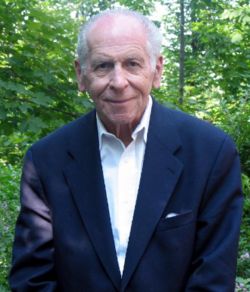
The life work of Thomas Szasz rests upon a foundation of three things: First, the fact that science cannot furnish any medical diagnostic tests for depression, anxiety, delusion, schizophrenia or insanity, therefore "mental illness" is not a biological disorder but is a metaphoric myth like "spring fever". Szasz takes the view that schizophrenia (i.e. delusion, paranoia) has no biological etiology but are mere behaviours that have their origin in the consequences of freewill choices and life circumstances. He rejects the theory that insanity is caused by chemical imbalances in brain chemistry or hereditarily through DNA and considers these beliefs to be quackery and a violation of valid, testable science. Second, individuals labeled "insane and schizophrenic" always retain their free will, act how they chose and therefore should always be held responsible for all their conduct. Szasz is opposed to the insanity plea for any reason, under any circumstance as a violation of justice. Third, all non-consensual psychiatric treatment or committal to an asylum is a violation of civil rights in the same way performing needed heart by-pass surgery without consent is illegal. While Szasz is unconvinced that psychiatric drugs provide cures for insanity any more than they could cure chronic lying, he is not opposed to people taking these drugs voluntary, if that is what they choose. Szasz is a champion of personal freedom, who believes a person should be free to even hurt, harm or kill themselves, if that is their personal choice. Consequently he is opposed to anyone being treated or committed to an asylum against their will for any reason, including attempting suicide. Szasz objects to being misrepresented with the label of being part of the "anti-psychiatry" movement, which, although shares some of his views, continues to practice psychiatric coercion. Further, he maintains an active practice in psychiatry helping people recognize their contribution to their own personal problems. "[Question to Szasz:] What do clients find most difficult about the therapeutic process? [Answer:] Assuming responsibility for their contribution to the problem they seek to resolve. ... Liberation from painful, constricting relationships or situations can be achieved only by assuming responsibility for one's own contributions to them and by extricating oneself from them. The only person who can change a person is that person himself. ...being able to help a client set himself free by assuming more, not less, responsibility for his behavior and feelings." (Seven Questions for Thomas Szasz, Psychology Today, 28 Jan 2009) Szasz believes a person should be free to act in any way (dress up like big bird) or believe anything they want (pink elephants talk to them), without interference or labeling or being forced into treatment against their will. However, if a person breaks the law, like habitually disturbing the peace, Szasz believes they should be charged in criminal/civil courts and stand trial before a judge and cast in jail. Szasz has written countless excellent books, but we have selected his testimony in the trial of Darlin Cromer as the best way to hear Szasz views in action in his own words. On February 5, 1980, a white supremacist named Darlin Cromer murdered a 5 year old Negro boy, then boasted about it to police deputy Dorothy Soto, shortly after her arrest, "It is the duty of every white woman to kill a nigger child, "I've already killed mine." Cromer had a 20 year diagnosis as a schizophrenic. At the trial four psychiatric experts testified that she was insane and should be found not guilty for reason of insanity and belonged in a hospital, not a prison. When the prosecution called Szasz to offer his opinion whether Cromer suffered from anything, he answered: "[My] opinion is that she was suffering from the consequences of having lived a life very badly, very stupidly. Very evilly; that from the time of her teens, for reasons which I don't know, she had, whatever she had done, she has done very badly. She was a bad student. There is no evidence that she was a particularly good daughter, sister. She was a bad wife. She was a bad mother. She was a bad employee insofar as she was employable. Then she started to engage [in taking] illegal drugs, then she escalated to illegal assault, and finally she committed this murder. ... Life is a task. You either cope with it or it gets you ... If you do not know how to build, you can always destroy. These are the people that destroy us in society, our society, and other people." (Trial testimony of Thomas Szasz, Darlin June Cromer, November 1980) At this trial, four psychiatrists testified that Cromer was a certified lunatic who should not be punished for her crimes. One of them was Donald Lunde, among the most highly respected forensic psychiatrists in the USA. It was an epic David vs. Goliath battle of four against Szasz in court. On 17 January 1981, Cromer was convicted of first degree murder which started the chemical psychiatry establishment squealing in unison like stuck pigs, demanding a retrial and launching personal attacks on Szasz. They got their wish, but the conviction was upheld at retrial. The stinging humiliation biologic psychiatry suffered with the guilty verdict because of the testimony of Szasz, was enormous and they will likely never forgive him until they are banished into extinction beside phrenology, humoral medicine and those who believed the earth was flat. Within 100 years, Thomas Szasz will be seen as one of the most important psychiatrists in history, who like an artist, will not be recognized for his insights until long after he is gone. Although a self-avowed atheist (and certainty never a Scientologist) Szasz's etiology of insanity is quite similar to that of Christians, who have historically viewed insanity as a collection of sinful actions caused by life choices and circumstances back to 1500 AD. Szasz rejects the Biblical dualism of man possessing a distinct spirit that consciously survives the body after death, but also rejects a material or biological etiology for insanity. Just as atheist Antony Flew followed the scientific evidence and became a believer in God, so too Szasz was able to follow the psychiatric evidence and reject a physical cause for insanity. To be sure, Szasz remains skeptical towards all religion in general and Christianity, but this is what makes Szasz such a powerful visionary, truth seeker and warrior against chemical psychiatry. - In 1985 AD, Anthony Barker, proposed using Transcranial
Magnetic Stimulation (TMS) to introduce electricity to the brain for
medical treatment. Mark S. George began to apply this new method of
shocking the brain to psychiatry in the treatment of depression, OCD and
schizophrenia. The brain is an electric organ that runs on 1/10th of a
single volt. TMS shocks the brain with 100 times that voltage through
magnetic induction coils. "The most obvious and dangerous side effect
of rTMS is the induction of epileptic seizures,
and experience shows that currently available equipment is powerful enough to produce them readily."
(Transcranial magnetic stimulation in clinical psychiatry, Mark S. George,
Robert H. Belmaker, 2007 AD, p 31) Repetitive Transcranial Magnetic
Stimulation (rTMS) generates electricity about 2 inches inside the brain
with electromagnets and is a milder, gentler form of ECT (Electro-convulsive
shock therapy). The entire theory underlying TMS in psychiatry is a
form of neo-phrenology,
that wrongly believed different parts of the brain can be specifically
mapped to single emotions or moods. TMS applies electricity to these
"emotion centers" of the brain in an effort to modify those
emotions. They use the exact language of phrenology, but in modern
scientific terms: "localize functions within
the human brain" "activation of
selective mood circuits" "investigate
brain mechanisms underlying specific emotions" "stimulation at different scalp locations derived largely from best-guess assumptions"
They even admit the historical connection with phrenology: "TMS as a neuroscience probe fits within a historical
current of attempting to localize functions within the human brain."
(Transcranial magnetic stimulation in clinical psychiatry, Mark S. George,
Robert H. Belmaker, 2007 AD, p 31) This is pure junk science at its
worst, since it was debunked over 200 years ago. Chemical
psychiatrists reject the human spirit as a myth and therefore are
forced to believe all emotion is the result of physical brain function and
speak of "mood circuits". Before phrenology, Lavater's
physiognomy, wrongly taught the shape of a persons skull determined their
mental abilities. Christians can see the error of this thinking since the
Bible says that emotions, will and choices have their origin in the human
spirit, not the physical brain. TMS interrupts and disrupts normal brain
function. TMS causes "lesions" in specific parts of the brain
the size of a quarter (1 inch) which are like pressing the pause button on
your music player for the duration of the shock. The procedure is entirely
experimental and unproven. Only a few actual studies have been conducted,
all of which are small, unscientific and unrepeatable in their
conclusions. The therapeutic results are small and well within the error
margin of the placebo effect: "Open studies with rTMS in depression
have been compelling, but the possibility of
placebo response must be kept in mind in interpreting these results,
given that smaller effect sizes have generally been observed in
controlled, blinded trials." (Transcranial magnetic stimulation in
clinical psychiatry, Mark S. George, Robert H. Belmaker, 2007 AD, p 133)
If TMS, or any brain shocking psychiatric therapy would be effective, it
would be important to be able to map the regions of the brain for
individual emotions. This has been tried and tried and tried over and over
and over again... and there is no direct correlation between the parts of
the brain and emotions, thoughts etc. Changes in blood flow in part of the
brain that are shocked have been reported: "neural response to TMS correlated directly to changes in blood flow to the
region." (Neural Activity Connected To Blood Flow In New Brain
Stimulation Technique, Science Daily, Oct. 11, 2007) However, similar
changes in blood flow are reported in you finger, when you stick it in a
light socket and get a shock. The idea of blood flow related to the cause
and cure of insanity is a throw back to our "hero of modern
psychiatry" Benjamin
Rush, who taught in 1812 AD that insanity was caused by bloated blood
vessels: "the cause of madness is seated
primarily in the blood-vessels of the brain". TMS is pure
junk-pop psychiatry at its worst and millions of dollars are being wasted
in research! Applying electricity to the brain to affect emotion is like
hitting the USB cable that connects your computer to the printer with a
hammer and expecting some improvements in print quality. (Repetitive
Transcranial Magnetic Stimulation, rTMS)

- In 1999 AD, Daniel Amen published his book, "Change Your Brain Change Your Life" which, true to typical junk pop psychology, actually claimed to be able to see insanity and mental illness and depression from simple SPECT (Single Photon Emission Computed Tomography) brain scans: "Using the new imaging technology, these patients and their families we're able to "see" the underlying brain problems that were driving their emotional and behavioral symptoms". Knowing that SPECT measures blood flow in the brain, not thought, mood or emotion, even fellow chemical psychiatrists snorted with indignant protests of junk science! Amen has his own unique and unorthodox way of dividing up the brain "some brain researchers would separate the systems differently than I". In the spirit of Phrenology, he also assigns distinct functions to each of his five parts of the brain: "The deep limbic system, at the center of the brain, is the bonding and mood control center. ... The basal ganglia, large structures deep within the brain, control the body's idling speed. ... The prefrontal cortex, at the front tip of the brain, is your supervisor, the part of the brain that helps you stay focused, make plans, control impulses, and make good (or bad) decisions. ... The cingulate is part of the brain that runs longitudinally through the middle part of the frontal lobes, is the part of the brain I call your "gear shifter." It allows you to shift attention from thought to thought and between behaviors. ... The temporal lobes, underneath the temples and behind the eyes, are involved with memory, understanding language, facial recognition, and temper control." Amen's treatments almost always prescribes psychiatric drugs but also "targeted behavioral, cognitive, medicinal, and nutritional prescriptions to optimize its function" As a psychiatrist licensed in nuclear brain imaging, Amen sees almost 10,000 patients a year which means he is making millions every year. He has also run over 1300 infomercials on PBS selling his DVD's for $50. However, for legal reasons gives the warning that contradicts the central thesis of his income: "an abnormal SPECT scan is not an excuse for bad behavior." Really? I thought you told me my "depression, anxiety problems, aggression, attention deficit disorder, bipolar disorder, obsessive-compulsive disorder, and post-traumatic stress disorder" behaviours are because of bad brain function and I am in no way responsible? You said "psychological problems are in reality brain problems, and that through new imaging techniques we can see many of them" Doctor Amen, if I can see where my brain is broken with your SPECT scans then my bad behaviors cannot be any more my fault than a flu virus! The foundational thesis of his book, that you can see mood and emotion defects in SPECT scans, had never been tested with real clinical trials. His follow-up book, "Healing the Hardware of the Soul" is just more of the same quackery. As a graduate of Oral Robert's univeristy, Amen should know that choice, mood and emotion all have their origin in the human spirit not the physical body. " (Change Your Brain Change Your Life, Daniel Amen, 1998 AD)
- In 2002 AD, Michael
Persinger, invented "The God Helmet" that used magnetism
applied to the temporal lobes of the brain to induce emotion, and
spiritual experiences like God. Junk Pop psychiatrists are always in the
market for a new treatment. They have a long list of failed treatments
that have been discontinued. "The
God helmet", like the claims of historic snake oil salesmen, was
advertised to induce a spiritual experience into the brain with magnetism
applied to the brain. Even atheist Richard Dawkins embarrassed himself by
flying 7000 miles to try it on and experience God for himself! He felt
nothing. ... Wait a few decades, Richard, one day you will have a genuine
spiritual experience! Michael Persinger, rushed to the patent office and
began marketing the Shakti Helmet with the usual snake oil claims that
followed from wearing the Shakti Helmet: "Spiritual and personality
transformation; Out-of-body experiences, lucid dreaming, bliss and other
positive feelings; overcome fear, sadness, and anger; create intense and
unique altered states of consciousness; meditation/mood enhancement".
The Q-Ray is another quack invention in the same family of snake oil
magnetism cures for everything.


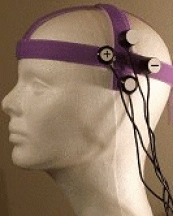
- In 2005, the FDA approved the use of Vagus
Nerve Stimulation (VNS) for depression. This FDA approval could be
summarized this way, "We have no idea if VNS works, but since it
doesn't kill people, you can experiment on live guinea pigs who are
otherwise unresponsive to any other treatment for depression. FDA approval
opened the door for a large scale "clinical trial" of an
unproven treatment. VNS is a form of ECT that shocks the brain with up to
12 volts through an electrode wrapped around the vagus nerve in the neck.
The nervous system is more like a network cable between the body and the
brain. Applying random shocks of electricity to the vagus nerve is
destructive and interferes with normal brain function. The nervous system
runs on a natural voltage of about 1/10th of a volt. VNS shocks the vagus
nerve up to 12 volts, which is 120x the normal voltage the brain uses.
Experts admit that the procedure is both experimental and unproven: "Not curative (depression)-Physicians should warn
patients that VNS Therapy has not been determined
to be a cure for depression." (Introduction to the VNS
Therapy, Warnings, and Precautions, Cyberonics inc, Dec 2008, p8) Chemical
psychiatry has a long and misguided history of looking to the brain as
the etiology of insanity and depression. Chemical
psychiatrists reject the Bible's teaching that man has a spirit that
consciously survives the death of the brain. They wrongly view the
emotions of man as a machine-like response to chemicals and neurons in the
brain. The theory behind VNS is pure junk science: "The pulses that
are delivered to the left vagus nerve are transmitted to the central
nervous system, and they go to specific areas in the central nervous
system that control mood, motivation, sleep,
appetite, and other symptoms that are relevant to depression."
(A. John Rush, MD, Vice Chair, Department of Clinical Sciences Professor,
Department of Psychiatry University of Texas) The problem with this
theory, is that nerves do not control or even communicate mood or
motivation. Nerves transmit commands for muscle movement and sensory
information like touch, pain etc. While muscle pain transmitted through
nerves to the brain can clearly affect the mood of the spirit, they do not
create for control mood or motivation. Mood and motivation has its origin
in the spirit, not the body. Obviously, when you apply raw electricity to
a digital electrical communication system (human nervous system) it is
going to damage and interfere with normal function of the body. Sleep
apnea, where you stop breathing for a few seconds while sleeping is a
known dangerous side effect of this stupid treatment. Other known side
effects include: actual a change in tonal speech sound, pharyngitis and
shore throats, larengitis-like hoarseness and coughing, Neck pain,
Difficulty swallowing, Tingling or prickling of the skin. All the side
effects interfere with physical tissues near the location of the shocks to
the vagus nerve. This rather interference with normal bodily function is
easily predicable. (More: Vagus
Nerve Stimulation)
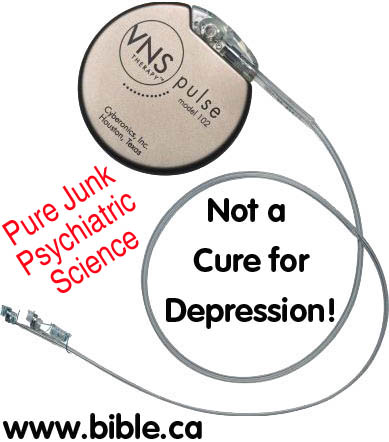
- In 2009, Deep
brain stimulation (DBS) was approved by the FDA to treat Obsessive-compulsive
disorder (OCD). This FDA approval could be summarized this way, "We
have no idea if DBS works, but since it doesn't kill people, you can
experiment on live guinea pigs who are otherwise unresponsive to any other
treatment for OCD. FDA approval opened the door for a large scale
"clinical trial" of an unproven treatment. DBS is a form of ECT
that shocks the brain with 5-10.5 volts through two 6 inch steel probes,
that look like meat thermometers, which are pressed deep into the center
of the brain. Although it is called a "Pacemaker of the Brain",
such a comparison with an organ like the heart is absurd. A pacemaker
keeps the heart beating in timing to the frequency of shocks applied to
the heart. The heart naturally responds to such shocks of electricity. The
brain, is more like a network cable between the body and the spirit.
Applying random shocks of electricity to the brain is destructive and
interferes with normal brain function. The brain runs on a natural voltage
of about 1/10th of a volt. DBS shocks the brain with up to 10.5 volts,
which is 100x the normal voltage the brain uses. Experts admit that the
procedure is both experimental and unproven: "The effectiveness of this device (DBS) for this use (ODC) has not
been demonstrated." (Neurostimulators for Psychiatric
Disorders, Get the Facts, Medtronic inc.) "The long-term safety and effectiveness of brain stimulation therapy for
obsessive compulsive disorder has not been
established." (DBS Therapy For OCD, Implant manual, Lead Kit
For Deep Brain Stimulation, Medtronic inc., 2009 AD, p 13) Since chemical
psychiatrists are atheists who belief in evolution, they view man as
nothing more than a pile of chemicals and electrons. They openly mock
Christians who view the nature of man is dichotomous, having a distinct
body and soul. This error has "dead ended" psychiatric research
into insanity. They have wrongly look to the physical brain as the
etiological cause of insanity for 300 years. Insanity happens in the
spirit, not the body. A tiny clinical trial of 26 patients with ODC,
demonstrated that the DBS implant actually increased
OCD symptoms in 46.2% of the 26 patients. Any reported improvements
could easily be accounted for through placebo effect. In 25 years, DBS
will be put on the shelf beside all the other failed psychiatric
treatments for insanity. (More: Deep
brain stimulation)
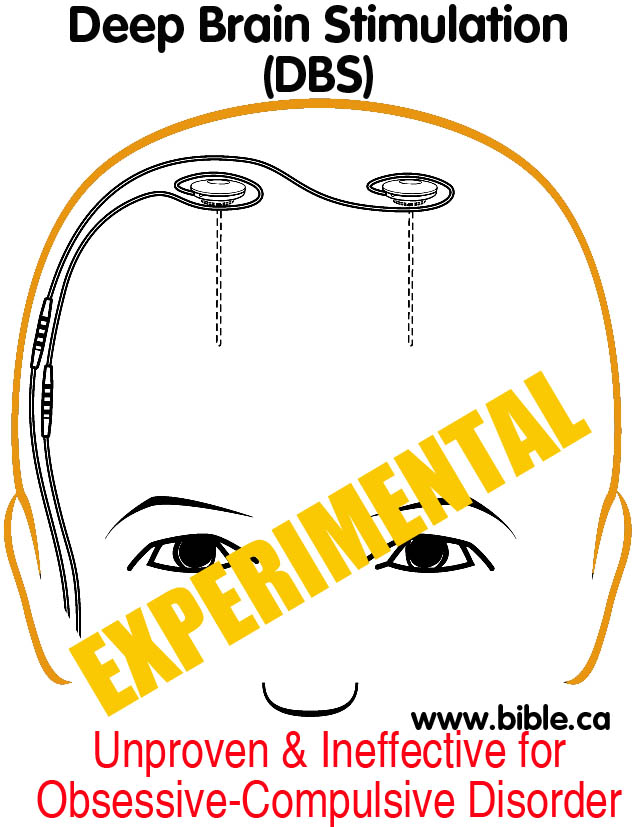
2013 AD: Psychiatrists finally discover the biological cause of insanity!
By Steve Rudd: Contact the author for comments, input or corrections.
Send us your story about your experience with modern Psychiatry


